EXHIBIT 99.2
Published on August 4, 2020

Exhibit 99.2 ITEM 7 – MANAGEMENT’S DISCUSSION AND ANALYSIS OF FINANCIAL CONDITION AND RESULTS OF CONTINUING OPERATIONS (MD&A) The information contained herein updates selected sections of Management's Discussion and Analysis of Financial Condition and Results of Operations as previously presented in Item 7 of Part II of PNC's 2019 Form 10-K. As more fully described in Item 8.01 of this Current Report on Form 8-K, sections of the 2019 Form 10-K are being updated to reflect the presentation of historical results to reflect the results of BlackRock as discontinued operations. The following sections in Item 7 of Part II of the 2019 Form 10-K are updated as previously presented: • Executive Summary • Consolidated Income Statement Review • Consolidated Balance Sheet Review • Business Segment Review • Liquidity Risk Management EXECUTIVE SUMMARY Key Strategic Goals At PNC we manage our company for the long term. We are focused on the fundamentals of growing customers, loans, deposits and revenue and improving profitability, while investing for the future and managing risk, expenses and capital. We continue to invest in our products, markets and brand, and embrace our commitments to our customers, shareholders, employees and the communities where we do business. We strive to expand and deepen customer relationships by offering a broad range of deposit, credit and fee-based products and services. We are focused on delivering those products and services to our customers with the goal of addressing their financial objectives and putting customers’ needs first. Our business model is built on customer loyalty and engagement, understanding our customers’ financial goals and offering our diverse products and services to help them achieve financial well-being. Our approach is concentrated on organically growing and deepening client relationships across our businesses that meet our risk/return measures. We are focused on our strategic priorities, which are designed to enhance value over the long term, and consist of: • Expanding our leading banking franchise to new markets and digital platforms; • Deepening customer relationships by delivering a superior banking experience and financial solutions; and • Leveraging technology to innovate and enhance products, services, security and processes. Our capital priorities are to support client growth and business investment, maintain appropriate capital in light of economic conditions, the Basel III framework and other regulatory expectations, and return excess capital to shareholders. For more detail, see the Capital Highlights portion of this Executive Summary and the Liquidity and Capital Management portion of the Risk Management section of this Item 7 and the Supervision and Regulation section in Item 1 Business of this Report. Key Factors Affecting Financial Performance We face a variety of risks that may impact various aspects of our risk profile from time to time. The extent of such impacts may vary depending on factors such as the current business and economic conditions, political and regulatory environment and operational challenges. Many of these risks and our risk management strategies are described in more detail elsewhere in this Report. Our financial performance is substantially affected by a number of external factors outside of our control, including the following: • Global and domestic economic conditions, including the continuity and stamina of the current U.S. economic expansion; • The monetary policy actions and statements of the Federal Reserve and the Federal Open Market Committee (FOMC); • The level of, and direction, timing and magnitude of movement in, interest rates and the shape of the interest rate yield curve; • The functioning and other performance of, and availability of liquidity in, U.S. and global financial markets, including capital markets; • The impact of tariffs and other trade policies of the U.S. and its global trading partners; • Changes in the competitive and regulatory landscape; • The impact of legislative, regulatory and administrative initiatives and actions; • The impact of market credit spreads on asset valuations; • The ability of customers, counterparties and issuers to perform in accordance with contractual terms, and the resulting impact on our asset quality; • Loan demand, utilization of credit commitments and standby letters of credit; and • The impact on customers and changes in customer behavior due to changing business and economic conditions or regulatory or legislative initiatives.
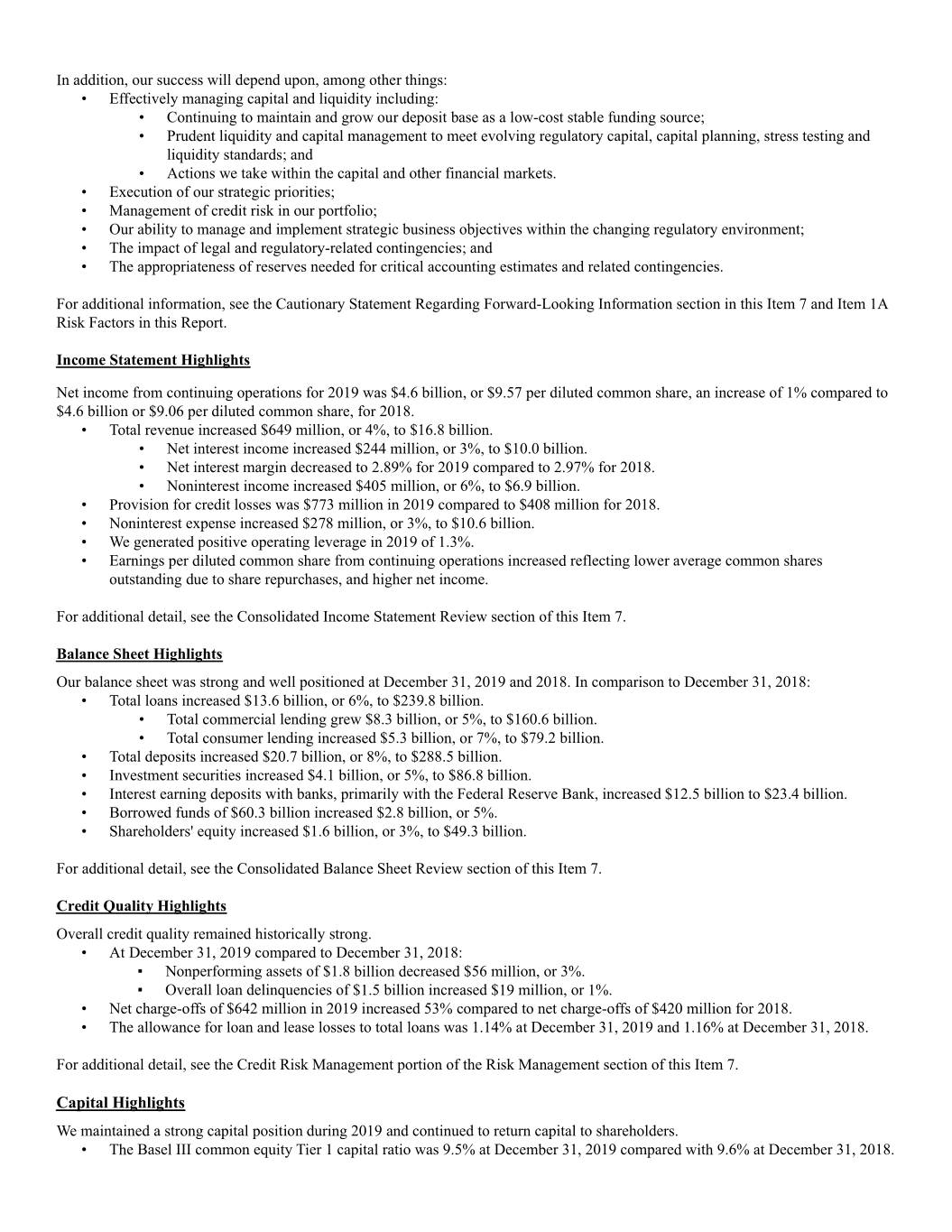
In addition, our success will depend upon, among other things: • Effectively managing capital and liquidity including: • Continuing to maintain and grow our deposit base as a low-cost stable funding source; • Prudent liquidity and capital management to meet evolving regulatory capital, capital planning, stress testing and liquidity standards; and • Actions we take within the capital and other financial markets. • Execution of our strategic priorities; • Management of credit risk in our portfolio; • Our ability to manage and implement strategic business objectives within the changing regulatory environment; • The impact of legal and regulatory-related contingencies; and • The appropriateness of reserves needed for critical accounting estimates and related contingencies. For additional information, see the Cautionary Statement Regarding Forward-Looking Information section in this Item 7 and Item 1A Risk Factors in this Report. Income Statement Highlights Net income from continuing operations for 2019 was $4.6 billion, or $9.57 per diluted common share, an increase of 1% compared to $4.6 billion or $9.06 per diluted common share, for 2018. • Total revenue increased $649 million, or 4%, to $16.8 billion. • Net interest income increased $244 million, or 3%, to $10.0 billion. • Net interest margin decreased to 2.89% for 2019 compared to 2.97% for 2018. • Noninterest income increased $405 million, or 6%, to $6.9 billion. • Provision for credit losses was $773 million in 2019 compared to $408 million for 2018. • Noninterest expense increased $278 million, or 3%, to $10.6 billion. • We generated positive operating leverage in 2019 of 1.3%. • Earnings per diluted common share from continuing operations increased reflecting lower average common shares outstanding due to share repurchases, and higher net income. For additional detail, see the Consolidated Income Statement Review section of this Item 7. Balance Sheet Highlights Our balance sheet was strong and well positioned at December 31, 2019 and 2018. In comparison to December 31, 2018: • Total loans increased $13.6 billion, or 6%, to $239.8 billion. • Total commercial lending grew $8.3 billion, or 5%, to $160.6 billion. • Total consumer lending increased $5.3 billion, or 7%, to $79.2 billion. • Total deposits increased $20.7 billion, or 8%, to $288.5 billion. • Investment securities increased $4.1 billion, or 5%, to $86.8 billion. • Interest earning deposits with banks, primarily with the Federal Reserve Bank, increased $12.5 billion to $23.4 billion. • Borrowed funds of $60.3 billion increased $2.8 billion, or 5%. • Shareholders' equity increased $1.6 billion, or 3%, to $49.3 billion. For additional detail, see the Consolidated Balance Sheet Review section of this Item 7. Credit Quality Highlights Overall credit quality remained historically strong. • At December 31, 2019 compared to December 31, 2018: Nonperforming assets of $1.8 billion decreased $56 million, or 3%. Overall loan delinquencies of $1.5 billion increased $19 million, or 1%. • Net charge-offs of $642 million in 2019 increased 53% compared to net charge-offs of $420 million for 2018. • The allowance for loan and lease losses to total loans was 1.14% at December 31, 2019 and 1.16% at December 31, 2018. For additional detail, see the Credit Risk Management portion of the Risk Management section of this Item 7. Capital Highlights We maintained a strong capital position during 2019 and continued to return capital to shareholders. • The Basel III common equity Tier 1 capital ratio was 9.5% at December 31, 2019 compared with 9.6% at December 31, 2018.

• In 2019, we returned $5.4 billion of capital to shareholders through repurchases of 25.9 million common shares for $3.5 billion and dividends on common shares of $1.9 billion. • In June 2019, we announced share repurchase programs of up to $4.3 billion for the four quarter period beginning with the third quarter of 2019. In January 2020, we announced an increase to these programs of up to $1.0 billion in additional common share repurchases through the end of second quarter of 2020. • The quarterly cash dividend on common stock was increased from $.95 to $1.15 per share effective with the August 5, 2019 dividend payment date. Our ability to take certain capital actions, including plans to pay or increase common stock dividends or to repurchase shares under current or future programs, is subject to the results of the supervisory assessment of capital adequacy undertaken by the Federal Reserve as part of the Comprehensive Capital Analysis and Review (CCAR) process. For additional information, see the Supervision and Regulation section in Item 1 Business of this Report. See the Liquidity and Capital Management portion of the Risk Management section of this Item 7 for more detail on our 2019 capital and liquidity actions as well as our capital ratios. CONSOLIDATED INCOME STATEMENT REVIEW Our Consolidated Income Statement is presented in Item 8 of this Report. For additional detail of the comparison of 2018 over 2017, see the 2018 Compared to 2017 section of this Income Statement Review and Item 7 of our 2018 Form 10-K. Net income from continuing operations for 2019 was $4.6 billion, or $9.57 per diluted common share, an increase of 1% compared to $4.6 billion, or $9.06 per diluted common share, for 2018. The increase was driven by higher noninterest income and net interest income, partially offset by increases in provision for credit losses and noninterest expense. Net Interest Income Table 1: Summarized Average Balances and Net Interest Income (a) 2019 2018 Average Interest Average Interest Year ended December 31 Average Yields/ Income/ Average Yields/ Income/ Dollars in millions Balances Rates Expense Balances Rates Expense Assets Interest-earning assets Investment securities $ 83,666 2.93% $ 2,450 $ 78,784 2.91% $ 2,289 Loans 235,016 4.51% 10,604 223,278 4.33% 9,667 Interest-earning deposits with banks 16,878 2.09% 353 20,603 1.84% 379 Other 12,425 3.69% 458 8,093 4.47% 362 Total interest-earning assets/interest income $ 347,985 3.98% 13,865 $ 330,758 3.84% 12,697 Liabilities Interest-bearing liabilities Interest-bearing deposits $ 204,588 .97% 1,986 $ 186,361 .66% 1,229 Borrowed funds 61,528 2.94% 1,811 59,306 2.75% 1,632 Total interest-bearing liabilities/interest expense $ 266,116 1.43% 3,797 $ 245,667 1.16% 2,861 Net interest income/margin (Non-GAAP) 2.89% 10,068 2.97% 9,836 Taxable-equivalent adjustments (103) (115) Net interest income (GAAP) $ 9,965 $ 9,721 (a) Interest income calculated as taxable-equivalent interest income. To provide more meaningful comparisons of interest income and yields for all interest-earning assets, as well as net interest margins, we use interest income on a taxable-equivalent basis in calculating average yields and net interest margins by increasing the interest income earned on tax-exempt assets to make it fully equivalent to interest income earned on taxable investments. This adjustment is not permitted under GAAP on the Consolidated Income Statement. For more information, see Reconciliation of Taxable-Equivalent Net Interest Income (Non-GAAP) in the Statistical Information (Unaudited) section in Item 8 of this Report. Changes in net interest income and margin result from the interaction of the volume and composition of interest-earning assets and related yields, interest-bearing liabilities and related rates paid, and noninterest-bearing sources of funding. See the Statistical Information (Unaudited) – Average Consolidated Balance Sheet And Net Interest Analysis and Analysis Of Year-To-Year Changes In Net Interest Income in Item 8 of this Report. Net interest income increased $244 million, or 3%, in 2019 compared with 2018 as higher loan and securities yields and balances were partially offset by higher funding costs. Net interest margin of 2.89% decreased 8 basis points in 2019 compared to 2018, driven by the declining rate environment in 2019.
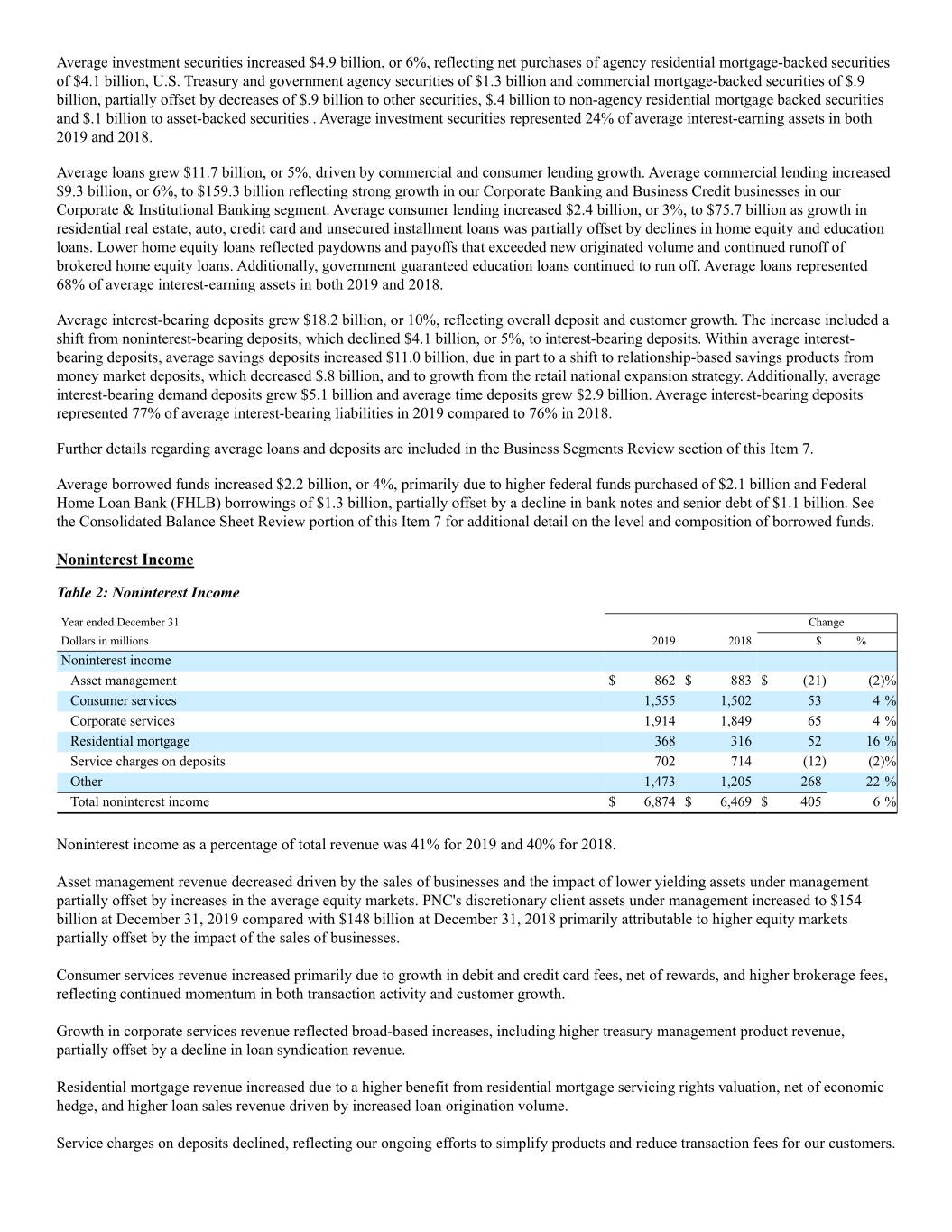
Average investment securities increased $4.9 billion, or 6%, reflecting net purchases of agency residential mortgage-backed securities of $4.1 billion, U.S. Treasury and government agency securities of $1.3 billion and commercial mortgage-backed securities of $.9 billion, partially offset by decreases of $.9 billion to other securities, $.4 billion to non-agency residential mortgage backed securities and $.1 billion to asset-backed securities . Average investment securities represented 24% of average interest-earning assets in both 2019 and 2018. Average loans grew $11.7 billion, or 5%, driven by commercial and consumer lending growth. Average commercial lending increased $9.3 billion, or 6%, to $159.3 billion reflecting strong growth in our Corporate Banking and Business Credit businesses in our Corporate & Institutional Banking segment. Average consumer lending increased $2.4 billion, or 3%, to $75.7 billion as growth in residential real estate, auto, credit card and unsecured installment loans was partially offset by declines in home equity and education loans. Lower home equity loans reflected paydowns and payoffs that exceeded new originated volume and continued runoff of brokered home equity loans. Additionally, government guaranteed education loans continued to run off. Average loans represented 68% of average interest-earning assets in both 2019 and 2018. Average interest-bearing deposits grew $18.2 billion, or 10%, reflecting overall deposit and customer growth. The increase included a shift from noninterest-bearing deposits, which declined $4.1 billion, or 5%, to interest-bearing deposits. Within average interest- bearing deposits, average savings deposits increased $11.0 billion, due in part to a shift to relationship-based savings products from money market deposits, which decreased $.8 billion, and to growth from the retail national expansion strategy. Additionally, average interest-bearing demand deposits grew $5.1 billion and average time deposits grew $2.9 billion. Average interest-bearing deposits represented 77% of average interest-bearing liabilities in 2019 compared to 76% in 2018. Further details regarding average loans and deposits are included in the Business Segments Review section of this Item 7. Average borrowed funds increased $2.2 billion, or 4%, primarily due to higher federal funds purchased of $2.1 billion and Federal Home Loan Bank (FHLB) borrowings of $1.3 billion, partially offset by a decline in bank notes and senior debt of $1.1 billion. See the Consolidated Balance Sheet Review portion of this Item 7 for additional detail on the level and composition of borrowed funds. Noninterest Income Table 2: Noninterest Income Year ended December 31 Change Dollars in millions 2019 2018 $ % Noninterest income Asset management $ 862 $ 883 $ (21) (2)% Consumer services 1,555 1,502 53 4 % Corporate services 1,914 1,849 65 4 % Residential mortgage 368 316 52 16 % Service charges on deposits 702 714 (12) (2)% Other 1,473 1,205 268 22 % Total noninterest income $ 6,874 $ 6,469 $ 405 6 % Noninterest income as a percentage of total revenue was 41% for 2019 and 40% for 2018. Asset management revenue decreased driven by the sales of businesses and the impact of lower yielding assets under management partially offset by increases in the average equity markets. PNC's discretionary client assets under management increased to $154 billion at December 31, 2019 compared with $148 billion at December 31, 2018 primarily attributable to higher equity markets partially offset by the impact of the sales of businesses. Consumer services revenue increased primarily due to growth in debit and credit card fees, net of rewards, and higher brokerage fees, reflecting continued momentum in both transaction activity and customer growth. Growth in corporate services revenue reflected broad-based increases, including higher treasury management product revenue, partially offset by a decline in loan syndication revenue. Residential mortgage revenue increased due to a higher benefit from residential mortgage servicing rights valuation, net of economic hedge, and higher loan sales revenue driven by increased loan origination volume. Service charges on deposits declined, reflecting our ongoing efforts to simplify products and reduce transaction fees for our customers.
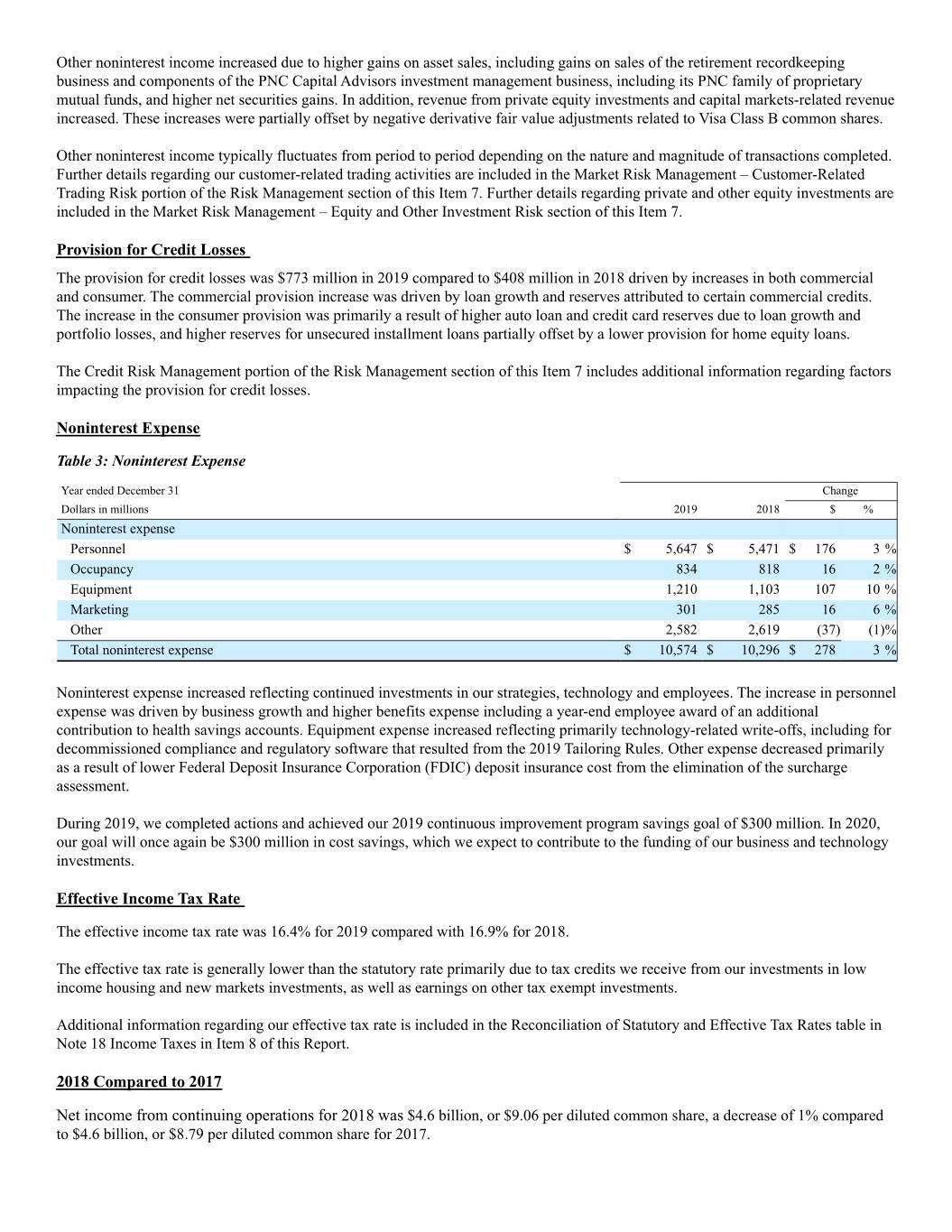
Other noninterest income increased due to higher gains on asset sales, including gains on sales of the retirement recordkeeping business and components of the PNC Capital Advisors investment management business, including its PNC family of proprietary mutual funds, and higher net securities gains. In addition, revenue from private equity investments and capital markets-related revenue increased. These increases were partially offset by negative derivative fair value adjustments related to Visa Class B common shares. Other noninterest income typically fluctuates from period to period depending on the nature and magnitude of transactions completed. Further details regarding our customer-related trading activities are included in the Market Risk Management – Customer-Related Trading Risk portion of the Risk Management section of this Item 7. Further details regarding private and other equity investments are included in the Market Risk Management – Equity and Other Investment Risk section of this Item 7. Provision for Credit Losses The provision for credit losses was $773 million in 2019 compared to $408 million in 2018 driven by increases in both commercial and consumer. The commercial provision increase was driven by loan growth and reserves attributed to certain commercial credits. The increase in the consumer provision was primarily a result of higher auto loan and credit card reserves due to loan growth and portfolio losses, and higher reserves for unsecured installment loans partially offset by a lower provision for home equity loans. The Credit Risk Management portion of the Risk Management section of this Item 7 includes additional information regarding factors impacting the provision for credit losses. Noninterest Expense Table 3: Noninterest Expense Year ended December 31 Change Dollars in millions 2019 2018 $ % Noninterest expense Personnel $ 5,647 $ 5,471 $ 176 3 % Occupancy 834 818 16 2 % Equipment 1,210 1,103 107 10 % Marketing 301 285 16 6 % Other 2,582 2,619 (37) (1)% Total noninterest expense $ 10,574 $ 10,296 $ 278 3 % Noninterest expense increased reflecting continued investments in our strategies, technology and employees. The increase in personnel expense was driven by business growth and higher benefits expense including a year-end employee award of an additional contribution to health savings accounts. Equipment expense increased reflecting primarily technology-related write-offs, including for decommissioned compliance and regulatory software that resulted from the 2019 Tailoring Rules. Other expense decreased primarily as a result of lower Federal Deposit Insurance Corporation (FDIC) deposit insurance cost from the elimination of the surcharge assessment. During 2019, we completed actions and achieved our 2019 continuous improvement program savings goal of $300 million. In 2020, our goal will once again be $300 million in cost savings, which we expect to contribute to the funding of our business and technology investments. Effective Income Tax Rate The effective income tax rate was 16.4% for 2019 compared with 16.9% for 2018. The effective tax rate is generally lower than the statutory rate primarily due to tax credits we receive from our investments in low income housing and new markets investments, as well as earnings on other tax exempt investments. Additional information regarding our effective tax rate is included in the Reconciliation of Statutory and Effective Tax Rates table in Note 18 Income Taxes in Item 8 of this Report. 2018 Compared to 2017 Net income from continuing operations for 2018 was $4.6 billion, or $9.06 per diluted common share, a decrease of 1% compared to $4.6 billion, or $8.79 per diluted common share for 2017.
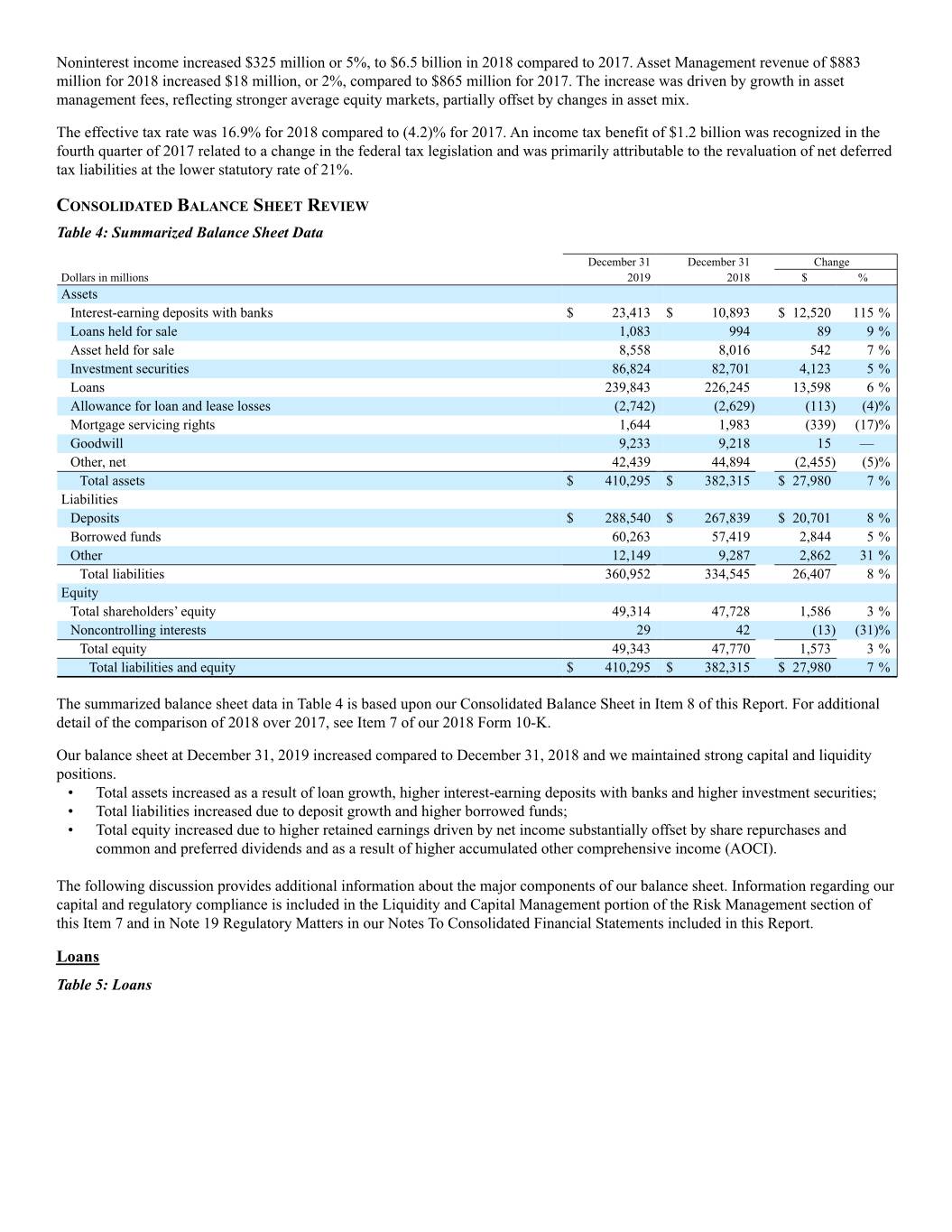
Noninterest income increased $325 million or 5%, to $6.5 billion in 2018 compared to 2017. Asset Management revenue of $883 million for 2018 increased $18 million, or 2%, compared to $865 million for 2017. The increase was driven by growth in asset management fees, reflecting stronger average equity markets, partially offset by changes in asset mix. The effective tax rate was 16.9% for 2018 compared to (4.2)% for 2017. An income tax benefit of $1.2 billion was recognized in the fourth quarter of 2017 related to a change in the federal tax legislation and was primarily attributable to the revaluation of net deferred tax liabilities at the lower statutory rate of 21%. CONSOLIDATED BALANCE SHEET REVIEW Table 4: Summarized Balance Sheet Data December 31 December 31 Change Dollars in millions 2019 2018 $ % Assets Interest-earning deposits with banks $ 23,413 $ 10,893 $ 12,520 115 % Loans held for sale 1,083 994 89 9 % Asset held for sale 8,558 8,016 542 7 % Investment securities 86,824 82,701 4,123 5 % Loans 239,843 226,245 13,598 6 % Allowance for loan and lease losses (2,742) (2,629) (113) (4)% Mortgage servicing rights 1,644 1,983 (339) (17)% Goodwill 9,233 9,218 15 — Other, net 42,439 44,894 (2,455) (5)% Total assets $ 410,295 $ 382,315 $ 27,980 7 % Liabilities Deposits $ 288,540 $ 267,839 $ 20,701 8 % Borrowed funds 60,263 57,419 2,844 5 % Other 12,149 9,287 2,862 31 % Total liabilities 360,952 334,545 26,407 8 % Equity Total shareholders’ equity 49,314 47,728 1,586 3 % Noncontrolling interests 29 42 (13) (31)% Total equity 49,343 47,770 1,573 3 % Total liabilities and equity $ 410,295 $ 382,315 $ 27,980 7 % The summarized balance sheet data in Table 4 is based upon our Consolidated Balance Sheet in Item 8 of this Report. For additional detail of the comparison of 2018 over 2017, see Item 7 of our 2018 Form 10-K. Our balance sheet at December 31, 2019 increased compared to December 31, 2018 and we maintained strong capital and liquidity positions. • Total assets increased as a result of loan growth, higher interest-earning deposits with banks and higher investment securities; • Total liabilities increased due to deposit growth and higher borrowed funds; • Total equity increased due to higher retained earnings driven by net income substantially offset by share repurchases and common and preferred dividends and as a result of higher accumulated other comprehensive income (AOCI). The following discussion provides additional information about the major components of our balance sheet. Information regarding our capital and regulatory compliance is included in the Liquidity and Capital Management portion of the Risk Management section of this Item 7 and in Note 19 Regulatory Matters in our Notes To Consolidated Financial Statements included in this Report. Loans Table 5: Loans
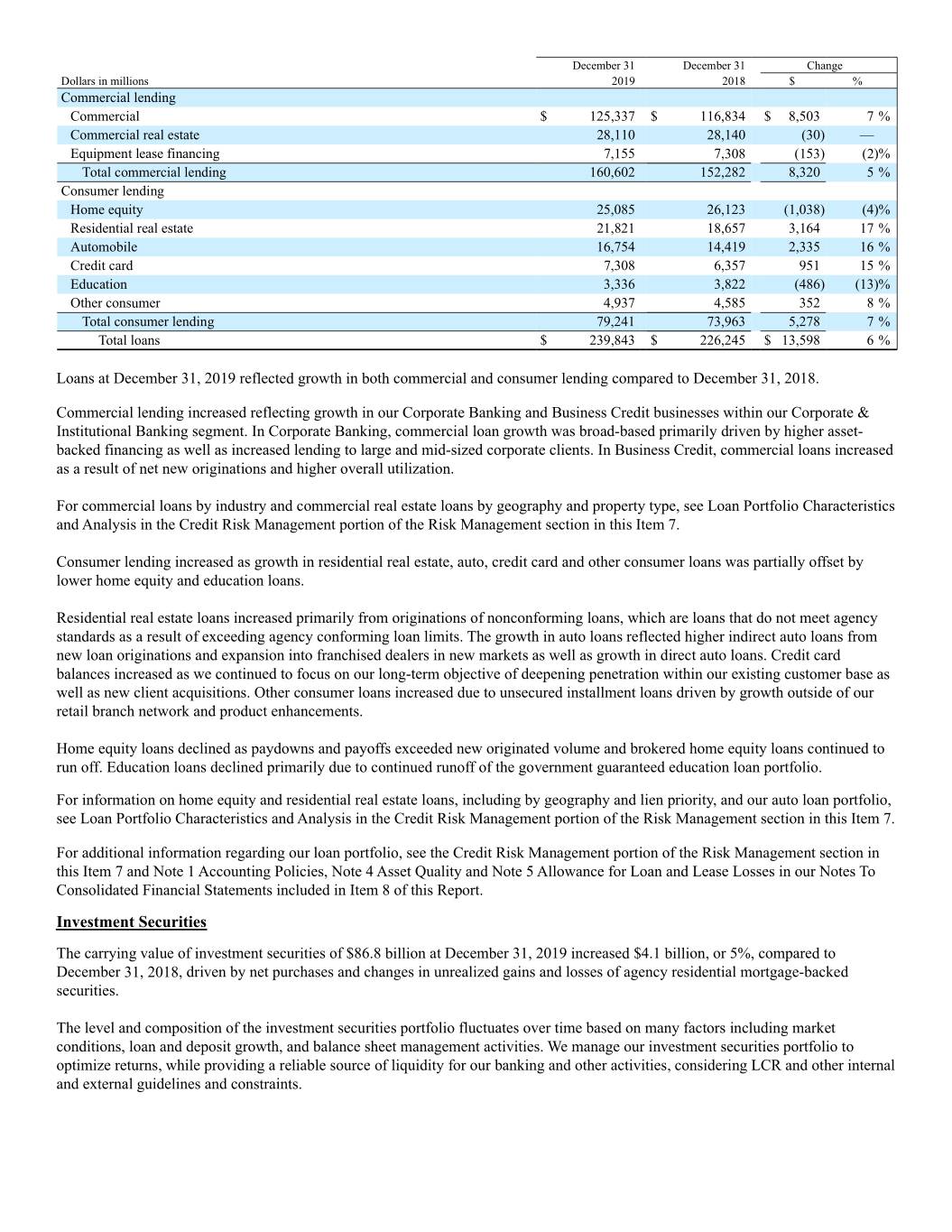
December 31 December 31 Change Dollars in millions 2019 2018 $ % Commercial lending Commercial $ 125,337 $ 116,834 $ 8,503 7 % Commercial real estate 28,110 28,140 (30) — Equipment lease financing 7,155 7,308 (153) (2)% Total commercial lending 160,602 152,282 8,320 5 % Consumer lending Home equity 25,085 26,123 (1,038) (4)% Residential real estate 21,821 18,657 3,164 17 % Automobile 16,754 14,419 2,335 16 % Credit card 7,308 6,357 951 15 % Education 3,336 3,822 (486) (13)% Other consumer 4,937 4,585 352 8 % Total consumer lending 79,241 73,963 5,278 7 % Total loans $ 239,843 $ 226,245 $ 13,598 6 % Loans at December 31, 2019 reflected growth in both commercial and consumer lending compared to December 31, 2018. Commercial lending increased reflecting growth in our Corporate Banking and Business Credit businesses within our Corporate & Institutional Banking segment. In Corporate Banking, commercial loan growth was broad-based primarily driven by higher asset- backed financing as well as increased lending to large and mid-sized corporate clients. In Business Credit, commercial loans increased as a result of net new originations and higher overall utilization. For commercial loans by industry and commercial real estate loans by geography and property type, see Loan Portfolio Characteristics and Analysis in the Credit Risk Management portion of the Risk Management section in this Item 7. Consumer lending increased as growth in residential real estate, auto, credit card and other consumer loans was partially offset by lower home equity and education loans. Residential real estate loans increased primarily from originations of nonconforming loans, which are loans that do not meet agency standards as a result of exceeding agency conforming loan limits. The growth in auto loans reflected higher indirect auto loans from new loan originations and expansion into franchised dealers in new markets as well as growth in direct auto loans. Credit card balances increased as we continued to focus on our long-term objective of deepening penetration within our existing customer base as well as new client acquisitions. Other consumer loans increased due to unsecured installment loans driven by growth outside of our retail branch network and product enhancements. Home equity loans declined as paydowns and payoffs exceeded new originated volume and brokered home equity loans continued to run off. Education loans declined primarily due to continued runoff of the government guaranteed education loan portfolio. For information on home equity and residential real estate loans, including by geography and lien priority, and our auto loan portfolio, see Loan Portfolio Characteristics and Analysis in the Credit Risk Management portion of the Risk Management section in this Item 7. For additional information regarding our loan portfolio, see the Credit Risk Management portion of the Risk Management section in this Item 7 and Note 1 Accounting Policies, Note 4 Asset Quality and Note 5 Allowance for Loan and Lease Losses in our Notes To Consolidated Financial Statements included in Item 8 of this Report. Investment Securities The carrying value of investment securities of $86.8 billion at December 31, 2019 increased $4.1 billion, or 5%, compared to December 31, 2018, driven by net purchases and changes in unrealized gains and losses of agency residential mortgage-backed securities. The level and composition of the investment securities portfolio fluctuates over time based on many factors including market conditions, loan and deposit growth, and balance sheet management activities. We manage our investment securities portfolio to optimize returns, while providing a reliable source of liquidity for our banking and other activities, considering LCR and other internal and external guidelines and constraints.
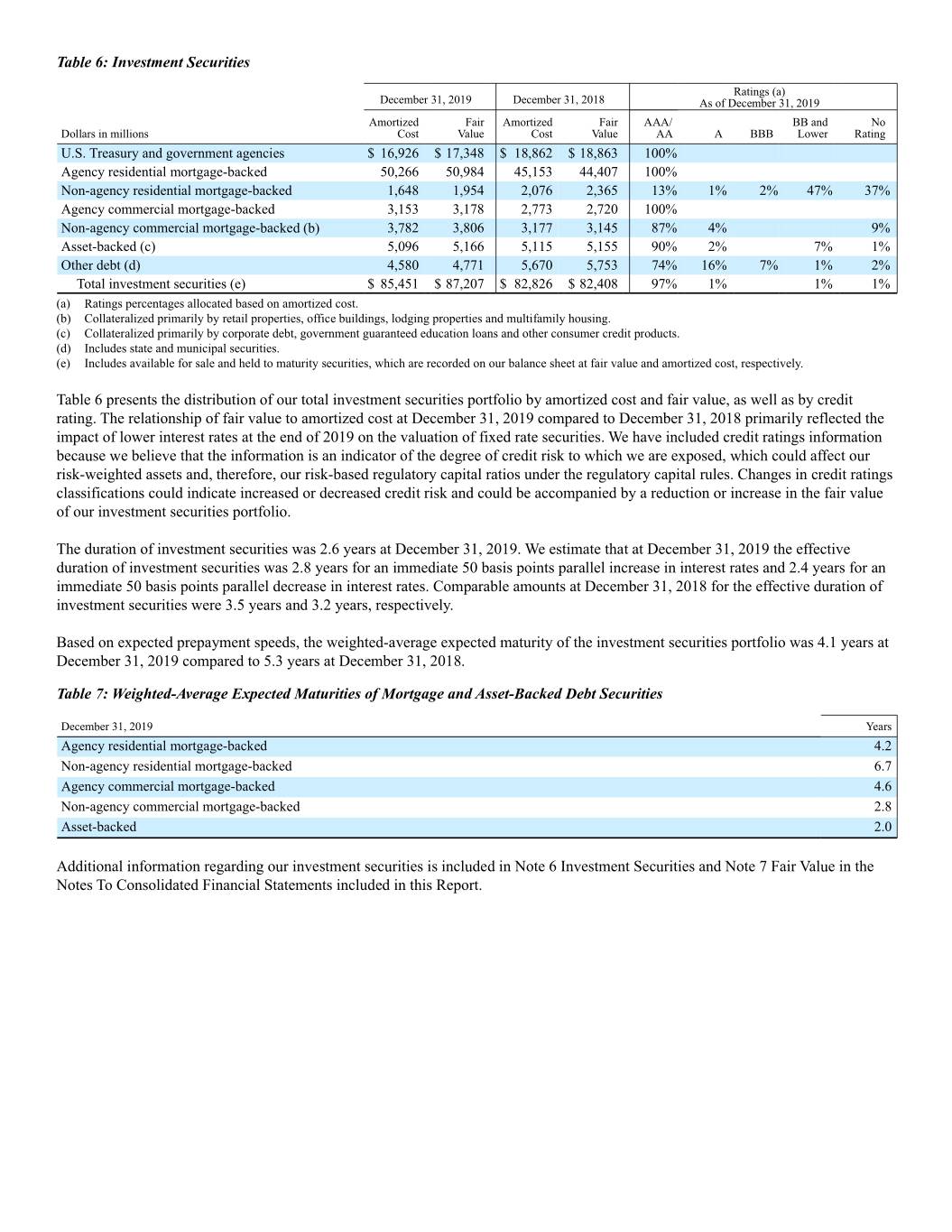
Table 6: Investment Securities Ratings (a) December 31, 2019 December 31, 2018 As of December 31, 2019 Amortized Fair Amortized Fair AAA/ BB and No Dollars in millions Cost Value Cost Value AA A BBB Lower Rating U.S. Treasury and government agencies $ 16,926 $ 17,348 $ 18,862 $ 18,863 100% Agency residential mortgage-backed 50,266 50,984 45,153 44,407 100% Non-agency residential mortgage-backed 1,648 1,954 2,076 2,365 13% 1% 2% 47% 37% Agency commercial mortgage-backed 3,153 3,178 2,773 2,720 100% Non-agency commercial mortgage-backed (b) 3,782 3,806 3,177 3,145 87% 4% 9% Asset-backed (c) 5,096 5,166 5,115 5,155 90% 2% 7% 1% Other debt (d) 4,580 4,771 5,670 5,753 74% 16% 7% 1% 2% Total investment securities (e) $ 85,451 $ 87,207 $ 82,826 $ 82,408 97% 1% 1% 1% (a) Ratings percentages allocated based on amortized cost. (b) Collateralized primarily by retail properties, office buildings, lodging properties and multifamily housing. (c) Collateralized primarily by corporate debt, government guaranteed education loans and other consumer credit products. (d) Includes state and municipal securities. (e) Includes available for sale and held to maturity securities, which are recorded on our balance sheet at fair value and amortized cost, respectively. Table 6 presents the distribution of our total investment securities portfolio by amortized cost and fair value, as well as by credit rating. The relationship of fair value to amortized cost at December 31, 2019 compared to December 31, 2018 primarily reflected the impact of lower interest rates at the end of 2019 on the valuation of fixed rate securities. We have included credit ratings information because we believe that the information is an indicator of the degree of credit risk to which we are exposed, which could affect our risk-weighted assets and, therefore, our risk-based regulatory capital ratios under the regulatory capital rules. Changes in credit ratings classifications could indicate increased or decreased credit risk and could be accompanied by a reduction or increase in the fair value of our investment securities portfolio. The duration of investment securities was 2.6 years at December 31, 2019. We estimate that at December 31, 2019 the effective duration of investment securities was 2.8 years for an immediate 50 basis points parallel increase in interest rates and 2.4 years for an immediate 50 basis points parallel decrease in interest rates. Comparable amounts at December 31, 2018 for the effective duration of investment securities were 3.5 years and 3.2 years, respectively. Based on expected prepayment speeds, the weighted-average expected maturity of the investment securities portfolio was 4.1 years at December 31, 2019 compared to 5.3 years at December 31, 2018. Table 7: Weighted-Average Expected Maturities of Mortgage and Asset-Backed Debt Securities December 31, 2019 Years Agency residential mortgage-backed 4.2 Non-agency residential mortgage-backed 6.7 Agency commercial mortgage-backed 4.6 Non-agency commercial mortgage-backed 2.8 Asset-backed 2.0 Additional information regarding our investment securities is included in Note 6 Investment Securities and Note 7 Fair Value in the Notes To Consolidated Financial Statements included in this Report.
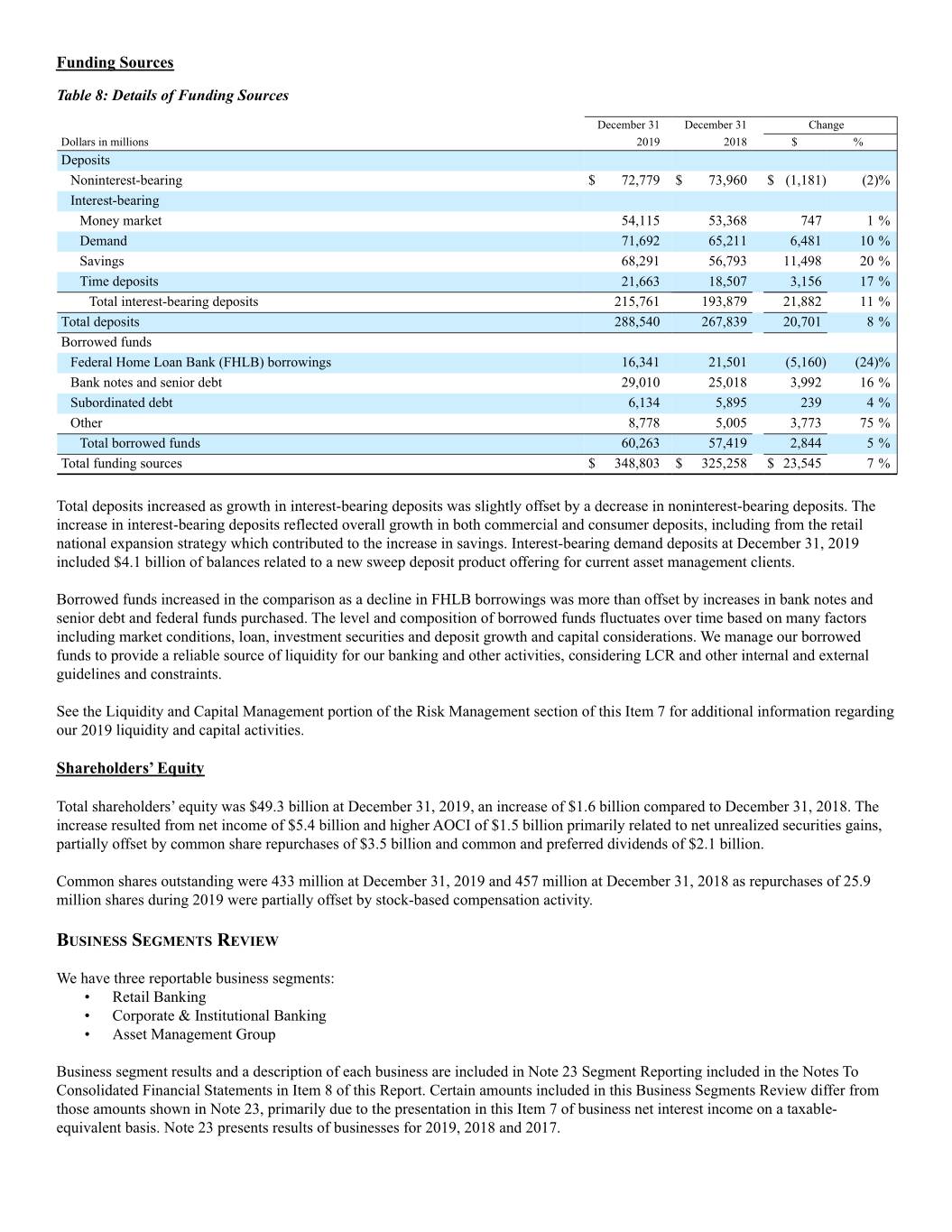
Funding Sources Table 8: Details of Funding Sources December 31 December 31 Change Dollars in millions 2019 2018 $ % Deposits Noninterest-bearing $ 72,779 $ 73,960 $ (1,181) (2)% Interest-bearing Money market 54,115 53,368 747 1 % Demand 71,692 65,211 6,481 10 % Savings 68,291 56,793 11,498 20 % Time deposits 21,663 18,507 3,156 17 % Total interest-bearing deposits 215,761 193,879 21,882 11 % Total deposits 288,540 267,839 20,701 8 % Borrowed funds Federal Home Loan Bank (FHLB) borrowings 16,341 21,501 (5,160) (24)% Bank notes and senior debt 29,010 25,018 3,992 16 % Subordinated debt 6,134 5,895 239 4 % Other 8,778 5,005 3,773 75 % Total borrowed funds 60,263 57,419 2,844 5 % Total funding sources $ 348,803 $ 325,258 $ 23,545 7 % Total deposits increased as growth in interest-bearing deposits was slightly offset by a decrease in noninterest-bearing deposits. The increase in interest-bearing deposits reflected overall growth in both commercial and consumer deposits, including from the retail national expansion strategy which contributed to the increase in savings. Interest-bearing demand deposits at December 31, 2019 included $4.1 billion of balances related to a new sweep deposit product offering for current asset management clients. Borrowed funds increased in the comparison as a decline in FHLB borrowings was more than offset by increases in bank notes and senior debt and federal funds purchased. The level and composition of borrowed funds fluctuates over time based on many factors including market conditions, loan, investment securities and deposit growth and capital considerations. We manage our borrowed funds to provide a reliable source of liquidity for our banking and other activities, considering LCR and other internal and external guidelines and constraints. See the Liquidity and Capital Management portion of the Risk Management section of this Item 7 for additional information regarding our 2019 liquidity and capital activities. Shareholders’ Equity Total shareholders’ equity was $49.3 billion at December 31, 2019, an increase of $1.6 billion compared to December 31, 2018. The increase resulted from net income of $5.4 billion and higher AOCI of $1.5 billion primarily related to net unrealized securities gains, partially offset by common share repurchases of $3.5 billion and common and preferred dividends of $2.1 billion. Common shares outstanding were 433 million at December 31, 2019 and 457 million at December 31, 2018 as repurchases of 25.9 million shares during 2019 were partially offset by stock-based compensation activity. BUSINESS SEGMENTS REVIEW We have three reportable business segments: • Retail Banking • Corporate & Institutional Banking • Asset Management Group Business segment results and a description of each business are included in Note 23 Segment Reporting included in the Notes To Consolidated Financial Statements in Item 8 of this Report. Certain amounts included in this Business Segments Review differ from those amounts shown in Note 23, primarily due to the presentation in this Item 7 of business net interest income on a taxable- equivalent basis. Note 23 presents results of businesses for 2019, 2018 and 2017.

Net interest income in business segment results reflects our internal funds transfer pricing methodology. Assets receive a funding charge and liabilities and capital receive a funding credit based on a transfer pricing methodology that incorporates product repricing characteristics, tenor and other factors. Total business segment financial results differ from total consolidated net income. The impact of these differences is reflected in the “Other” category as shown in Table 100 in Note 23 Segment Reporting in Item 8 of this Report. “Other” includes residual activities that do not meet the criteria for disclosure as a separate reportable business, such as asset and liability management activities including net securities gains or losses, other-than-temporary impairment of investment securities, certain trading activities, certain runoff consumer loan portfolios, private equity investments, intercompany eliminations, certain corporate overhead, tax adjustments that are not allocated to business segments, exited businesses, and differences between business segment performance reporting and financial statement reporting (GAAP), including the presentation of net income attributable to noncontrolling interests as the segments’ results exclude their portion of net income attributable to noncontrolling interests.

Retail Banking Retail Banking's core strategy is to acquire and retain customers who maintain their primary checking and transaction relationships with us. We seek to deepen relationships by meeting the broad range of our customers’ financial needs with savings, liquidity, lending, investment and retirement solutions. A strategic priority for us is to differentiate the customer experience and drive transformation and automation. A key element of our strategy is to expand the use of lower-cost alternative distribution channels, with an emphasis on digital capabilities, while continuing to optimize the traditional branch network. In addition, we have a disciplined process to continually improve the engagement of both our employees and customers, which is a strong driver of customer growth, retention and relationship expansion. In 2018, we launched our national expansion strategy designed to grow customers with digitally-led banking and an ultra-thin branch network in markets outside of our existing retail branch network and began offering our digital high yield savings deposit product and opened our first solution center. Solution centers are an emerging branch operating model with a distinctive physical layout, where routine transactions are supported through a combination of technology and skilled banker assistance to create personalized customer experiences. The primary focus of the solution center is to bring a community element to our digital banking capabilities. The solution center provides a collaborative environment that connects our customers with our digital solutions and services, beyond deposits and withdrawals. Table 9: Retail Banking Table (Unaudited) Year ended December 31 Change Dollars in millions, except as noted 2019 2018 $ % Income Statement Net interest income $ 5,520 $ 5,119 $ 401 8 % Noninterest income 2,648 2,631 17 1 % Total revenue 8,168 7,750 418 5 % Provision for credit losses 517 373 144 39 % Noninterest expense 6,061 5,978 83 1 % Pretax earnings 1,590 1,399 191 14 % Income taxes 377 335 42 13 % Earnings $ 1,213 $ 1,064 $ 149 14 % Average Balance Sheet Loans held for sale $ 627 $ 636 $ (9) (1)% Loans Consumer lending Home equity $ 22,657 $ 23,991 $ (1,334) (6)% Residential real estate 16,196 13,985 2,211 16 % Automobile 15,510 13,827 1,683 12 % Education 3,611 4,135 (524) (13)% Credit cards 6,550 5,838 712 12 % Other 2,244 1,843 401 22 % Total consumer lending 66,768 63,619 3,149 5 % Commercial and commercial real estate 10,410 10,383 27 — Total loans $ 77,178 $ 74,002 $ 3,176 4 % Total assets $ 92,959 $ 89,739 $ 3,220 4 % Deposits Noninterest-bearing demand $ 31,675 $ 30,670 $ 1,005 3 % Interest-bearing demand 42,077 42,042 35 — Money market 25,317 29,798 (4,481) (15)% Savings 56,722 47,019 9,703 21 % Certificates of deposit 12,613 12,007 606 5 % Total deposits $ 168,404 $ 161,536 $ 6,868 4 % Performance Ratios Return on average assets 1.30% 1.19% Noninterest income to total revenue 32% 34% Efficiency 74% 77% (continued on following page)
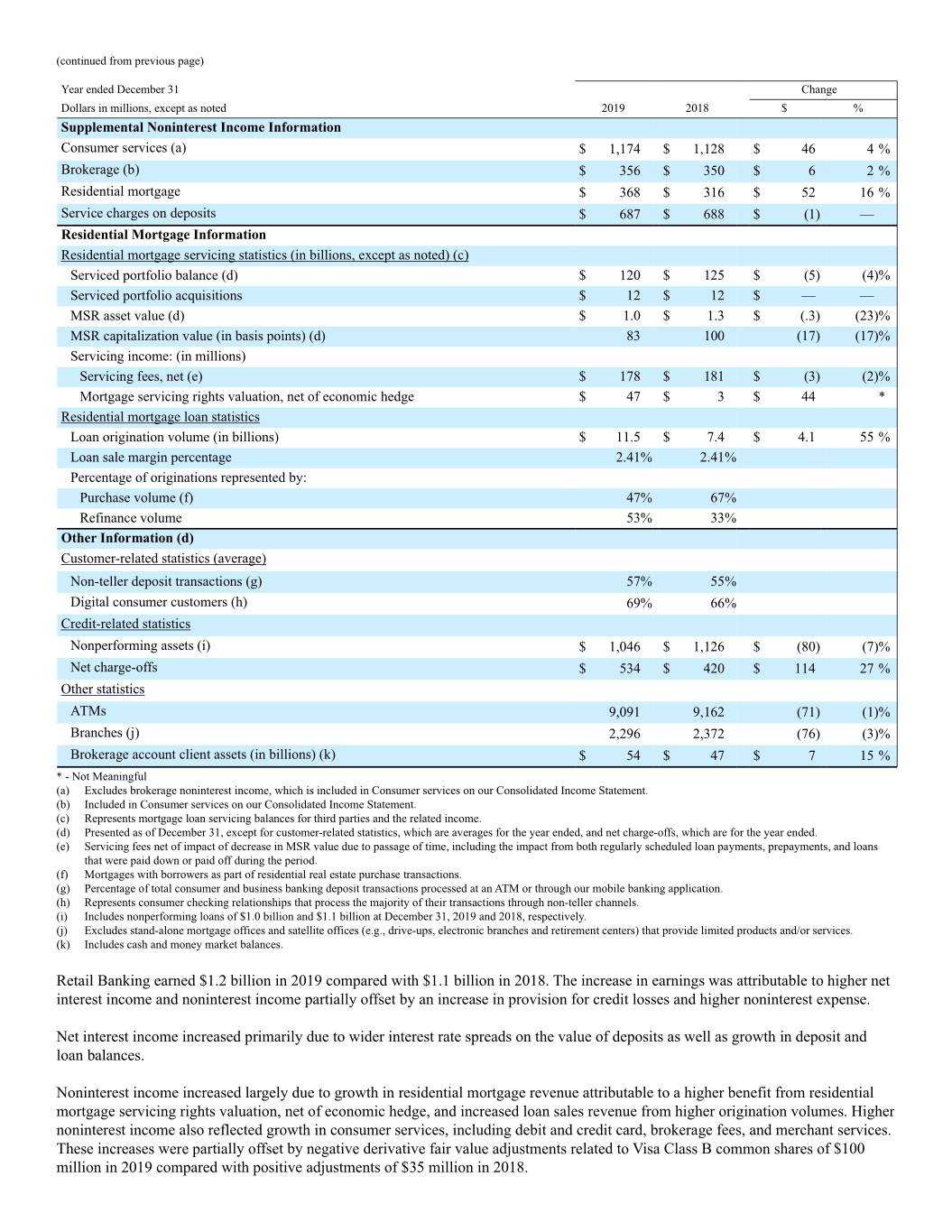
(continued from previous page) Year ended December 31 Change Dollars in millions, except as noted 2019 2018 $ % Supplemental Noninterest Income Information Consumer services (a) $ 1,174 $ 1,128 $ 46 4 % Brokerage (b) $ 356 $ 350 $ 6 2 % Residential mortgage $ 368 $ 316 $ 52 16 % Service charges on deposits $ 687 $ 688 $ (1) — Residential Mortgage Information Residential mortgage servicing statistics (in billions, except as noted) (c) Serviced portfolio balance (d) $ 120 $ 125 $ (5) (4)% Serviced portfolio acquisitions $ 12 $ 12 $ — — MSR asset value (d) $ 1.0 $ 1.3 $ (.3) (23)% MSR capitalization value (in basis points) (d) 83 100 (17) (17)% Servicing income: (in millions) Servicing fees, net (e) $ 178 $ 181 $ (3) (2)% Mortgage servicing rights valuation, net of economic hedge $ 47 $ 3 $ 44 * Residential mortgage loan statistics Loan origination volume (in billions) $ 11.5 $ 7.4 $ 4.1 55 % Loan sale margin percentage 2.41% 2.41% Percentage of originations represented by: Purchase volume (f) 47% 67% Refinance volume 53% 33% Other Information (d) Customer-related statistics (average) Non-teller deposit transactions (g) 57% 55% Digital consumer customers (h) 69% 66% Credit-related statistics Nonperforming assets (i) $ 1,046 $ 1,126 $ (80) (7)% Net charge-offs $ 534 $ 420 $ 114 27 % Other statistics ATMs 9,091 9,162 (71) (1)% Branches (j) 2,296 2,372 (76) (3)% Brokerage account client assets (in billions) (k) $ 54 $ 47 $ 7 15 % * - Not Meaningful (a) Excludes brokerage noninterest income, which is included in Consumer services on our Consolidated Income Statement. (b) Included in Consumer services on our Consolidated Income Statement. (c) Represents mortgage loan servicing balances for third parties and the related income. (d) Presented as of December 31, except for customer-related statistics, which are averages for the year ended, and net charge-offs, which are for the year ended. (e) Servicing fees net of impact of decrease in MSR value due to passage of time, including the impact from both regularly scheduled loan payments, prepayments, and loans that were paid down or paid off during the period. (f) Mortgages with borrowers as part of residential real estate purchase transactions. (g) Percentage of total consumer and business banking deposit transactions processed at an ATM or through our mobile banking application. (h) Represents consumer checking relationships that process the majority of their transactions through non-teller channels. (i) Includes nonperforming loans of $1.0 billion and $1.1 billion at December 31, 2019 and 2018, respectively. (j) Excludes stand-alone mortgage offices and satellite offices (e.g., drive-ups, electronic branches and retirement centers) that provide limited products and/or services. (k) Includes cash and money market balances. Retail Banking earned $1.2 billion in 2019 compared with $1.1 billion in 2018. The increase in earnings was attributable to higher net interest income and noninterest income partially offset by an increase in provision for credit losses and higher noninterest expense. Net interest income increased primarily due to wider interest rate spreads on the value of deposits as well as growth in deposit and loan balances. Noninterest income increased largely due to growth in residential mortgage revenue attributable to a higher benefit from residential mortgage servicing rights valuation, net of economic hedge, and increased loan sales revenue from higher origination volumes. Higher noninterest income also reflected growth in consumer services, including debit and credit card, brokerage fees, and merchant services. These increases were partially offset by negative derivative fair value adjustments related to Visa Class B common shares of $100 million in 2019 compared with positive adjustments of $35 million in 2018.

Provision for credit losses increased in 2019 compared to 2018 primarily as a result of higher auto loan and credit card reserves due to loan growth and portfolio losses, and higher reserves for unsecured installment loans partially offset by a lower provision for home equity loans. Higher noninterest expense primarily resulted from an increase in ATM expense driven by enhanced checking product benefits, higher equipment expense, and increased customer transaction related costs. The deposit strategy of Retail Banking is to remain disciplined on pricing and focused on growing and retaining relationship-based balances, executing on market-specific deposit growth strategies and providing a source of low-cost funding and liquidity to PNC. In 2019, average total deposits increased compared to 2018 primarily driven by savings deposits which increased due, in part, to a shift from money market deposits to relationship-based savings products as well as growth in consumer deposits, including from our national expansion. The increase in deposits was also attributable to higher noninterest-bearing demand deposits and certificates of deposit reflecting shifts in consumer preferences to time deposits. Retail Banking average total loans grew in 2019 compared with 2018: • Average residential mortgages increased primarily as a result of growth in nonconforming residential mortgage loans. • Average auto loans increased primarily due to strong new indirect auto loan volumes, including in our Southeast and expansion markets, as well as growth in direct auto loans. • Average credit card balances increased as we continued to focus on our long-term objective of deepening penetration within our existing customer base as well as new client acquisition. • Average home equity loans decreased as paydowns and payoffs on loans exceeded new originated volume. • Average education loans decreased driven by a decline in the runoff portfolio of government guaranteed education loans. Our national expansion initiative launched in 2018 with deposit products led by a digital high yield savings account. Following the first solution center opening in Kansas City in 2018, four additional solution centers were opened in 2019 with a second in Kansas City and three in the Dallas/Fort Worth market. Retail Banking continues to enhance the customer experience with refinements to product and service offerings that drive value for consumers and small businesses. We are focused on meeting the financial needs of our customers by providing a broad range of liquidity, banking and investment products. Retail Banking continued to execute on its strategy of transforming the customer experience through transaction channel migration, branch network and home lending process transformations and multi-channel engagement and service strategies. • Approximately 69% of consumer customers used non-teller channels for the majority of their transactions in 2019 compared with 66% in 2018. • Deposit transactions via ATM and mobile channels increased to 57% of total deposit transactions in 2019 from 55% in 2018. Retail Banking continues to make progress on its multi-year initiative to redesign the home lending process, including integrating mortgage and home equity lending into a common platform. Technology enhancements supported increased residential mortgage origination volume. In addition, we enhanced the home equity origination process to make it easier and to reach additional customers by offering the product in new states. The improvements and expansion will continue throughout 2020. Corporate & Institutional Banking Corporate & Institutional Banking’s strategy is to be the leading relationship-based provider of traditional banking products and services to its customers through the economic cycles. We aim to grow our market share and drive higher returns by delivering value- added solutions that help our clients better run their organizations, all while maintaining prudent risk and expense management. We continue to focus on building client relationships where the risk-return profile is attractive.
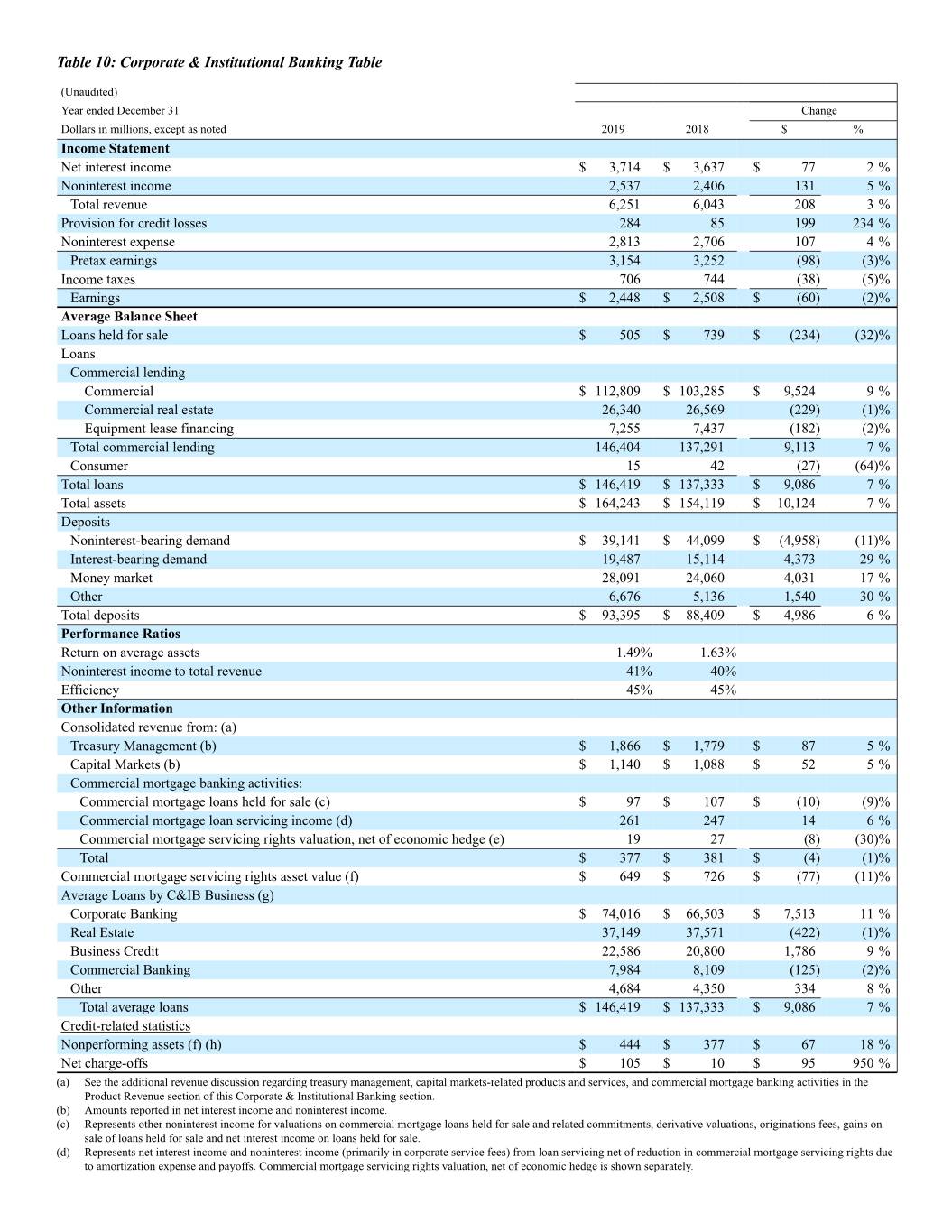
Table 10: Corporate & Institutional Banking Table (Unaudited) Year ended December 31 Change Dollars in millions, except as noted 2019 2018 $ % Income Statement Net interest income $ 3,714 $ 3,637 $ 77 2 % Noninterest income 2,537 2,406 131 5 % Total revenue 6,251 6,043 208 3 % Provision for credit losses 284 85 199 234 % Noninterest expense 2,813 2,706 107 4 % Pretax earnings 3,154 3,252 (98) (3)% Income taxes 706 744 (38) (5)% Earnings $ 2,448 $ 2,508 $ (60) (2)% Average Balance Sheet Loans held for sale $ 505 $ 739 $ (234) (32)% Loans Commercial lending Commercial $ 112,809 $ 103,285 $ 9,524 9 % Commercial real estate 26,340 26,569 (229) (1)% Equipment lease financing 7,255 7,437 (182) (2)% Total commercial lending 146,404 137,291 9,113 7 % Consumer 15 42 (27) (64)% Total loans $ 146,419 $ 137,333 $ 9,086 7 % Total assets $ 164,243 $ 154,119 $ 10,124 7 % Deposits Noninterest-bearing demand $ 39,141 $ 44,099 $ (4,958) (11)% Interest-bearing demand 19,487 15,114 4,373 29 % Money market 28,091 24,060 4,031 17 % Other 6,676 5,136 1,540 30 % Total deposits $ 93,395 $ 88,409 $ 4,986 6 % Performance Ratios Return on average assets 1.49% 1.63% Noninterest income to total revenue 41% 40% Efficiency 45% 45% Other Information Consolidated revenue from: (a) Treasury Management (b) $ 1,866 $ 1,779 $ 87 5 % Capital Markets (b) $ 1,140 $ 1,088 $ 52 5 % Commercial mortgage banking activities: Commercial mortgage loans held for sale (c) $ 97 $ 107 $ (10) (9)% Commercial mortgage loan servicing income (d) 261 247 14 6 % Commercial mortgage servicing rights valuation, net of economic hedge (e) 19 27 (8) (30)% Total $ 377 $ 381 $ (4) (1)% Commercial mortgage servicing rights asset value (f) $ 649 $ 726 $ (77) (11)% Average Loans by C&IB Business (g) Corporate Banking $ 74,016 $ 66,503 $ 7,513 11 % Real Estate 37,149 37,571 (422) (1)% Business Credit 22,586 20,800 1,786 9 % Commercial Banking 7,984 8,109 (125) (2)% Other 4,684 4,350 334 8 % Total average loans $ 146,419 $ 137,333 $ 9,086 7 % Credit-related statistics Nonperforming assets (f) (h) $ 444 $ 377 $ 67 18 % Net charge-offs $ 105 $ 10 $ 95 950 % (a) See the additional revenue discussion regarding treasury management, capital markets-related products and services, and commercial mortgage banking activities in the Product Revenue section of this Corporate & Institutional Banking section. (b) Amounts reported in net interest income and noninterest income. (c) Represents other noninterest income for valuations on commercial mortgage loans held for sale and related commitments, derivative valuations, originations fees, gains on sale of loans held for sale and net interest income on loans held for sale. (d) Represents net interest income and noninterest income (primarily in corporate service fees) from loan servicing net of reduction in commercial mortgage servicing rights due to amortization expense and payoffs. Commercial mortgage servicing rights valuation, net of economic hedge is shown separately.
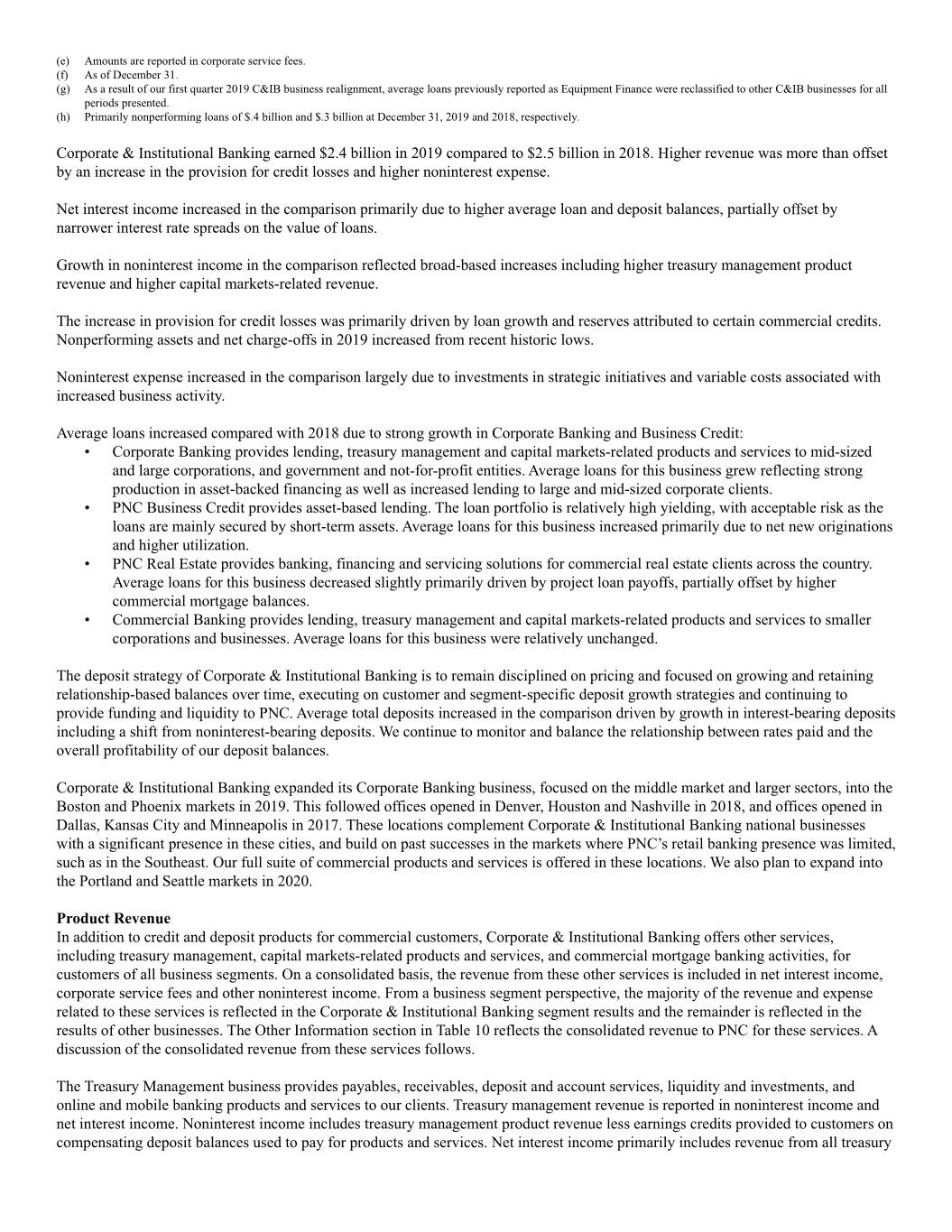
(e) Amounts are reported in corporate service fees. (f) As of December 31. (g) As a result of our first quarter 2019 C&IB business realignment, average loans previously reported as Equipment Finance were reclassified to other C&IB businesses for all periods presented. (h) Primarily nonperforming loans of $.4 billion and $.3 billion at December 31, 2019 and 2018, respectively. Corporate & Institutional Banking earned $2.4 billion in 2019 compared to $2.5 billion in 2018. Higher revenue was more than offset by an increase in the provision for credit losses and higher noninterest expense. Net interest income increased in the comparison primarily due to higher average loan and deposit balances, partially offset by narrower interest rate spreads on the value of loans. Growth in noninterest income in the comparison reflected broad-based increases including higher treasury management product revenue and higher capital markets-related revenue. The increase in provision for credit losses was primarily driven by loan growth and reserves attributed to certain commercial credits. Nonperforming assets and net charge-offs in 2019 increased from recent historic lows. Noninterest expense increased in the comparison largely due to investments in strategic initiatives and variable costs associated with increased business activity. Average loans increased compared with 2018 due to strong growth in Corporate Banking and Business Credit: • Corporate Banking provides lending, treasury management and capital markets-related products and services to mid-sized and large corporations, and government and not-for-profit entities. Average loans for this business grew reflecting strong production in asset-backed financing as well as increased lending to large and mid-sized corporate clients. • PNC Business Credit provides asset-based lending. The loan portfolio is relatively high yielding, with acceptable risk as the loans are mainly secured by short-term assets. Average loans for this business increased primarily due to net new originations and higher utilization. • PNC Real Estate provides banking, financing and servicing solutions for commercial real estate clients across the country. Average loans for this business decreased slightly primarily driven by project loan payoffs, partially offset by higher commercial mortgage balances. • Commercial Banking provides lending, treasury management and capital markets-related products and services to smaller corporations and businesses. Average loans for this business were relatively unchanged. The deposit strategy of Corporate & Institutional Banking is to remain disciplined on pricing and focused on growing and retaining relationship-based balances over time, executing on customer and segment-specific deposit growth strategies and continuing to provide funding and liquidity to PNC. Average total deposits increased in the comparison driven by growth in interest-bearing deposits including a shift from noninterest-bearing deposits. We continue to monitor and balance the relationship between rates paid and the overall profitability of our deposit balances. Corporate & Institutional Banking expanded its Corporate Banking business, focused on the middle market and larger sectors, into the Boston and Phoenix markets in 2019. This followed offices opened in Denver, Houston and Nashville in 2018, and offices opened in Dallas, Kansas City and Minneapolis in 2017. These locations complement Corporate & Institutional Banking national businesses with a significant presence in these cities, and build on past successes in the markets where PNC’s retail banking presence was limited, such as in the Southeast. Our full suite of commercial products and services is offered in these locations. We also plan to expand into the Portland and Seattle markets in 2020. Product Revenue In addition to credit and deposit products for commercial customers, Corporate & Institutional Banking offers other services, including treasury management, capital markets-related products and services, and commercial mortgage banking activities, for customers of all business segments. On a consolidated basis, the revenue from these other services is included in net interest income, corporate service fees and other noninterest income. From a business segment perspective, the majority of the revenue and expense related to these services is reflected in the Corporate & Institutional Banking segment results and the remainder is reflected in the results of other businesses. The Other Information section in Table 10 reflects the consolidated revenue to PNC for these services. A discussion of the consolidated revenue from these services follows. The Treasury Management business provides payables, receivables, deposit and account services, liquidity and investments, and online and mobile banking products and services to our clients. Treasury management revenue is reported in noninterest income and net interest income. Noninterest income includes treasury management product revenue less earnings credits provided to customers on compensating deposit balances used to pay for products and services. Net interest income primarily includes revenue from all treasury
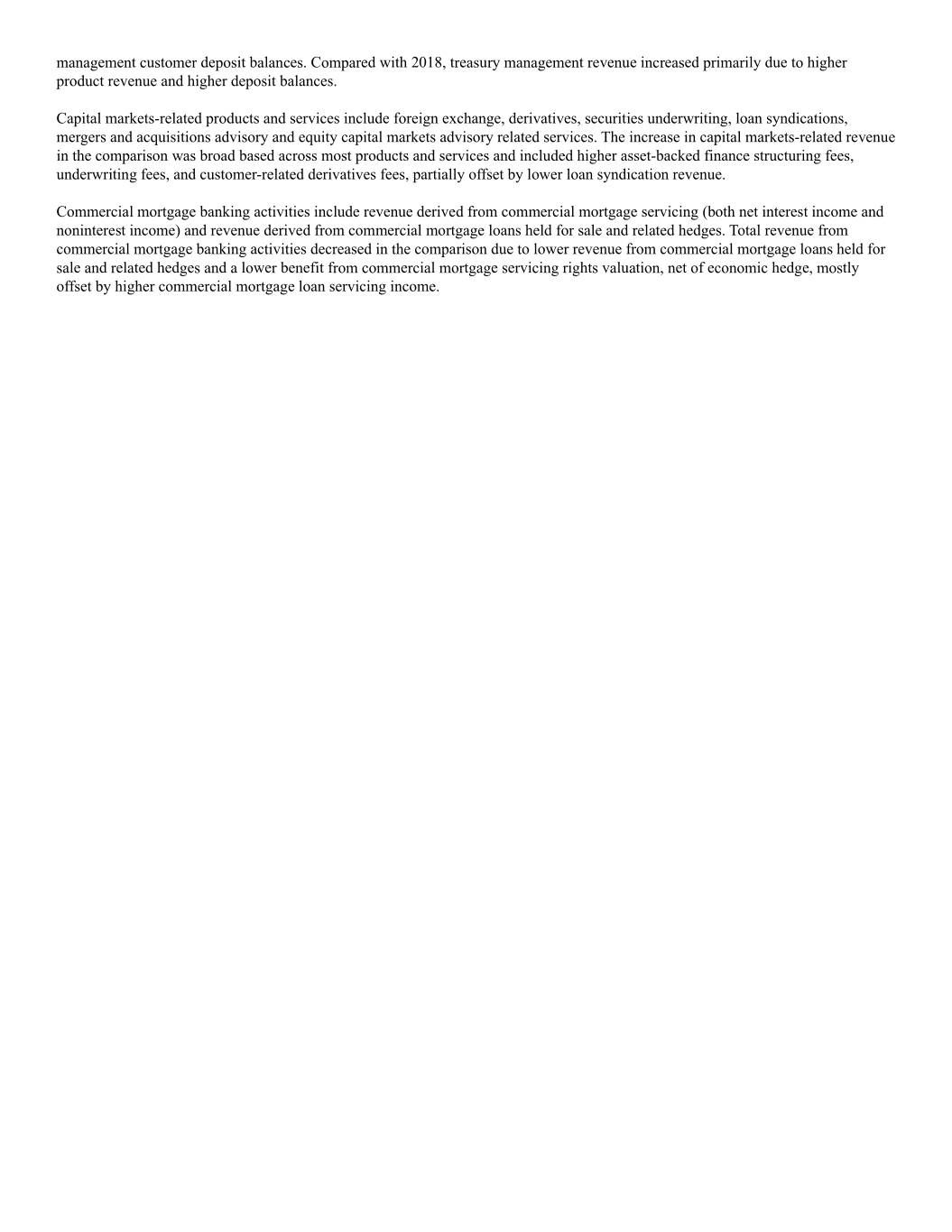
management customer deposit balances. Compared with 2018, treasury management revenue increased primarily due to higher product revenue and higher deposit balances. Capital markets-related products and services include foreign exchange, derivatives, securities underwriting, loan syndications, mergers and acquisitions advisory and equity capital markets advisory related services. The increase in capital markets-related revenue in the comparison was broad based across most products and services and included higher asset-backed finance structuring fees, underwriting fees, and customer-related derivatives fees, partially offset by lower loan syndication revenue. Commercial mortgage banking activities include revenue derived from commercial mortgage servicing (both net interest income and noninterest income) and revenue derived from commercial mortgage loans held for sale and related hedges. Total revenue from commercial mortgage banking activities decreased in the comparison due to lower revenue from commercial mortgage loans held for sale and related hedges and a lower benefit from commercial mortgage servicing rights valuation, net of economic hedge, mostly offset by higher commercial mortgage loan servicing income.
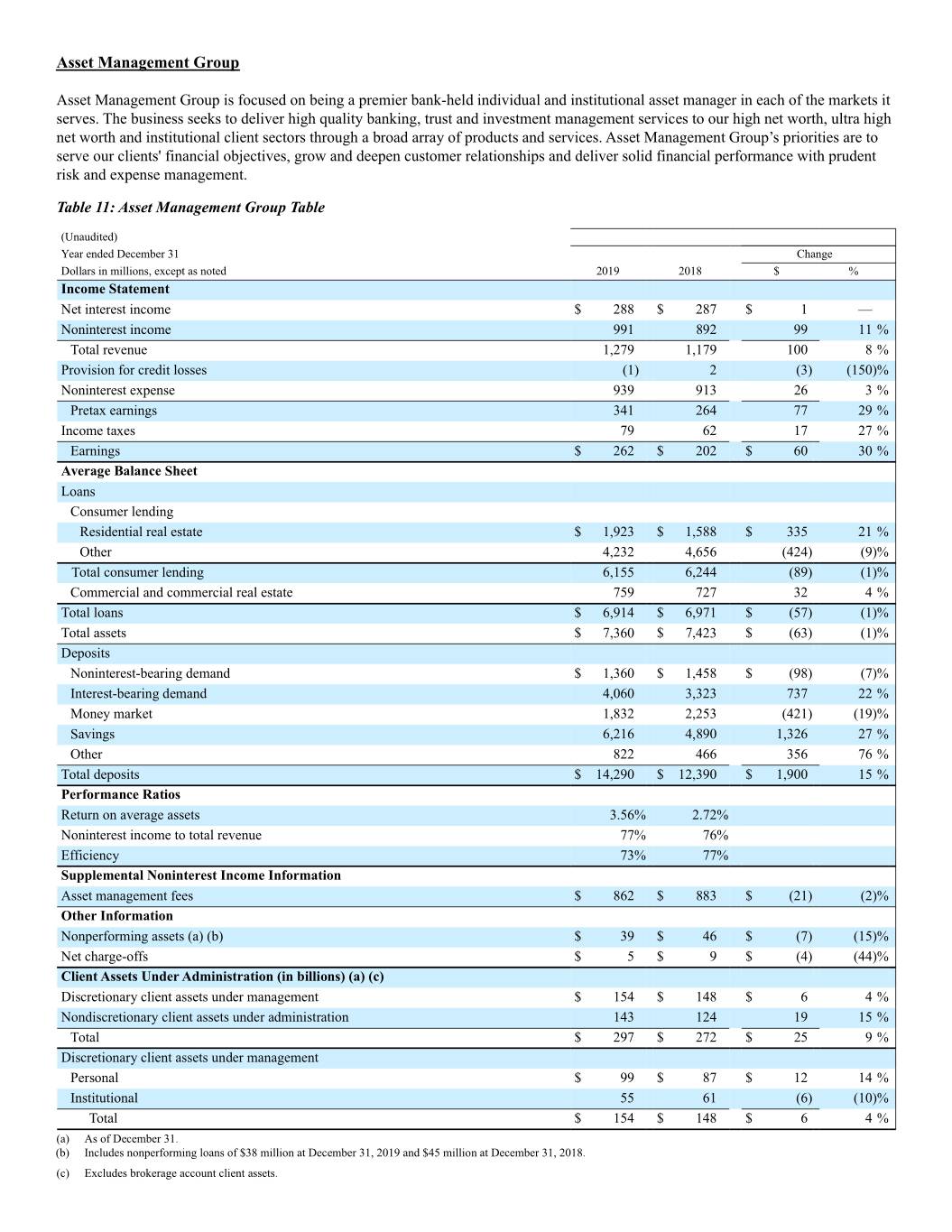
Asset Management Group Asset Management Group is focused on being a premier bank-held individual and institutional asset manager in each of the markets it serves. The business seeks to deliver high quality banking, trust and investment management services to our high net worth, ultra high net worth and institutional client sectors through a broad array of products and services. Asset Management Group’s priorities are to serve our clients' financial objectives, grow and deepen customer relationships and deliver solid financial performance with prudent risk and expense management. Table 11: Asset Management Group Table (Unaudited) Year ended December 31 Change Dollars in millions, except as noted 2019 2018 $ % Income Statement Net interest income $ 288 $ 287 $ 1 — Noninterest income 991 892 99 11 % Total revenue 1,279 1,179 100 8 % Provision for credit losses (1) 2 (3) (150)% Noninterest expense 939 913 26 3 % Pretax earnings 341 264 77 29 % Income taxes 79 62 17 27 % Earnings $ 262 $ 202 $ 60 30 % Average Balance Sheet Loans Consumer lending Residential real estate $ 1,923 $ 1,588 $ 335 21 % Other 4,232 4,656 (424) (9)% Total consumer lending 6,155 6,244 (89) (1)% Commercial and commercial real estate 759 727 32 4 % Total loans $ 6,914 $ 6,971 $ (57) (1)% Total assets $ 7,360 $ 7,423 $ (63) (1)% Deposits Noninterest-bearing demand $ 1,360 $ 1,458 $ (98) (7)% Interest-bearing demand 4,060 3,323 737 22 % Money market 1,832 2,253 (421) (19)% Savings 6,216 4,890 1,326 27 % Other 822 466 356 76 % Total deposits $ 14,290 $ 12,390 $ 1,900 15 % Performance Ratios Return on average assets 3.56% 2.72% Noninterest income to total revenue 77% 76% Efficiency 73% 77% Supplemental Noninterest Income Information Asset management fees $ 862 $ 883 $ (21) (2)% Other Information Nonperforming assets (a) (b) $ 39 $ 46 $ (7) (15)% Net charge-offs $ 5 $ 9 $ (4) (44)% Client Assets Under Administration (in billions) (a) (c) Discretionary client assets under management $ 154 $ 148 $ 6 4 % Nondiscretionary client assets under administration 143 124 19 15 % Total $ 297 $ 272 $ 25 9 % Discretionary client assets under management Personal $ 99 $ 87 $ 12 14 % Institutional 55 61 (6) (10)% Total $ 154 $ 148 $ 6 4 % (a) As of December 31. (b) Includes nonperforming loans of $38 million at December 31, 2019 and $45 million at December 31, 2018. (c) Excludes brokerage account client assets.
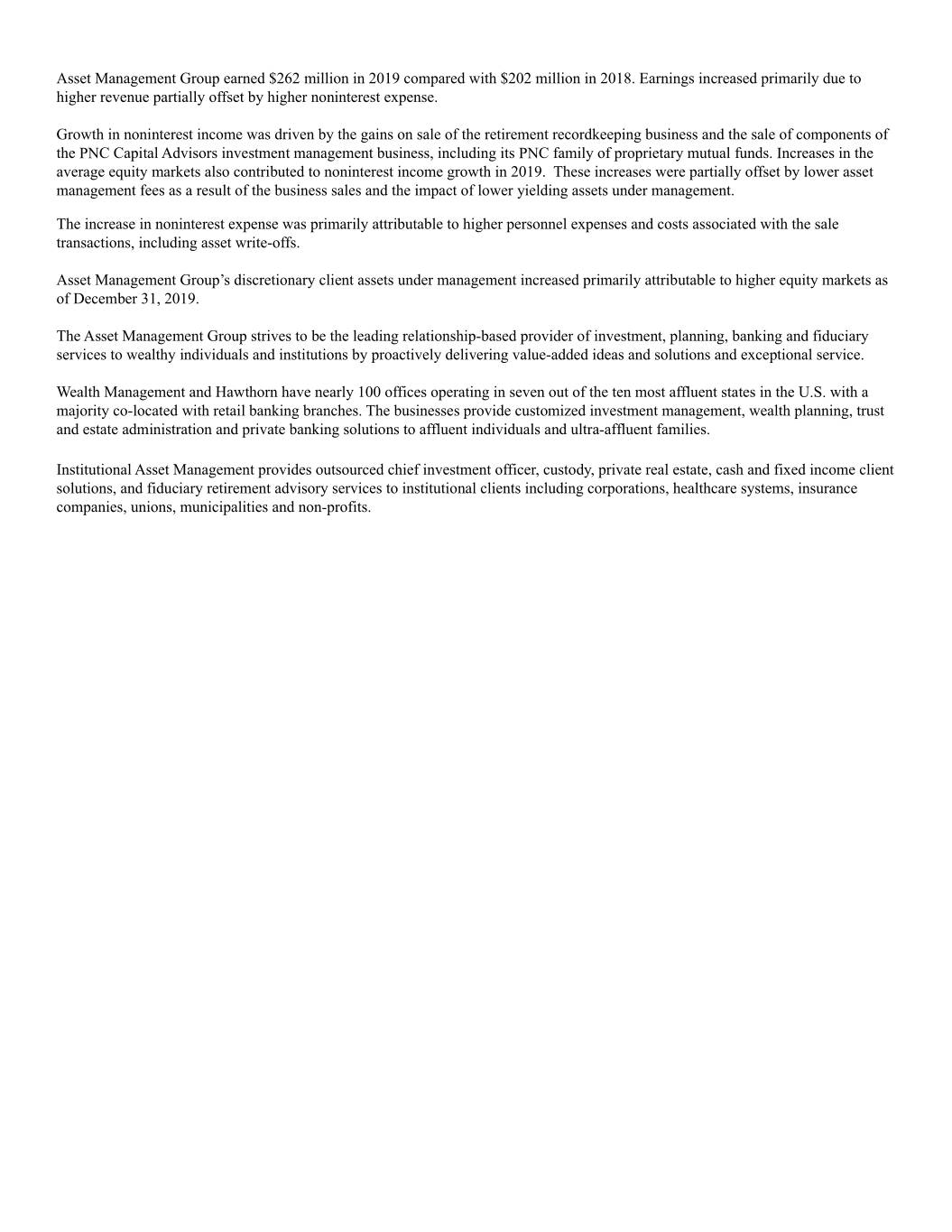
Asset Management Group earned $262 million in 2019 compared with $202 million in 2018. Earnings increased primarily due to higher revenue partially offset by higher noninterest expense. Growth in noninterest income was driven by the gains on sale of the retirement recordkeeping business and the sale of components of the PNC Capital Advisors investment management business, including its PNC family of proprietary mutual funds. Increases in the average equity markets also contributed to noninterest income growth in 2019. These increases were partially offset by lower asset management fees as a result of the business sales and the impact of lower yielding assets under management. The increase in noninterest expense was primarily attributable to higher personnel expenses and costs associated with the sale transactions, including asset write-offs. Asset Management Group’s discretionary client assets under management increased primarily attributable to higher equity markets as of December 31, 2019. The Asset Management Group strives to be the leading relationship-based provider of investment, planning, banking and fiduciary services to wealthy individuals and institutions by proactively delivering value-added ideas and solutions and exceptional service. Wealth Management and Hawthorn have nearly 100 offices operating in seven out of the ten most affluent states in the U.S. with a majority co-located with retail banking branches. The businesses provide customized investment management, wealth planning, trust and estate administration and private banking solutions to affluent individuals and ultra-affluent families. Institutional Asset Management provides outsourced chief investment officer, custody, private real estate, cash and fixed income client solutions, and fiduciary retirement advisory services to institutional clients including corporations, healthcare systems, insurance companies, unions, municipalities and non-profits.
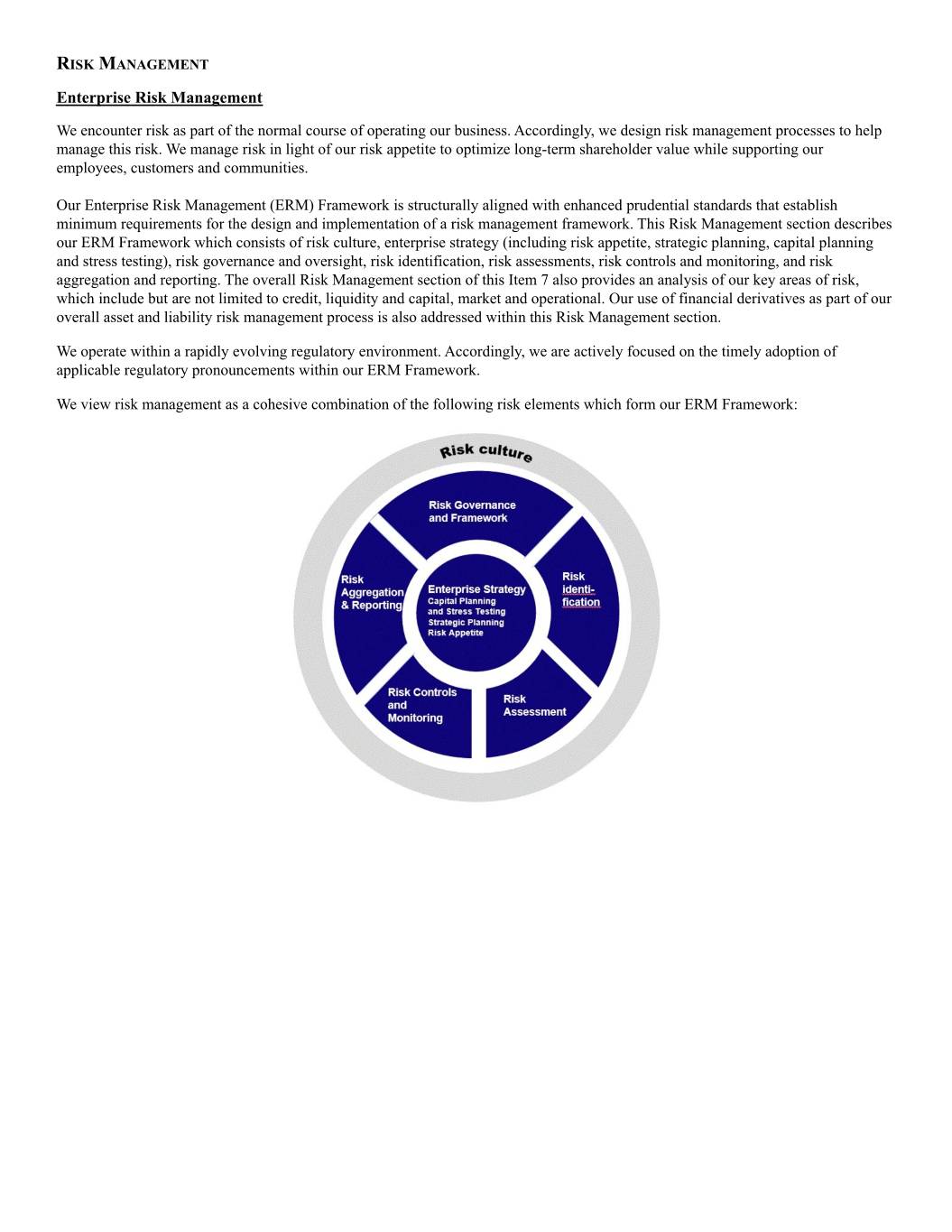
RISK MANAGEMENT Enterprise Risk Management We encounter risk as part of the normal course of operating our business. Accordingly, we design risk management processes to help manage this risk. We manage risk in light of our risk appetite to optimize long-term shareholder value while supporting our employees, customers and communities. Our Enterprise Risk Management (ERM) Framework is structurally aligned with enhanced prudential standards that establish minimum requirements for the design and implementation of a risk management framework. This Risk Management section describes our ERM Framework which consists of risk culture, enterprise strategy (including risk appetite, strategic planning, capital planning and stress testing), risk governance and oversight, risk identification, risk assessments, risk controls and monitoring, and risk aggregation and reporting. The overall Risk Management section of this Item 7 also provides an analysis of our key areas of risk, which include but are not limited to credit, liquidity and capital, market and operational. Our use of financial derivatives as part of our overall asset and liability risk management process is also addressed within this Risk Management section. We operate within a rapidly evolving regulatory environment. Accordingly, we are actively focused on the timely adoption of applicable regulatory pronouncements within our ERM Framework. We view risk management as a cohesive combination of the following risk elements which form our ERM Framework:
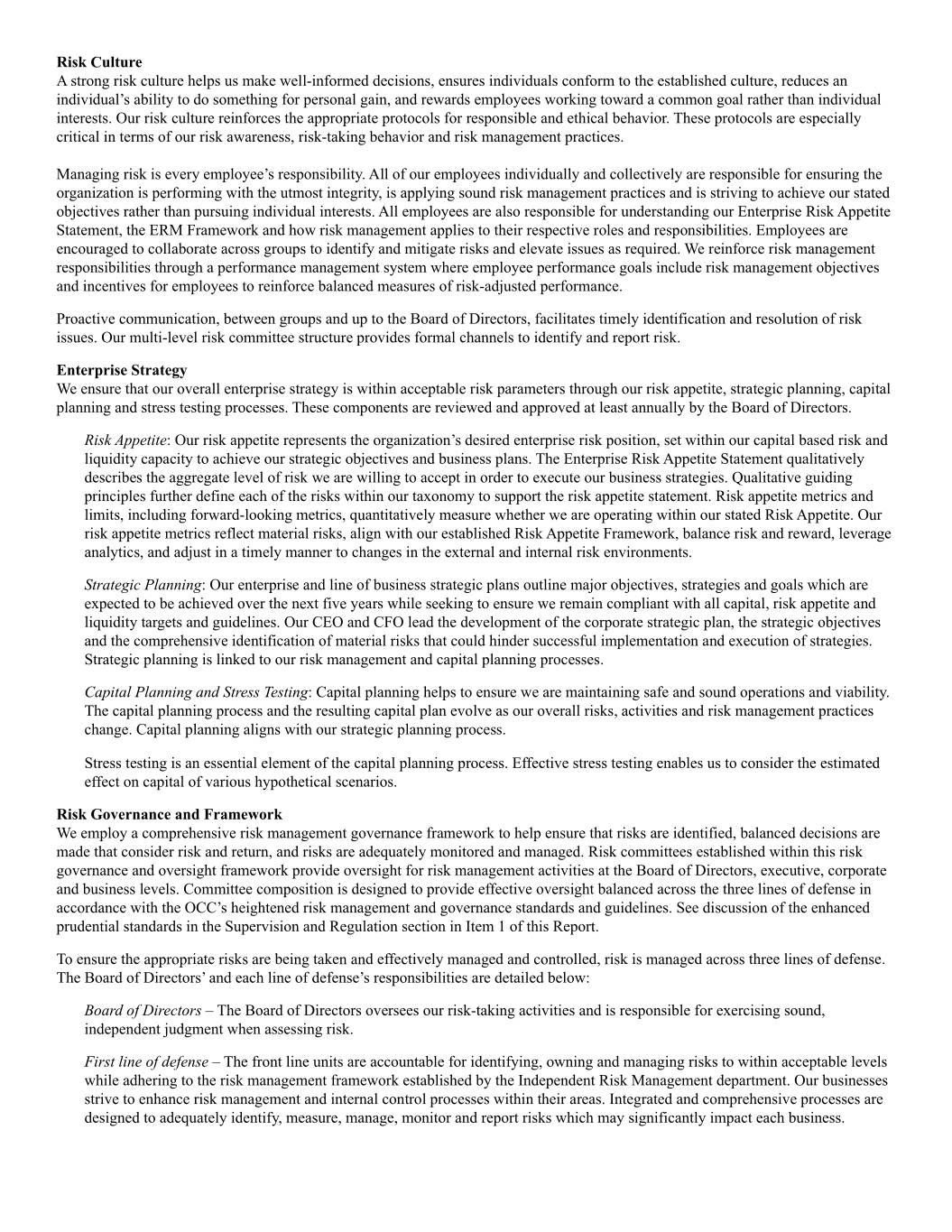
Risk Culture A strong risk culture helps us make well-informed decisions, ensures individuals conform to the established culture, reduces an individual’s ability to do something for personal gain, and rewards employees working toward a common goal rather than individual interests. Our risk culture reinforces the appropriate protocols for responsible and ethical behavior. These protocols are especially critical in terms of our risk awareness, risk-taking behavior and risk management practices. Managing risk is every employee’s responsibility. All of our employees individually and collectively are responsible for ensuring the organization is performing with the utmost integrity, is applying sound risk management practices and is striving to achieve our stated objectives rather than pursuing individual interests. All employees are also responsible for understanding our Enterprise Risk Appetite Statement, the ERM Framework and how risk management applies to their respective roles and responsibilities. Employees are encouraged to collaborate across groups to identify and mitigate risks and elevate issues as required. We reinforce risk management responsibilities through a performance management system where employee performance goals include risk management objectives and incentives for employees to reinforce balanced measures of risk-adjusted performance. Proactive communication, between groups and up to the Board of Directors, facilitates timely identification and resolution of risk issues. Our multi-level risk committee structure provides formal channels to identify and report risk. Enterprise Strategy We ensure that our overall enterprise strategy is within acceptable risk parameters through our risk appetite, strategic planning, capital planning and stress testing processes. These components are reviewed and approved at least annually by the Board of Directors. Risk Appetite: Our risk appetite represents the organization’s desired enterprise risk position, set within our capital based risk and liquidity capacity to achieve our strategic objectives and business plans. The Enterprise Risk Appetite Statement qualitatively describes the aggregate level of risk we are willing to accept in order to execute our business strategies. Qualitative guiding principles further define each of the risks within our taxonomy to support the risk appetite statement. Risk appetite metrics and limits, including forward-looking metrics, quantitatively measure whether we are operating within our stated Risk Appetite. Our risk appetite metrics reflect material risks, align with our established Risk Appetite Framework, balance risk and reward, leverage analytics, and adjust in a timely manner to changes in the external and internal risk environments. Strategic Planning: Our enterprise and line of business strategic plans outline major objectives, strategies and goals which are expected to be achieved over the next five years while seeking to ensure we remain compliant with all capital, risk appetite and liquidity targets and guidelines. Our CEO and CFO lead the development of the corporate strategic plan, the strategic objectives and the comprehensive identification of material risks that could hinder successful implementation and execution of strategies. Strategic planning is linked to our risk management and capital planning processes. Capital Planning and Stress Testing: Capital planning helps to ensure we are maintaining safe and sound operations and viability. The capital planning process and the resulting capital plan evolve as our overall risks, activities and risk management practices change. Capital planning aligns with our strategic planning process. Stress testing is an essential element of the capital planning process. Effective stress testing enables us to consider the estimated effect on capital of various hypothetical scenarios. Risk Governance and Framework We employ a comprehensive risk management governance framework to help ensure that risks are identified, balanced decisions are made that consider risk and return, and risks are adequately monitored and managed. Risk committees established within this risk governance and oversight framework provide oversight for risk management activities at the Board of Directors, executive, corporate and business levels. Committee composition is designed to provide effective oversight balanced across the three lines of defense in accordance with the OCC’s heightened risk management and governance standards and guidelines. See discussion of the enhanced prudential standards in the Supervision and Regulation section in Item 1 of this Report. To ensure the appropriate risks are being taken and effectively managed and controlled, risk is managed across three lines of defense. The Board of Directors’ and each line of defense’s responsibilities are detailed below: Board of Directors – The Board of Directors oversees our risk-taking activities and is responsible for exercising sound, independent judgment when assessing risk. First line of defense – The front line units are accountable for identifying, owning and managing risks to within acceptable levels while adhering to the risk management framework established by the Independent Risk Management department. Our businesses strive to enhance risk management and internal control processes within their areas. Integrated and comprehensive processes are designed to adequately identify, measure, manage, monitor and report risks which may significantly impact each business.
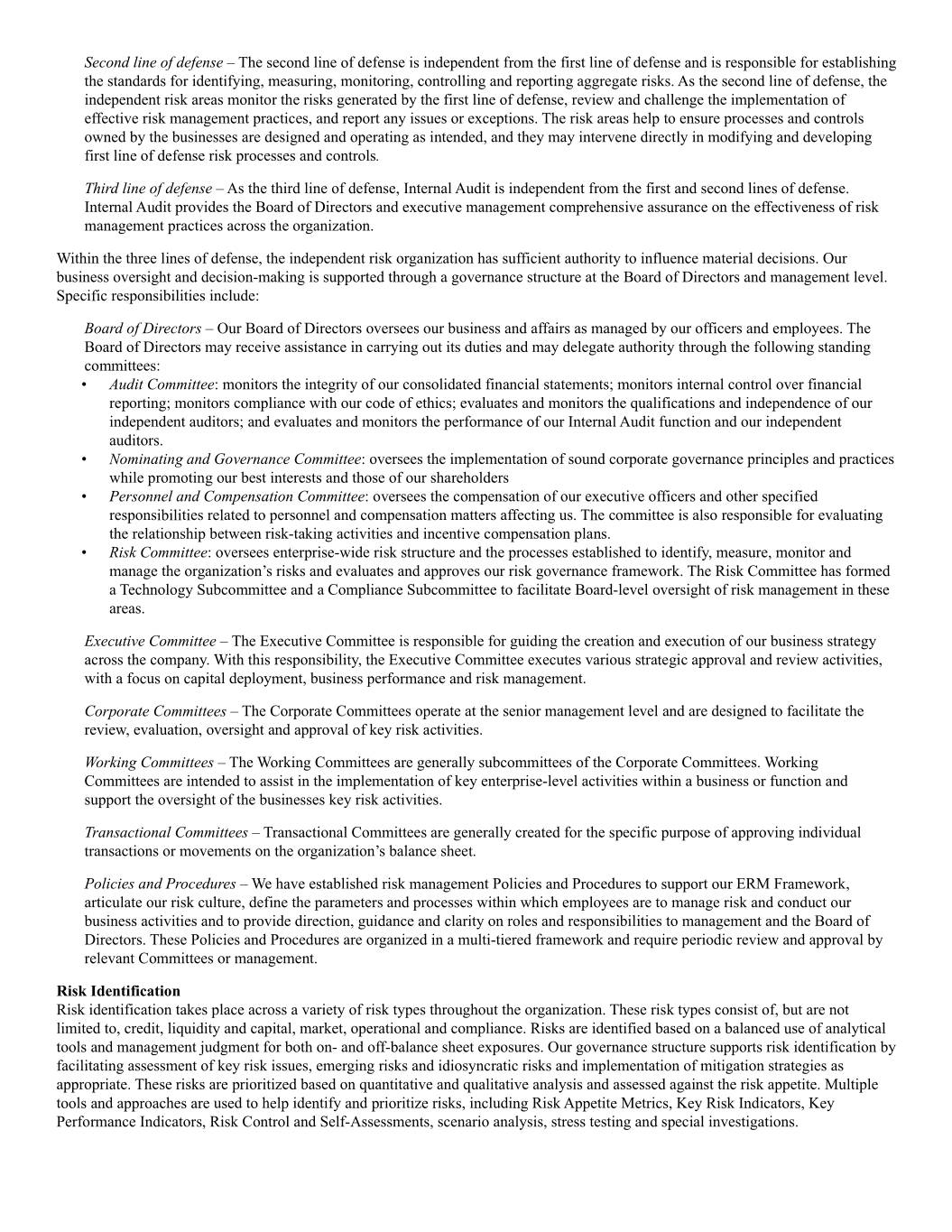
Second line of defense – The second line of defense is independent from the first line of defense and is responsible for establishing the standards for identifying, measuring, monitoring, controlling and reporting aggregate risks. As the second line of defense, the independent risk areas monitor the risks generated by the first line of defense, review and challenge the implementation of effective risk management practices, and report any issues or exceptions. The risk areas help to ensure processes and controls owned by the businesses are designed and operating as intended, and they may intervene directly in modifying and developing first line of defense risk processes and controls. Third line of defense – As the third line of defense, Internal Audit is independent from the first and second lines of defense. Internal Audit provides the Board of Directors and executive management comprehensive assurance on the effectiveness of risk management practices across the organization. Within the three lines of defense, the independent risk organization has sufficient authority to influence material decisions. Our business oversight and decision-making is supported through a governance structure at the Board of Directors and management level. Specific responsibilities include: Board of Directors – Our Board of Directors oversees our business and affairs as managed by our officers and employees. The Board of Directors may receive assistance in carrying out its duties and may delegate authority through the following standing committees: • Audit Committee: monitors the integrity of our consolidated financial statements; monitors internal control over financial reporting; monitors compliance with our code of ethics; evaluates and monitors the qualifications and independence of our independent auditors; and evaluates and monitors the performance of our Internal Audit function and our independent auditors. • Nominating and Governance Committee: oversees the implementation of sound corporate governance principles and practices while promoting our best interests and those of our shareholders • Personnel and Compensation Committee: oversees the compensation of our executive officers and other specified responsibilities related to personnel and compensation matters affecting us. The committee is also responsible for evaluating the relationship between risk-taking activities and incentive compensation plans. • Risk Committee: oversees enterprise-wide risk structure and the processes established to identify, measure, monitor and manage the organization’s risks and evaluates and approves our risk governance framework. The Risk Committee has formed a Technology Subcommittee and a Compliance Subcommittee to facilitate Board-level oversight of risk management in these areas. Executive Committee – The Executive Committee is responsible for guiding the creation and execution of our business strategy across the company. With this responsibility, the Executive Committee executes various strategic approval and review activities, with a focus on capital deployment, business performance and risk management. Corporate Committees – The Corporate Committees operate at the senior management level and are designed to facilitate the review, evaluation, oversight and approval of key risk activities. Working Committees – The Working Committees are generally subcommittees of the Corporate Committees. Working Committees are intended to assist in the implementation of key enterprise-level activities within a business or function and support the oversight of the businesses key risk activities. Transactional Committees – Transactional Committees are generally created for the specific purpose of approving individual transactions or movements on the organization’s balance sheet. Policies and Procedures – We have established risk management Policies and Procedures to support our ERM Framework, articulate our risk culture, define the parameters and processes within which employees are to manage risk and conduct our business activities and to provide direction, guidance and clarity on roles and responsibilities to management and the Board of Directors. These Policies and Procedures are organized in a multi-tiered framework and require periodic review and approval by relevant Committees or management. Risk Identification Risk identification takes place across a variety of risk types throughout the organization. These risk types consist of, but are not limited to, credit, liquidity and capital, market, operational and compliance. Risks are identified based on a balanced use of analytical tools and management judgment for both on- and off-balance sheet exposures. Our governance structure supports risk identification by facilitating assessment of key risk issues, emerging risks and idiosyncratic risks and implementation of mitigation strategies as appropriate. These risks are prioritized based on quantitative and qualitative analysis and assessed against the risk appetite. Multiple tools and approaches are used to help identify and prioritize risks, including Risk Appetite Metrics, Key Risk Indicators, Key Performance Indicators, Risk Control and Self-Assessments, scenario analysis, stress testing and special investigations.
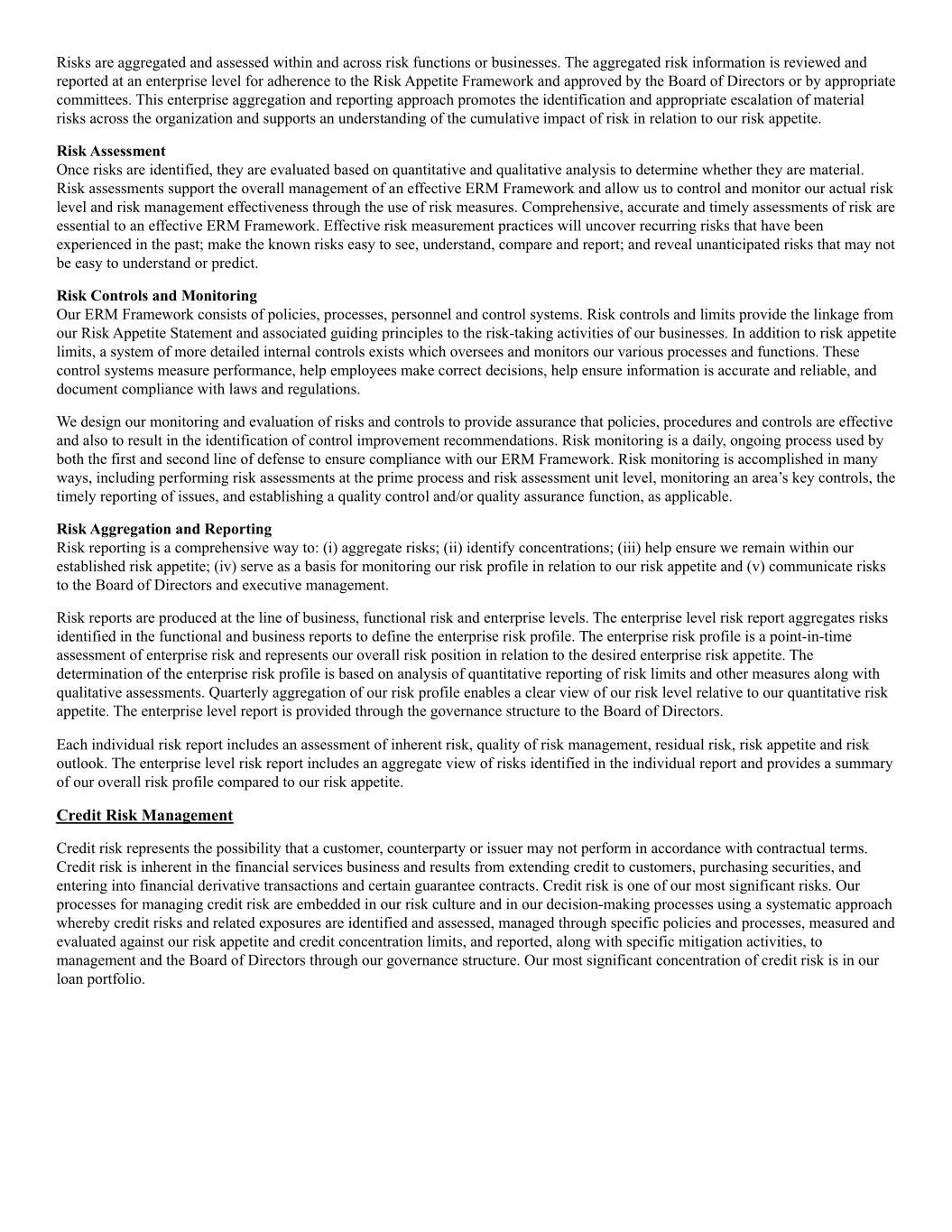
Risks are aggregated and assessed within and across risk functions or businesses. The aggregated risk information is reviewed and reported at an enterprise level for adherence to the Risk Appetite Framework and approved by the Board of Directors or by appropriate committees. This enterprise aggregation and reporting approach promotes the identification and appropriate escalation of material risks across the organization and supports an understanding of the cumulative impact of risk in relation to our risk appetite. Risk Assessment Once risks are identified, they are evaluated based on quantitative and qualitative analysis to determine whether they are material. Risk assessments support the overall management of an effective ERM Framework and allow us to control and monitor our actual risk level and risk management effectiveness through the use of risk measures. Comprehensive, accurate and timely assessments of risk are essential to an effective ERM Framework. Effective risk measurement practices will uncover recurring risks that have been experienced in the past; make the known risks easy to see, understand, compare and report; and reveal unanticipated risks that may not be easy to understand or predict. Risk Controls and Monitoring Our ERM Framework consists of policies, processes, personnel and control systems. Risk controls and limits provide the linkage from our Risk Appetite Statement and associated guiding principles to the risk-taking activities of our businesses. In addition to risk appetite limits, a system of more detailed internal controls exists which oversees and monitors our various processes and functions. These control systems measure performance, help employees make correct decisions, help ensure information is accurate and reliable, and document compliance with laws and regulations. We design our monitoring and evaluation of risks and controls to provide assurance that policies, procedures and controls are effective and also to result in the identification of control improvement recommendations. Risk monitoring is a daily, ongoing process used by both the first and second line of defense to ensure compliance with our ERM Framework. Risk monitoring is accomplished in many ways, including performing risk assessments at the prime process and risk assessment unit level, monitoring an area’s key controls, the timely reporting of issues, and establishing a quality control and/or quality assurance function, as applicable. Risk Aggregation and Reporting Risk reporting is a comprehensive way to: (i) aggregate risks; (ii) identify concentrations; (iii) help ensure we remain within our established risk appetite; (iv) serve as a basis for monitoring our risk profile in relation to our risk appetite and (v) communicate risks to the Board of Directors and executive management. Risk reports are produced at the line of business, functional risk and enterprise levels. The enterprise level risk report aggregates risks identified in the functional and business reports to define the enterprise risk profile. The enterprise risk profile is a point-in-time assessment of enterprise risk and represents our overall risk position in relation to the desired enterprise risk appetite. The determination of the enterprise risk profile is based on analysis of quantitative reporting of risk limits and other measures along with qualitative assessments. Quarterly aggregation of our risk profile enables a clear view of our risk level relative to our quantitative risk appetite. The enterprise level report is provided through the governance structure to the Board of Directors. Each individual risk report includes an assessment of inherent risk, quality of risk management, residual risk, risk appetite and risk outlook. The enterprise level risk report includes an aggregate view of risks identified in the individual report and provides a summary of our overall risk profile compared to our risk appetite. Credit Risk Management Credit risk represents the possibility that a customer, counterparty or issuer may not perform in accordance with contractual terms. Credit risk is inherent in the financial services business and results from extending credit to customers, purchasing securities, and entering into financial derivative transactions and certain guarantee contracts. Credit risk is one of our most significant risks. Our processes for managing credit risk are embedded in our risk culture and in our decision-making processes using a systematic approach whereby credit risks and related exposures are identified and assessed, managed through specific policies and processes, measured and evaluated against our risk appetite and credit concentration limits, and reported, along with specific mitigation activities, to management and the Board of Directors through our governance structure. Our most significant concentration of credit risk is in our loan portfolio.
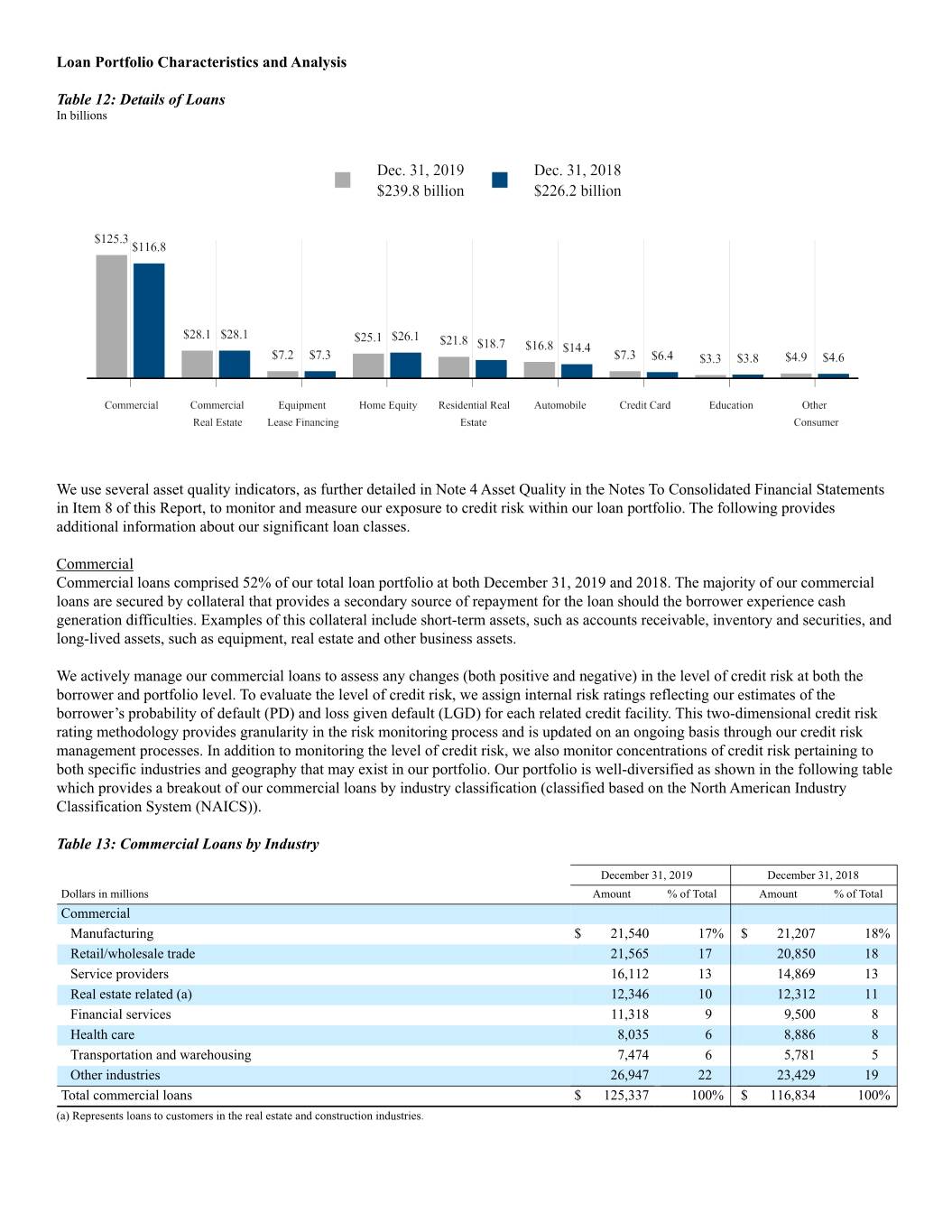
Loan Portfolio Characteristics and Analysis Table 12: Details of Loans In billions We use several asset quality indicators, as further detailed in Note 4 Asset Quality in the Notes To Consolidated Financial Statements in Item 8 of this Report, to monitor and measure our exposure to credit risk within our loan portfolio. The following provides additional information about our significant loan classes. Commercial Commercial loans comprised 52% of our total loan portfolio at both December 31, 2019 and 2018. The majority of our commercial loans are secured by collateral that provides a secondary source of repayment for the loan should the borrower experience cash generation difficulties. Examples of this collateral include short-term assets, such as accounts receivable, inventory and securities, and long-lived assets, such as equipment, real estate and other business assets. We actively manage our commercial loans to assess any changes (both positive and negative) in the level of credit risk at both the borrower and portfolio level. To evaluate the level of credit risk, we assign internal risk ratings reflecting our estimates of the borrower’s probability of default (PD) and loss given default (LGD) for each related credit facility. This two-dimensional credit risk rating methodology provides granularity in the risk monitoring process and is updated on an ongoing basis through our credit risk management processes. In addition to monitoring the level of credit risk, we also monitor concentrations of credit risk pertaining to both specific industries and geography that may exist in our portfolio. Our portfolio is well-diversified as shown in the following table which provides a breakout of our commercial loans by industry classification (classified based on the North American Industry Classification System (NAICS)). Table 13: Commercial Loans by Industry December 31, 2019 December 31, 2018 Dollars in millions Amount % of Total Amount % of Total Commercial Manufacturing $ 21,540 17% $ 21,207 18% Retail/wholesale trade 21,565 17 20,850 18 Service providers 16,112 13 14,869 13 Real estate related (a) 12,346 10 12,312 11 Financial services 11,318 9 9,500 8 Health care 8,035 6 8,886 8 Transportation and warehousing 7,474 6 5,781 5 Other industries 26,947 22 23,429 19 Total commercial loans $ 125,337 100% $ 116,834 100% (a) Represents loans to customers in the real estate and construction industries.

Environmental and social risks are incorporated into the transaction and portfolio management policies and procedures that govern our underwriting and portfolio management practices. All Corporate & Institutional Banking transactions are subject to an Environmental and Social Risk Management assessment designed to help us better identify and mitigate environmental and human rights risks early in the credit application process. Transactions identified as having a potential environmental or human rights risk are evaluated to determine whether enhanced due diligence is warranted. We have also chosen to limit new originations in sectors that are no longer consistent with our strategic direction, such as mountain-top removal coal mining and private prisons. We periodically review environmental and social risk topics in PNC’s Credit Portfolio Strategy Committee, and outcomes of these reviews may result in changes to our due diligence, origination requirements, or limits on credit exposure. Our approach to identifying environmental and social risks is regularly reviewed by senior management and overseen by our Board of Directors. PNC will continue to refine its approach as banking conditions, regulatory requirements, investors’ perspectives and our strategic direction evolve. Commercial Real Estate Commercial real estate loans comprised $17.0 billion related to commercial mortgages, $5.6 billion of real estate project loans and $5.5 billion of intermediate term financing loans as of December 31, 2019. Comparable amounts were $14.4 billion, $6.6 billion and $7.1 billion, respectively, as of December 31, 2018. We monitor credit risk associated with our commercial real estate loans similar to commercial loans by analyzing PD and LGD. Additionally, risks associated with these types of credit activities tend to be correlated to the loan structure, collateral location, project progress and business environment. These attributes are also monitored and utilized in assessing credit risk. The portfolio is geographically diverse due to the nature of our business involving clients throughout the U.S. The following table presents our commercial real estate loans by geography and property type. Table 14: Commercial Real Estate Loans by Geography and Property Type December 31, 2019 December 31, 2018 Dollars in millions Amount % of Total Amount % of Total Geography California $ 4,393 16% $ 4,154 15% Florida 2,557 9 2,157 8 Maryland 1,889 7 1,966 7 Texas 1,717 6 1,531 5 Virginia 1,547 6 1,682 6 Pennsylvania 1,310 4 1,214 4 Ohio 1,307 4 1,053 4 New Jersey 1,106 4 884 3 North Carolina 1,015 4 915 3 Illinois 1,001 4 1,368 5 Other 10,268 36 11,216 40 Total commercial real estate loans $ 28,110 100% $ 28,140 100% Property Type Multifamily $ 9,003 32% $ 8,770 31% Office 7,641 27 7,279 26 Retail 3,702 13 4,065 14 Industrial/Warehouse 2,003 7 1,678 6 Hotel/Motel 1,813 7 1,686 6 Senior Housing 1,123 4 1,092 4 Mixed Use 943 3 933 3 Other 1,882 7 2,637 10 Total commercial real estate loans $ 28,110 100% $ 28,140 100% Home Equity Home equity loans comprised $13.9 billion of primarily variable-rate home equity lines of credit and $11.2 billion of closed-end home equity installment loans at December 31, 2019. Comparable amounts were $15.5 billion and $10.6 billion, respectively, as of December 31, 2018. We track borrower performance monthly, including obtaining original loan-to-value ratios (LTV), updated FICO scores at least quarterly, updated LTVs at least semi-annually, and other credit metrics at least quarterly, including the historical performance of any related mortgage loans regardless of lien position that we do or do not hold. This information is used for internal reporting and risk management. For internal reporting and risk management we also segment the population into pools based on product type (e.g., home
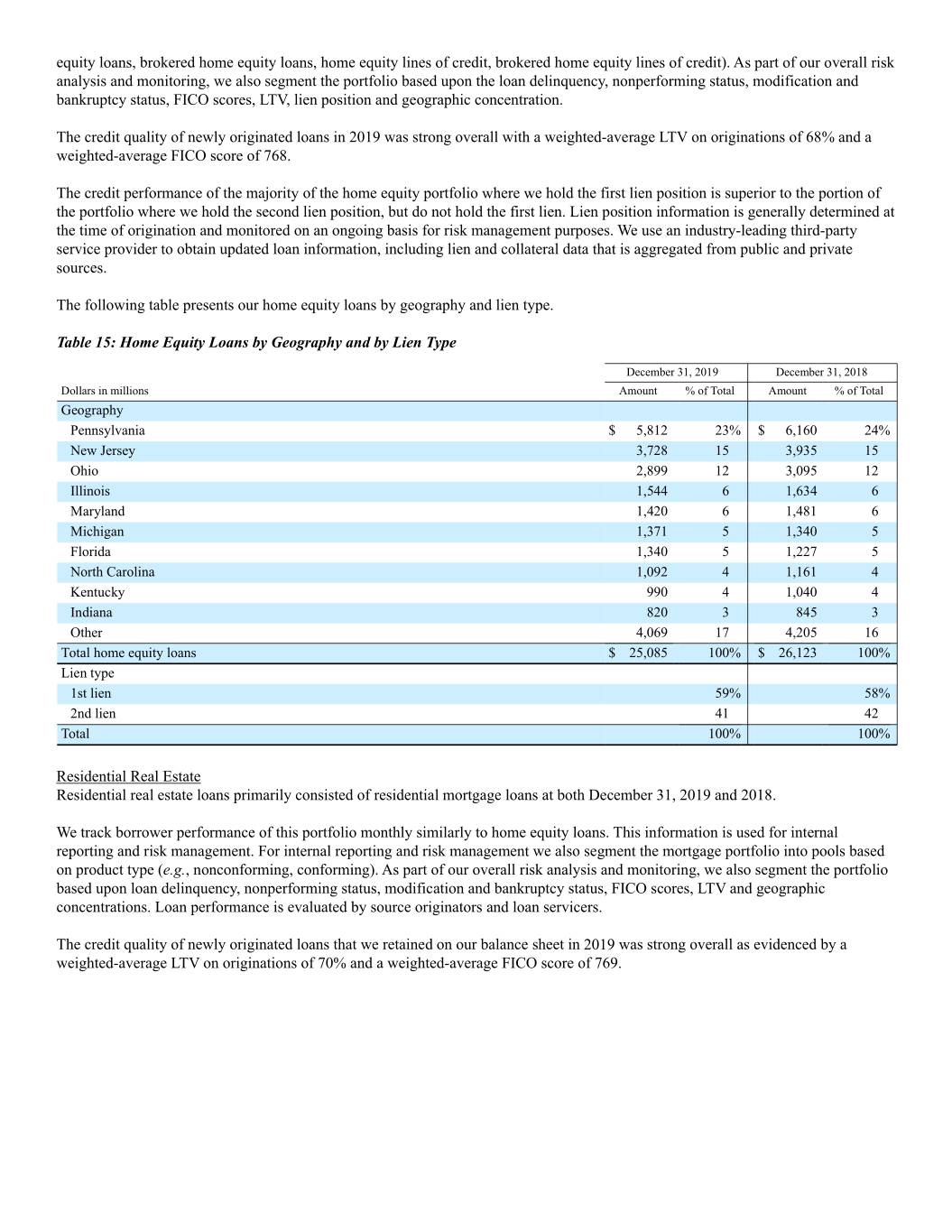
equity loans, brokered home equity loans, home equity lines of credit, brokered home equity lines of credit). As part of our overall risk analysis and monitoring, we also segment the portfolio based upon the loan delinquency, nonperforming status, modification and bankruptcy status, FICO scores, LTV, lien position and geographic concentration. The credit quality of newly originated loans in 2019 was strong overall with a weighted-average LTV on originations of 68% and a weighted-average FICO score of 768. The credit performance of the majority of the home equity portfolio where we hold the first lien position is superior to the portion of the portfolio where we hold the second lien position, but do not hold the first lien. Lien position information is generally determined at the time of origination and monitored on an ongoing basis for risk management purposes. We use an industry-leading third-party service provider to obtain updated loan information, including lien and collateral data that is aggregated from public and private sources. The following table presents our home equity loans by geography and lien type. Table 15: Home Equity Loans by Geography and by Lien Type December 31, 2019 December 31, 2018 Dollars in millions Amount % of Total Amount % of Total Geography Pennsylvania $ 5,812 23% $ 6,160 24% New Jersey 3,728 15 3,935 15 Ohio 2,899 12 3,095 12 Illinois 1,544 6 1,634 6 Maryland 1,420 6 1,481 6 Michigan 1,371 5 1,340 5 Florida 1,340 5 1,227 5 North Carolina 1,092 4 1,161 4 Kentucky 990 4 1,040 4 Indiana 820 3 845 3 Other 4,069 17 4,205 16 Total home equity loans $ 25,085 100% $ 26,123 100% Lien type 1st lien 59% 58% 2nd lien 41 42 Total 100% 100% Residential Real Estate Residential real estate loans primarily consisted of residential mortgage loans at both December 31, 2019 and 2018. We track borrower performance of this portfolio monthly similarly to home equity loans. This information is used for internal reporting and risk management. For internal reporting and risk management we also segment the mortgage portfolio into pools based on product type (e.g., nonconforming, conforming). As part of our overall risk analysis and monitoring, we also segment the portfolio based upon loan delinquency, nonperforming status, modification and bankruptcy status, FICO scores, LTV and geographic concentrations. Loan performance is evaluated by source originators and loan servicers. The credit quality of newly originated loans that we retained on our balance sheet in 2019 was strong overall as evidenced by a weighted-average LTV on originations of 70% and a weighted-average FICO score of 769.
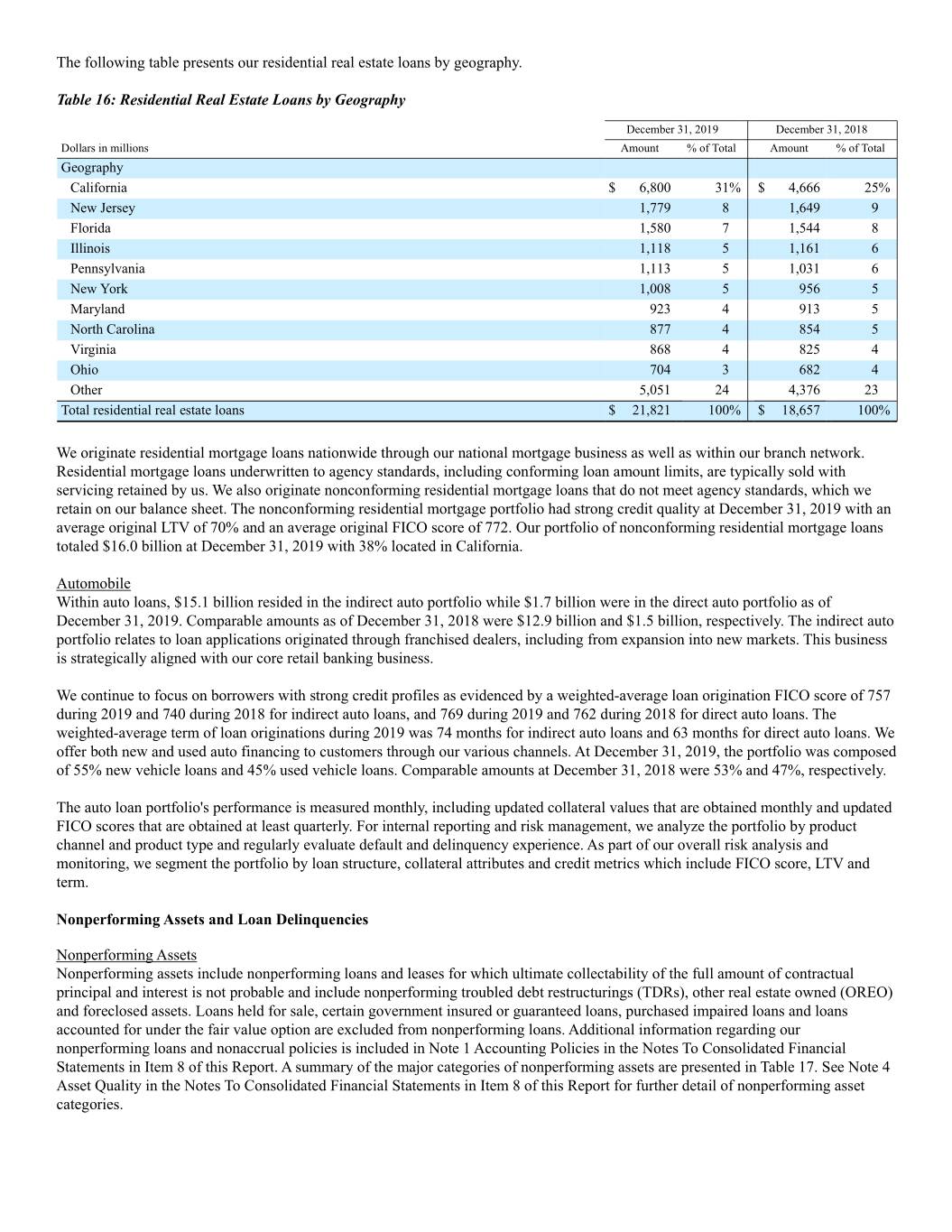
The following table presents our residential real estate loans by geography. Table 16: Residential Real Estate Loans by Geography December 31, 2019 December 31, 2018 Dollars in millions Amount % of Total Amount % of Total Geography California $ 6,800 31% $ 4,666 25% New Jersey 1,779 8 1,649 9 Florida 1,580 7 1,544 8 Illinois 1,118 5 1,161 6 Pennsylvania 1,113 5 1,031 6 New York 1,008 5 956 5 Maryland 923 4 913 5 North Carolina 877 4 854 5 Virginia 868 4 825 4 Ohio 704 3 682 4 Other 5,051 24 4,376 23 Total residential real estate loans $ 21,821 100% $ 18,657 100% We originate residential mortgage loans nationwide through our national mortgage business as well as within our branch network. Residential mortgage loans underwritten to agency standards, including conforming loan amount limits, are typically sold with servicing retained by us. We also originate nonconforming residential mortgage loans that do not meet agency standards, which we retain on our balance sheet. The nonconforming residential mortgage portfolio had strong credit quality at December 31, 2019 with an average original LTV of 70% and an average original FICO score of 772. Our portfolio of nonconforming residential mortgage loans totaled $16.0 billion at December 31, 2019 with 38% located in California. Automobile Within auto loans, $15.1 billion resided in the indirect auto portfolio while $1.7 billion were in the direct auto portfolio as of December 31, 2019. Comparable amounts as of December 31, 2018 were $12.9 billion and $1.5 billion, respectively. The indirect auto portfolio relates to loan applications originated through franchised dealers, including from expansion into new markets. This business is strategically aligned with our core retail banking business. We continue to focus on borrowers with strong credit profiles as evidenced by a weighted-average loan origination FICO score of 757 during 2019 and 740 during 2018 for indirect auto loans, and 769 during 2019 and 762 during 2018 for direct auto loans. The weighted-average term of loan originations during 2019 was 74 months for indirect auto loans and 63 months for direct auto loans. We offer both new and used auto financing to customers through our various channels. At December 31, 2019, the portfolio was composed of 55% new vehicle loans and 45% used vehicle loans. Comparable amounts at December 31, 2018 were 53% and 47%, respectively. The auto loan portfolio's performance is measured monthly, including updated collateral values that are obtained monthly and updated FICO scores that are obtained at least quarterly. For internal reporting and risk management, we analyze the portfolio by product channel and product type and regularly evaluate default and delinquency experience. As part of our overall risk analysis and monitoring, we segment the portfolio by loan structure, collateral attributes and credit metrics which include FICO score, LTV and term. Nonperforming Assets and Loan Delinquencies Nonperforming Assets Nonperforming assets include nonperforming loans and leases for which ultimate collectability of the full amount of contractual principal and interest is not probable and include nonperforming troubled debt restructurings (TDRs), other real estate owned (OREO) and foreclosed assets. Loans held for sale, certain government insured or guaranteed loans, purchased impaired loans and loans accounted for under the fair value option are excluded from nonperforming loans. Additional information regarding our nonperforming loans and nonaccrual policies is included in Note 1 Accounting Policies in the Notes To Consolidated Financial Statements in Item 8 of this Report. A summary of the major categories of nonperforming assets are presented in Table 17. See Note 4 Asset Quality in the Notes To Consolidated Financial Statements in Item 8 of this Report for further detail of nonperforming asset categories.
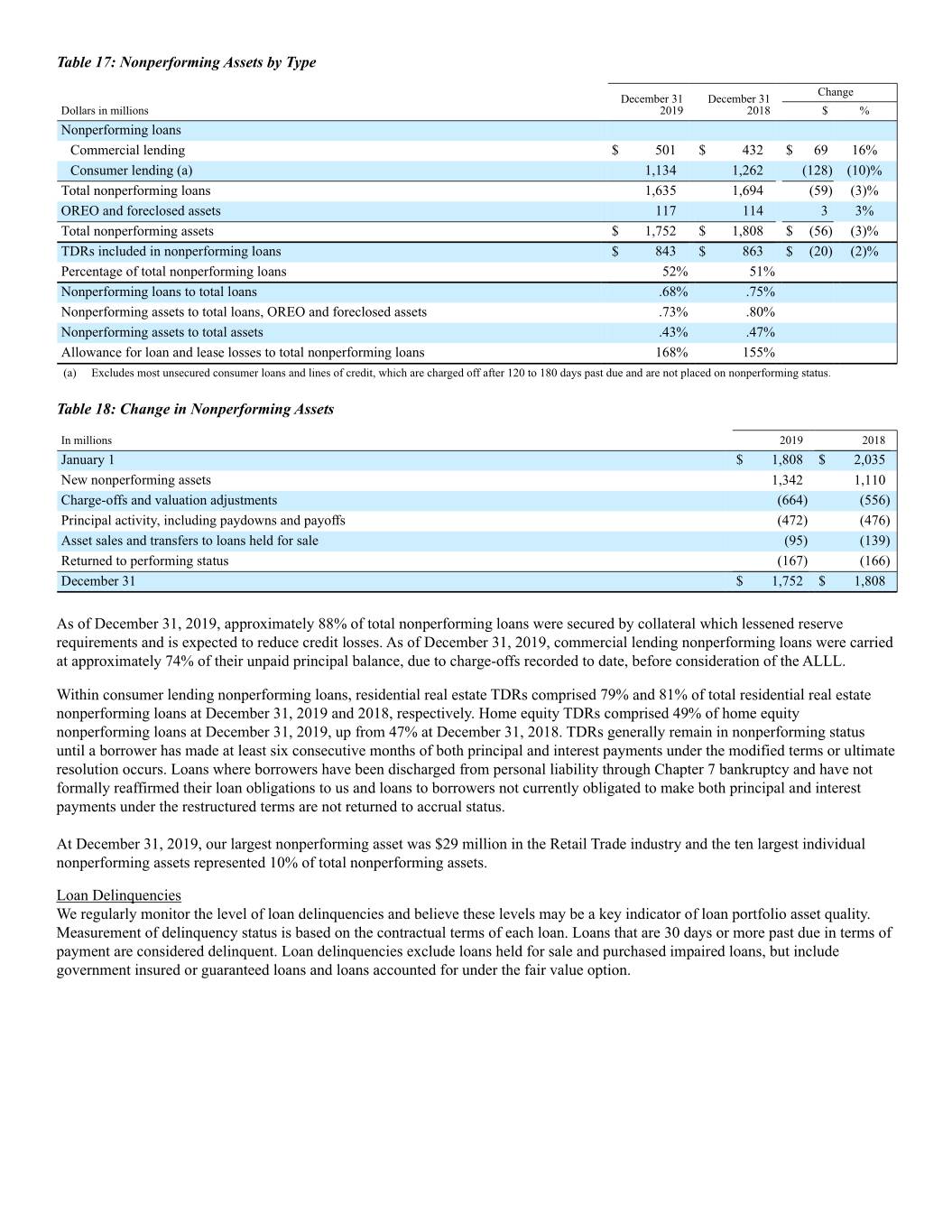
Table 17: Nonperforming Assets by Type Change December 31 December 31 Dollars in millions 2019 2018 $ % Nonperforming loans Commercial lending $ 501 $ 432 $ 69 16% Consumer lending (a) 1,134 1,262 (128) (10)% Total nonperforming loans 1,635 1,694 (59) (3)% OREO and foreclosed assets 117 114 3 3% Total nonperforming assets $ 1,752 $ 1,808 $ (56) (3)% TDRs included in nonperforming loans $ 843 $ 863 $ (20) (2)% Percentage of total nonperforming loans 52% 51% Nonperforming loans to total loans .68% .75% Nonperforming assets to total loans, OREO and foreclosed assets .73% .80% Nonperforming assets to total assets .43% .47% Allowance for loan and lease losses to total nonperforming loans 168% 155% (a) Excludes most unsecured consumer loans and lines of credit, which are charged off after 120 to 180 days past due and are not placed on nonperforming status. Table 18: Change in Nonperforming Assets In millions 2019 2018 January 1 $ 1,808 $ 2,035 New nonperforming assets 1,342 1,110 Charge-offs and valuation adjustments (664) (556) Principal activity, including paydowns and payoffs (472) (476) Asset sales and transfers to loans held for sale (95) (139) Returned to performing status (167) (166) December 31 $ 1,752 $ 1,808 As of December 31, 2019, approximately 88% of total nonperforming loans were secured by collateral which lessened reserve requirements and is expected to reduce credit losses. As of December 31, 2019, commercial lending nonperforming loans were carried at approximately 74% of their unpaid principal balance, due to charge-offs recorded to date, before consideration of the ALLL. Within consumer lending nonperforming loans, residential real estate TDRs comprised 79% and 81% of total residential real estate nonperforming loans at December 31, 2019 and 2018, respectively. Home equity TDRs comprised 49% of home equity nonperforming loans at December 31, 2019, up from 47% at December 31, 2018. TDRs generally remain in nonperforming status until a borrower has made at least six consecutive months of both principal and interest payments under the modified terms or ultimate resolution occurs. Loans where borrowers have been discharged from personal liability through Chapter 7 bankruptcy and have not formally reaffirmed their loan obligations to us and loans to borrowers not currently obligated to make both principal and interest payments under the restructured terms are not returned to accrual status. At December 31, 2019, our largest nonperforming asset was $29 million in the Retail Trade industry and the ten largest individual nonperforming assets represented 10% of total nonperforming assets. Loan Delinquencies We regularly monitor the level of loan delinquencies and believe these levels may be a key indicator of loan portfolio asset quality. Measurement of delinquency status is based on the contractual terms of each loan. Loans that are 30 days or more past due in terms of payment are considered delinquent. Loan delinquencies exclude loans held for sale and purchased impaired loans, but include government insured or guaranteed loans and loans accounted for under the fair value option.
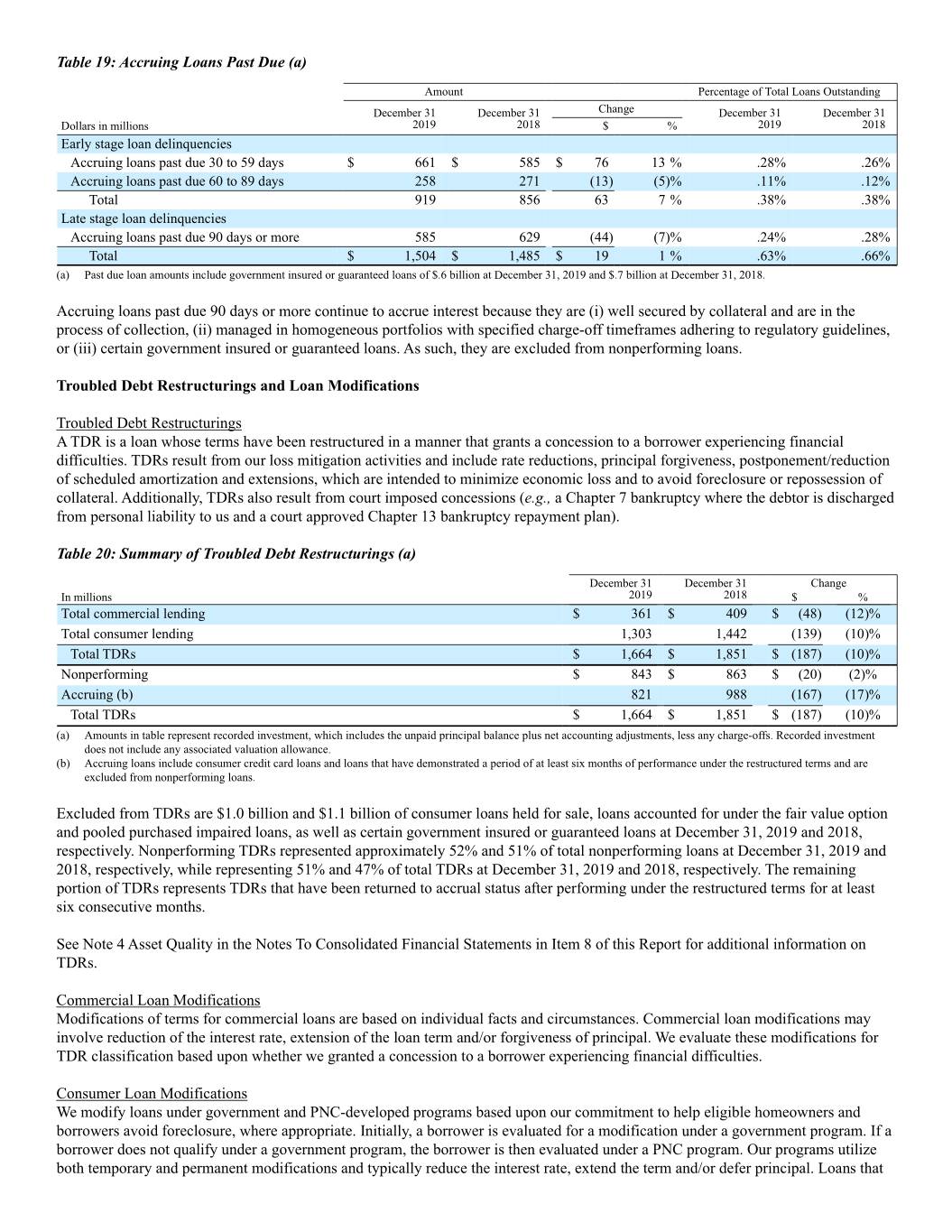
Table 19: Accruing Loans Past Due (a) Amount Percentage of Total Loans Outstanding December 31 December 31 Change December 31 December 31 Dollars in millions 2019 2018 $ % 2019 2018 Early stage loan delinquencies Accruing loans past due 30 to 59 days $ 661 $ 585 $ 76 13 % .28% .26% Accruing loans past due 60 to 89 days 258 271 (13) (5)% .11% .12% Total 919 856 63 7 % .38% .38% Late stage loan delinquencies Accruing loans past due 90 days or more 585 629 (44) (7)% .24% .28% Total $ 1,504 $ 1,485 $ 19 1 % .63% .66% (a) Past due loan amounts include government insured or guaranteed loans of $.6 billion at December 31, 2019 and $.7 billion at December 31, 2018. Accruing loans past due 90 days or more continue to accrue interest because they are (i) well secured by collateral and are in the process of collection, (ii) managed in homogeneous portfolios with specified charge-off timeframes adhering to regulatory guidelines, or (iii) certain government insured or guaranteed loans. As such, they are excluded from nonperforming loans. Troubled Debt Restructurings and Loan Modifications Troubled Debt Restructurings A TDR is a loan whose terms have been restructured in a manner that grants a concession to a borrower experiencing financial difficulties. TDRs result from our loss mitigation activities and include rate reductions, principal forgiveness, postponement/reduction of scheduled amortization and extensions, which are intended to minimize economic loss and to avoid foreclosure or repossession of collateral. Additionally, TDRs also result from court imposed concessions (e.g., a Chapter 7 bankruptcy where the debtor is discharged from personal liability to us and a court approved Chapter 13 bankruptcy repayment plan). Table 20: Summary of Troubled Debt Restructurings (a) December 31 December 31 Change In millions 2019 2018 $ % Total commercial lending $ 361 $ 409 $ (48) (12)% Total consumer lending 1,303 1,442 (139) (10)% Total TDRs $ 1,664 $ 1,851 $ (187) (10)% Nonperforming $ 843 $ 863 $ (20) (2)% Accruing (b) 821 988 (167) (17)% Total TDRs $ 1,664 $ 1,851 $ (187) (10)% (a) Amounts in table represent recorded investment, which includes the unpaid principal balance plus net accounting adjustments, less any charge-offs. Recorded investment does not include any associated valuation allowance. (b) Accruing loans include consumer credit card loans and loans that have demonstrated a period of at least six months of performance under the restructured terms and are excluded from nonperforming loans. Excluded from TDRs are $1.0 billion and $1.1 billion of consumer loans held for sale, loans accounted for under the fair value option and pooled purchased impaired loans, as well as certain government insured or guaranteed loans at December 31, 2019 and 2018, respectively. Nonperforming TDRs represented approximately 52% and 51% of total nonperforming loans at December 31, 2019 and 2018, respectively, while representing 51% and 47% of total TDRs at December 31, 2019 and 2018, respectively. The remaining portion of TDRs represents TDRs that have been returned to accrual status after performing under the restructured terms for at least six consecutive months. See Note 4 Asset Quality in the Notes To Consolidated Financial Statements in Item 8 of this Report for additional information on TDRs. Commercial Loan Modifications Modifications of terms for commercial loans are based on individual facts and circumstances. Commercial loan modifications may involve reduction of the interest rate, extension of the loan term and/or forgiveness of principal. We evaluate these modifications for TDR classification based upon whether we granted a concession to a borrower experiencing financial difficulties. Consumer Loan Modifications We modify loans under government and PNC-developed programs based upon our commitment to help eligible homeowners and borrowers avoid foreclosure, where appropriate. Initially, a borrower is evaluated for a modification under a government program. If a borrower does not qualify under a government program, the borrower is then evaluated under a PNC program. Our programs utilize both temporary and permanent modifications and typically reduce the interest rate, extend the term and/or defer principal. Loans that
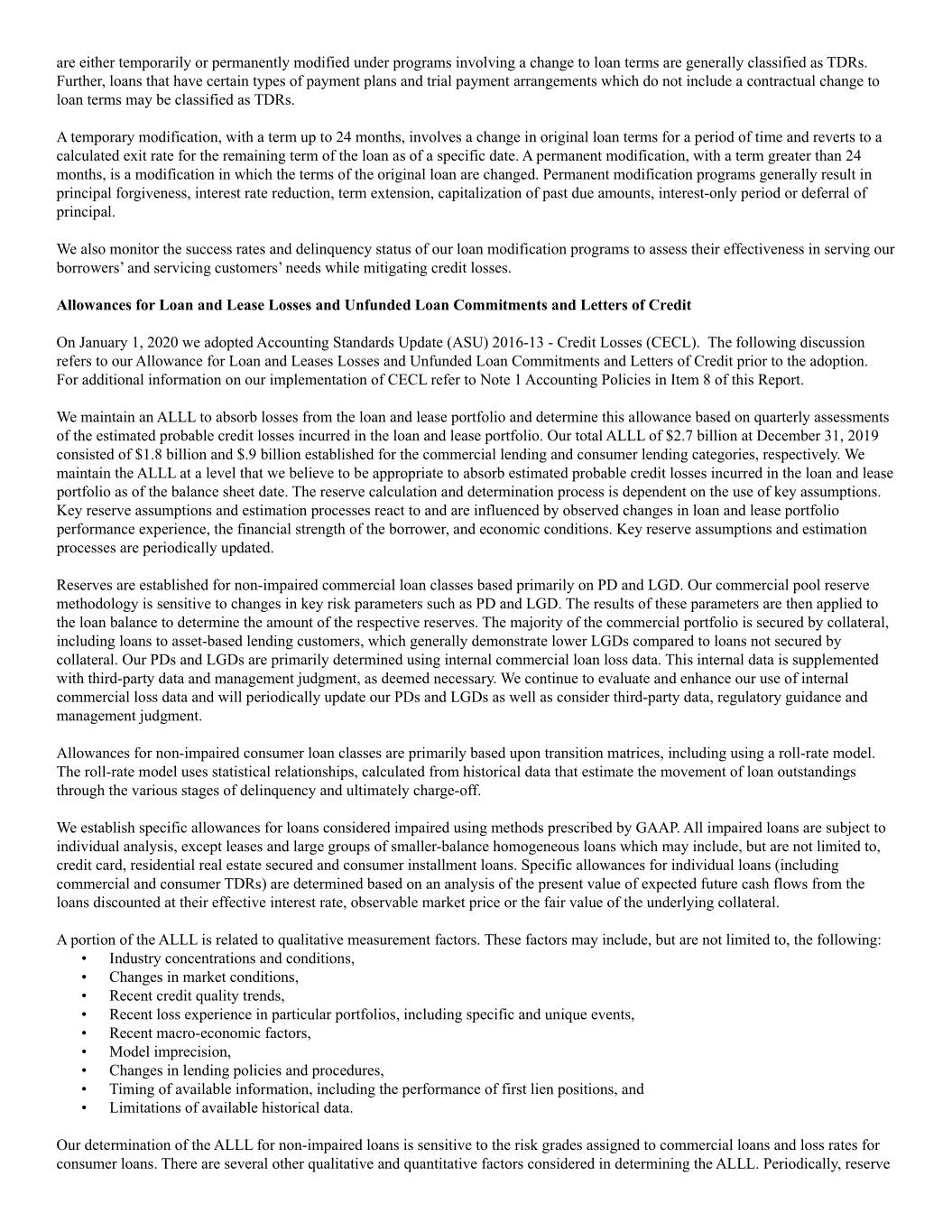
are either temporarily or permanently modified under programs involving a change to loan terms are generally classified as TDRs. Further, loans that have certain types of payment plans and trial payment arrangements which do not include a contractual change to loan terms may be classified as TDRs. A temporary modification, with a term up to 24 months, involves a change in original loan terms for a period of time and reverts to a calculated exit rate for the remaining term of the loan as of a specific date. A permanent modification, with a term greater than 24 months, is a modification in which the terms of the original loan are changed. Permanent modification programs generally result in principal forgiveness, interest rate reduction, term extension, capitalization of past due amounts, interest-only period or deferral of principal. We also monitor the success rates and delinquency status of our loan modification programs to assess their effectiveness in serving our borrowers’ and servicing customers’ needs while mitigating credit losses. Allowances for Loan and Lease Losses and Unfunded Loan Commitments and Letters of Credit On January 1, 2020 we adopted Accounting Standards Update (ASU) 2016-13 - Credit Losses (CECL). The following discussion refers to our Allowance for Loan and Leases Losses and Unfunded Loan Commitments and Letters of Credit prior to the adoption. For additional information on our implementation of CECL refer to Note 1 Accounting Policies in Item 8 of this Report. We maintain an ALLL to absorb losses from the loan and lease portfolio and determine this allowance based on quarterly assessments of the estimated probable credit losses incurred in the loan and lease portfolio. Our total ALLL of $2.7 billion at December 31, 2019 consisted of $1.8 billion and $.9 billion established for the commercial lending and consumer lending categories, respectively. We maintain the ALLL at a level that we believe to be appropriate to absorb estimated probable credit losses incurred in the loan and lease portfolio as of the balance sheet date. The reserve calculation and determination process is dependent on the use of key assumptions. Key reserve assumptions and estimation processes react to and are influenced by observed changes in loan and lease portfolio performance experience, the financial strength of the borrower, and economic conditions. Key reserve assumptions and estimation processes are periodically updated. Reserves are established for non-impaired commercial loan classes based primarily on PD and LGD. Our commercial pool reserve methodology is sensitive to changes in key risk parameters such as PD and LGD. The results of these parameters are then applied to the loan balance to determine the amount of the respective reserves. The majority of the commercial portfolio is secured by collateral, including loans to asset-based lending customers, which generally demonstrate lower LGDs compared to loans not secured by collateral. Our PDs and LGDs are primarily determined using internal commercial loan loss data. This internal data is supplemented with third-party data and management judgment, as deemed necessary. We continue to evaluate and enhance our use of internal commercial loss data and will periodically update our PDs and LGDs as well as consider third-party data, regulatory guidance and management judgment. Allowances for non-impaired consumer loan classes are primarily based upon transition matrices, including using a roll-rate model. The roll-rate model uses statistical relationships, calculated from historical data that estimate the movement of loan outstandings through the various stages of delinquency and ultimately charge-off. We establish specific allowances for loans considered impaired using methods prescribed by GAAP. All impaired loans are subject to individual analysis, except leases and large groups of smaller-balance homogeneous loans which may include, but are not limited to, credit card, residential real estate secured and consumer installment loans. Specific allowances for individual loans (including commercial and consumer TDRs) are determined based on an analysis of the present value of expected future cash flows from the loans discounted at their effective interest rate, observable market price or the fair value of the underlying collateral. A portion of the ALLL is related to qualitative measurement factors. These factors may include, but are not limited to, the following: • Industry concentrations and conditions, • Changes in market conditions, • Recent credit quality trends, • Recent loss experience in particular portfolios, including specific and unique events, • Recent macro-economic factors, • Model imprecision, • Changes in lending policies and procedures, • Timing of available information, including the performance of first lien positions, and • Limitations of available historical data. Our determination of the ALLL for non-impaired loans is sensitive to the risk grades assigned to commercial loans and loss rates for consumer loans. There are several other qualitative and quantitative factors considered in determining the ALLL. Periodically, reserve
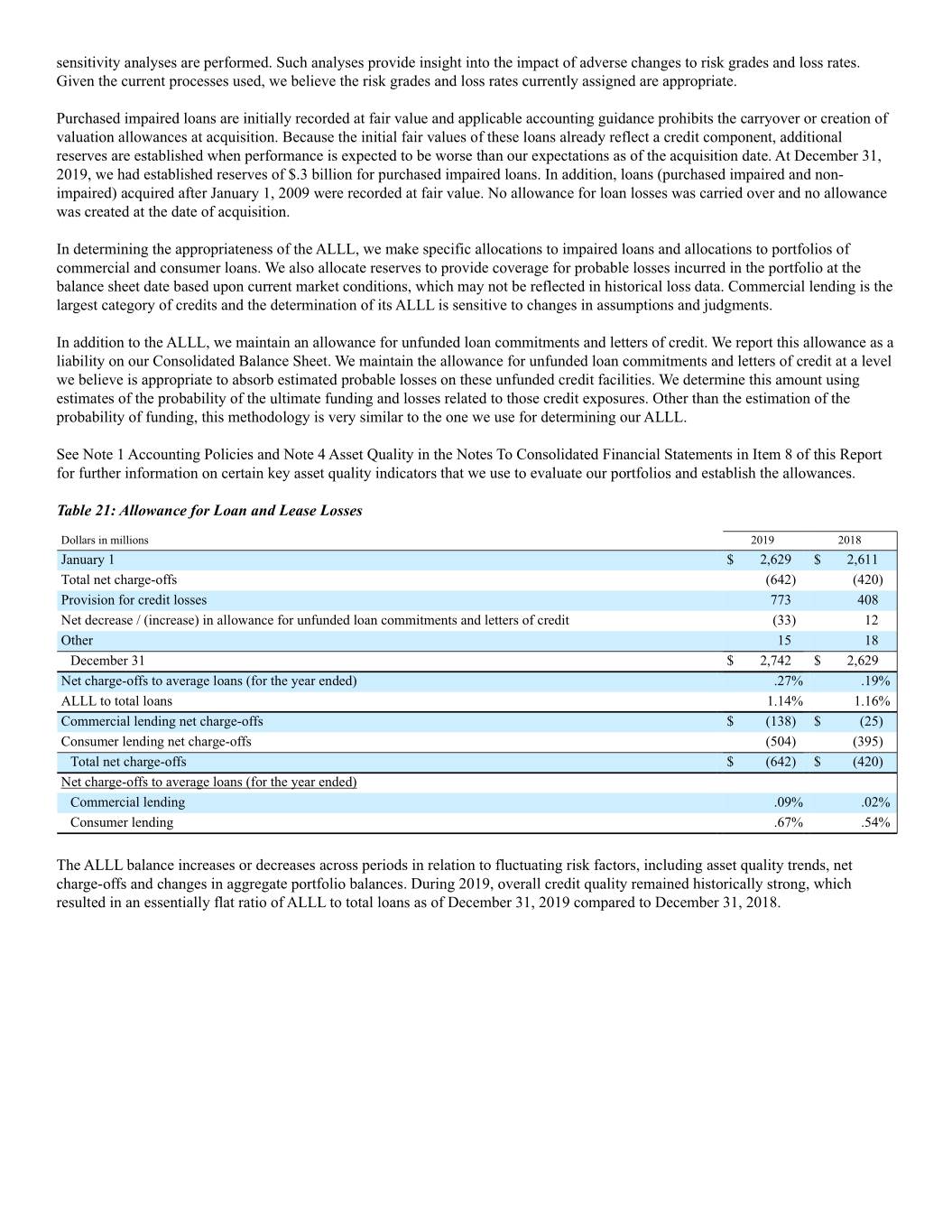
sensitivity analyses are performed. Such analyses provide insight into the impact of adverse changes to risk grades and loss rates. Given the current processes used, we believe the risk grades and loss rates currently assigned are appropriate. Purchased impaired loans are initially recorded at fair value and applicable accounting guidance prohibits the carryover or creation of valuation allowances at acquisition. Because the initial fair values of these loans already reflect a credit component, additional reserves are established when performance is expected to be worse than our expectations as of the acquisition date. At December 31, 2019, we had established reserves of $.3 billion for purchased impaired loans. In addition, loans (purchased impaired and non- impaired) acquired after January 1, 2009 were recorded at fair value. No allowance for loan losses was carried over and no allowance was created at the date of acquisition. In determining the appropriateness of the ALLL, we make specific allocations to impaired loans and allocations to portfolios of commercial and consumer loans. We also allocate reserves to provide coverage for probable losses incurred in the portfolio at the balance sheet date based upon current market conditions, which may not be reflected in historical loss data. Commercial lending is the largest category of credits and the determination of its ALLL is sensitive to changes in assumptions and judgments. In addition to the ALLL, we maintain an allowance for unfunded loan commitments and letters of credit. We report this allowance as a liability on our Consolidated Balance Sheet. We maintain the allowance for unfunded loan commitments and letters of credit at a level we believe is appropriate to absorb estimated probable losses on these unfunded credit facilities. We determine this amount using estimates of the probability of the ultimate funding and losses related to those credit exposures. Other than the estimation of the probability of funding, this methodology is very similar to the one we use for determining our ALLL. See Note 1 Accounting Policies and Note 4 Asset Quality in the Notes To Consolidated Financial Statements in Item 8 of this Report for further information on certain key asset quality indicators that we use to evaluate our portfolios and establish the allowances. Table 21: Allowance for Loan and Lease Losses Dollars in millions 2019 2018 January 1 $ 2,629 $ 2,611 Total net charge-offs (642) (420) Provision for credit losses 773 408 Net decrease / (increase) in allowance for unfunded loan commitments and letters of credit (33) 12 Other 15 18 December 31 $ 2,742 $ 2,629 Net charge-offs to average loans (for the year ended) .27% .19% ALLL to total loans 1.14% 1.16% Commercial lending net charge-offs $ (138) $ (25) Consumer lending net charge-offs (504) (395) Total net charge-offs $ (642) $ (420) Net charge-offs to average loans (for the year ended) Commercial lending .09% .02% Consumer lending .67% .54% The ALLL balance increases or decreases across periods in relation to fluctuating risk factors, including asset quality trends, net charge-offs and changes in aggregate portfolio balances. During 2019, overall credit quality remained historically strong, which resulted in an essentially flat ratio of ALLL to total loans as of December 31, 2019 compared to December 31, 2018.
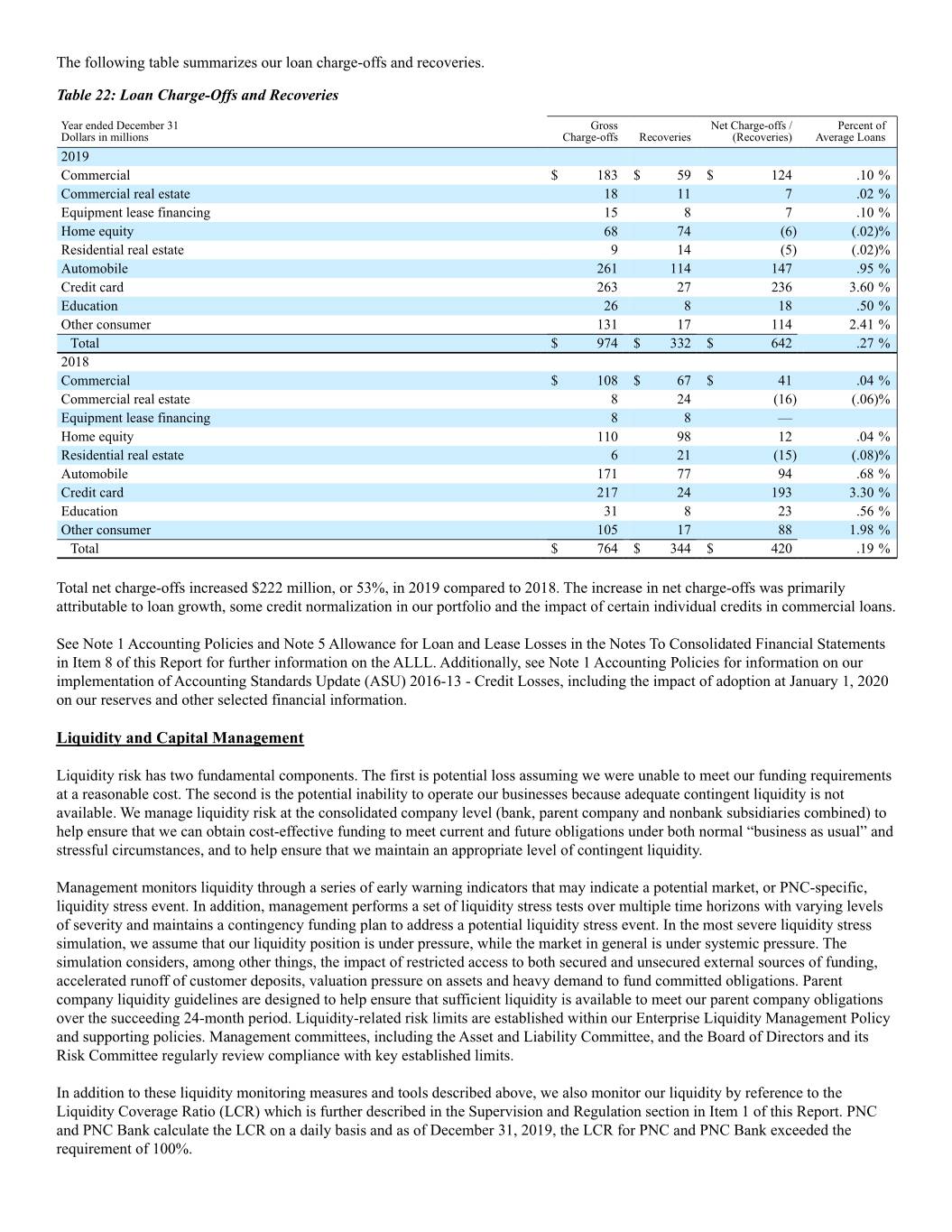
The following table summarizes our loan charge-offs and recoveries. Table 22: Loan Charge-Offs and Recoveries Year ended December 31 Gross Net Charge-offs / Percent of Dollars in millions Charge-offs Recoveries (Recoveries) Average Loans 2019 Commercial $ 183 $ 59 $ 124 .10 % Commercial real estate 18 11 7 .02 % Equipment lease financing 15 8 7 .10 % Home equity 68 74 (6) (.02)% Residential real estate 9 14 (5) (.02)% Automobile 261 114 147 .95 % Credit card 263 27 236 3.60 % Education 26 8 18 .50 % Other consumer 131 17 114 2.41 % Total $ 974 $ 332 $ 642 .27 % 2018 Commercial $ 108 $ 67 $ 41 .04 % Commercial real estate 8 24 (16) (.06)% Equipment lease financing 8 8 — Home equity 110 98 12 .04 % Residential real estate 6 21 (15) (.08)% Automobile 171 77 94 .68 % Credit card 217 24 193 3.30 % Education 31 8 23 .56 % Other consumer 105 17 88 1.98 % Total $ 764 $ 344 $ 420 .19 % Total net charge-offs increased $222 million, or 53%, in 2019 compared to 2018. The increase in net charge-offs was primarily attributable to loan growth, some credit normalization in our portfolio and the impact of certain individual credits in commercial loans. See Note 1 Accounting Policies and Note 5 Allowance for Loan and Lease Losses in the Notes To Consolidated Financial Statements in Item 8 of this Report for further information on the ALLL. Additionally, see Note 1 Accounting Policies for information on our implementation of Accounting Standards Update (ASU) 2016-13 - Credit Losses, including the impact of adoption at January 1, 2020 on our reserves and other selected financial information. Liquidity and Capital Management Liquidity risk has two fundamental components. The first is potential loss assuming we were unable to meet our funding requirements at a reasonable cost. The second is the potential inability to operate our businesses because adequate contingent liquidity is not available. We manage liquidity risk at the consolidated company level (bank, parent company and nonbank subsidiaries combined) to help ensure that we can obtain cost-effective funding to meet current and future obligations under both normal “business as usual” and stressful circumstances, and to help ensure that we maintain an appropriate level of contingent liquidity. Management monitors liquidity through a series of early warning indicators that may indicate a potential market, or PNC-specific, liquidity stress event. In addition, management performs a set of liquidity stress tests over multiple time horizons with varying levels of severity and maintains a contingency funding plan to address a potential liquidity stress event. In the most severe liquidity stress simulation, we assume that our liquidity position is under pressure, while the market in general is under systemic pressure. The simulation considers, among other things, the impact of restricted access to both secured and unsecured external sources of funding, accelerated runoff of customer deposits, valuation pressure on assets and heavy demand to fund committed obligations. Parent company liquidity guidelines are designed to help ensure that sufficient liquidity is available to meet our parent company obligations over the succeeding 24-month period. Liquidity-related risk limits are established within our Enterprise Liquidity Management Policy and supporting policies. Management committees, including the Asset and Liability Committee, and the Board of Directors and its Risk Committee regularly review compliance with key established limits. In addition to these liquidity monitoring measures and tools described above, we also monitor our liquidity by reference to the Liquidity Coverage Ratio (LCR) which is further described in the Supervision and Regulation section in Item 1 of this Report. PNC and PNC Bank calculate the LCR on a daily basis and as of December 31, 2019, the LCR for PNC and PNC Bank exceeded the requirement of 100%.

We provide additional information regarding regulatory liquidity requirements, including information on the 2019 Tailoring Rules, and their potential impact on us in the Supervision and Regulation section of Item 1 Business and Item 1A Risk Factors of this Report. Sources of Liquidity Our largest source of liquidity on a consolidated basis is the customer deposit base generated by our banking businesses. These deposits provide relatively stable and low-cost funding. Total deposits increased to $288.5 billion at December 31, 2019 from $267.8 billion at December 31, 2018 driven by growth in interest-bearing deposits partially offset by a decrease in noninterest-bearing deposits. See the Funding Sources section of the Consolidated Balance Sheet Review in this Item 7 for additional information related to our deposits. Additionally, certain assets determined by us to be liquid as well as unused borrowing capacity from a number of sources are also available to manage our liquidity position. At December 31, 2019, our liquid assets consisted of cash and due from banks and short-term investments (federal funds sold, resale agreements, trading securities and interest-earning deposits with banks) totaling $34.1 billion and securities available for sale totaling $69.2 billion. The level of liquid assets fluctuates over time based on many factors, including market conditions, loan and deposit growth and balance sheet management activities. Our liquid assets included $14.0 billion of securities available for sale and trading securities pledged as collateral to secure public and trust deposits, repurchase agreements and for other purposes. In addition, $.6 billion of securities held to maturity were also pledged as collateral for these purposes. We also obtain liquidity through various forms of funding, including long-term debt (senior notes, subordinated debt and FHLB borrowings) and short-term borrowings (federal funds purchased, securities sold under repurchase agreements, commercial paper and other short-term borrowings). See Note 11 Borrowed Funds in the Notes To Consolidated Financial Statements in Item 8 and the Funding Sources section of the Consolidated Balance Sheet Review in this Item 7 for additional information related to our borrowings. Total senior and subordinated debt, on a consolidated basis, increased due to the following activity: Table 23: Senior and Subordinated Debt In billions 2019 January 1 $ 30.9 Issuances 9.7 Calls and maturities (6.3) Other .8 December 31 $ 35.1 Bank Liquidity Under PNC Bank’s 2014 bank note program, as amended, PNC Bank may from time to time offer up to $40.0 billion aggregate principal amount outstanding at any one time of its unsecured senior and subordinated notes with maturity dates more than nine months (in the case of senior notes) and five years or more (in the case of subordinated notes) from their date of issue. At December 31, 2019, PNC Bank had $25.0 billion of notes outstanding under this program of which $20.0 billion were senior bank notes and $5.0 billion were subordinated bank notes. The following table details issuances for the three months ended December 31, 2019.

Table 24: PNC Bank Notes Issued Issuance Date Amount Description of Issuance October 22, 2019 $750 million Subordinated notes with a maturity date of October 22, 2029. Interest is payable semi-annually at a fixed rate of 2.70% per annum, on April 22 and October 22 of each year, beginning April 22, 2020. December 9, 2019 $750 million Senior floating rate notes with a maturity date of December 9, 2022. Redeemable in whole, but not in part, on or after December 9, 2021, and in whole or in part on or after November 9, 2022. Interest is payable quarterly, at the 3-month LIBOR rate plus 43 basis points, on March 9, June 9, September 9 and December 9 of each year, beginning March 9, 2020. December 9, 2019 $650 million Senior fixed-to-floating rate notes with a maturity date of December 9, 2022. Redeemable in whole, but not in part, on December 9, 2021, and in whole or in part on or after November 9, 2022. From the issue date of the notes to, but excluding, December 9, 2021, interest is payable semi-annually at a fixed rate of 2.028% per annum on December 9 and June 9 of each year, beginning June 9, 2020. Beginning on December 9, 2021, interest is payable quarterly, at the 3-month LIBOR rate, reset quarterly, plus 42 basis points, on March 9, June 9, September 9, and December 9, beginning on March 9, 2022. See Note 26 Subsequent Events for information on the February 2020 issuances of $1.0 billion of senior floating rate notes and $500 million of senior fixed-to-floating rate notes by PNC Bank. PNC Bank maintains additional secured borrowing capacity with the FHLB-Pittsburgh and through the Federal Reserve Bank discount window. The Federal Reserve Bank, however, is not viewed as a primary means of funding our routine business activities, but rather as a potential source of liquidity in a stressed environment or during a market disruption. At December 31, 2019, our unused secured borrowing capacity at the FHLB-Pittsburgh and the Federal Reserve Bank totaled $51.4 billion. PNC Bank has the ability to offer up to $10.0 billion of its commercial paper to provide additional liquidity. As of December 31, 2019, there were no issuances outstanding under this program. Parent Company Liquidity In addition to managing liquidity risk at the bank level, we monitor the parent company’s liquidity. The parent company’s contractual obligations consist primarily of debt service related to parent company borrowings and funding non-bank affiliates. Additionally, the parent company maintains adequate liquidity to fund discretionary activities such as paying dividends to our shareholders, share repurchases and acquisitions. As of December 31, 2019, available parent company liquidity totaled $6.7 billion. Parent company liquidity is primarily held in intercompany short-term investments, the terms of which provide for the availability of cash in 31 days or less. Investments with longer durations may also be acquired, but if so, the related maturities are aligned with scheduled cash needs, such as the maturity of parent company debt obligations. The principal source of parent company liquidity is the dividends it receives from PNC Bank, which may be impacted by the following: • Bank-level capital needs; • Laws and regulations; • Corporate policies; • Contractual restrictions; and • Other factors. There are statutory and regulatory limitations on the ability of a national bank to pay dividends or make other capital distributions or to extend credit to the parent company or its non-bank subsidiaries. The amount available for dividend payments by PNC Bank to the parent company without prior regulatory approval was approximately $3.1 billion at December 31, 2019. See Note 19 Regulatory Matters in the Notes To Consolidated Financial Statements in Item 8 of this Report for a further discussion of these limitations. In addition to dividends from PNC Bank, other sources of parent company liquidity include cash and investments, as well as dividends and loan repayments from other subsidiaries and dividends or distributions from equity investments. We can also generate liquidity for the parent company and PNC’s non-bank subsidiaries through the issuance of debt and equity securities, including certain capital instruments, in public or private markets and commercial paper. Authorized by the Board of Directors, the parent company has the ability to offer up to $5.0 billion of commercial paper to provide additional liquidity. As of December 31, 2019 there were no commercial paper issuances outstanding. The parent company has an effective shelf registration statement pursuant to which we can issue additional debt, equity and other capital instruments. On November 1, 2019, the parent company issued $650 million of senior notes with a maturity date of November 1, 2024, redeemable in whole or in part, on or after October 2, 2024. Interest is payable semi-annually at a fixed rate of 2.20% per
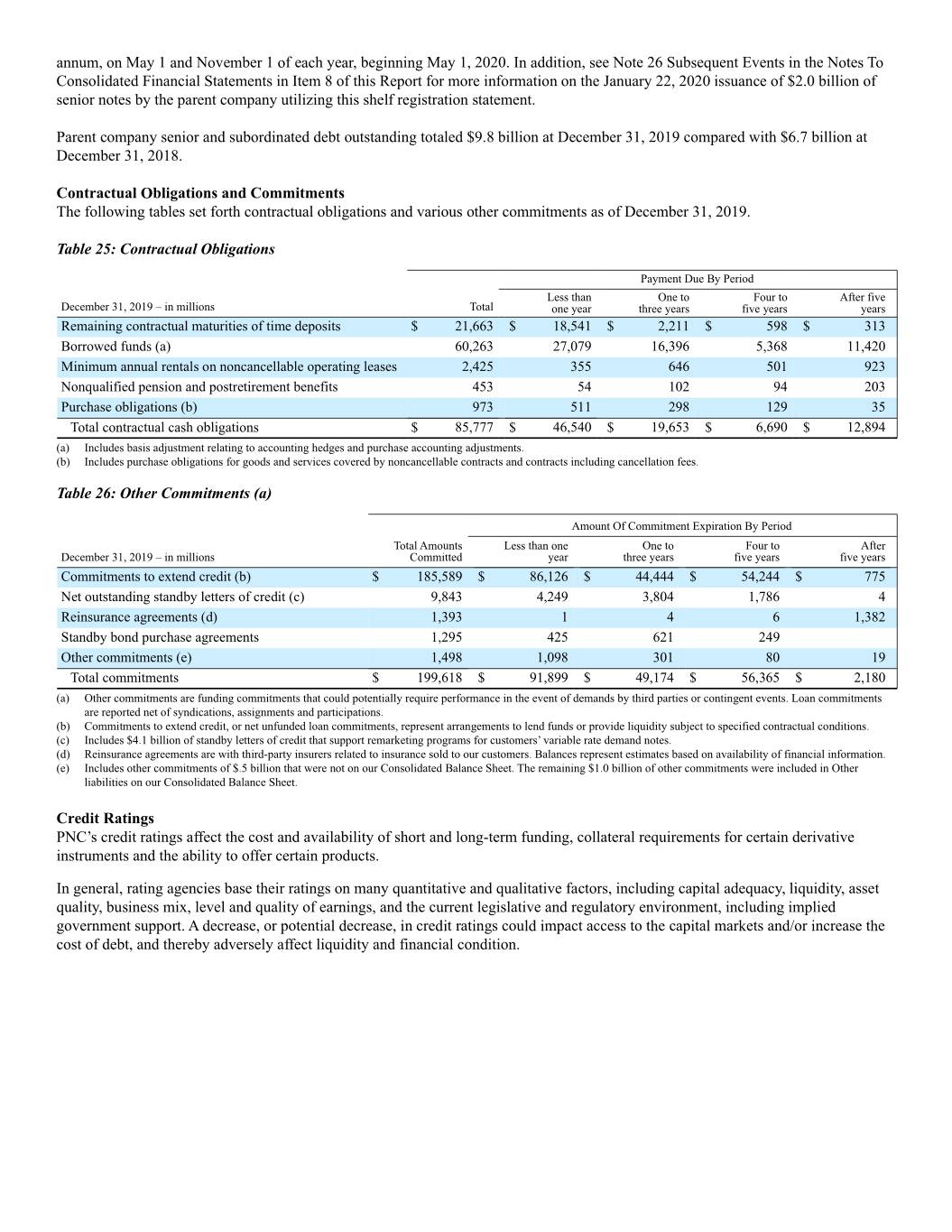
annum, on May 1 and November 1 of each year, beginning May 1, 2020. In addition, see Note 26 Subsequent Events in the Notes To Consolidated Financial Statements in Item 8 of this Report for more information on the January 22, 2020 issuance of $2.0 billion of senior notes by the parent company utilizing this shelf registration statement. Parent company senior and subordinated debt outstanding totaled $9.8 billion at December 31, 2019 compared with $6.7 billion at December 31, 2018. Contractual Obligations and Commitments The following tables set forth contractual obligations and various other commitments as of December 31, 2019. Table 25: Contractual Obligations Payment Due By Period Less than One to Four to After five December 31, 2019 – in millions Total one year three years five years years Remaining contractual maturities of time deposits $ 21,663 $ 18,541 $ 2,211 $ 598 $ 313 Borrowed funds (a) 60,263 27,079 16,396 5,368 11,420 Minimum annual rentals on noncancellable operating leases 2,425 355 646 501 923 Nonqualified pension and postretirement benefits 453 54 102 94 203 Purchase obligations (b) 973 511 298 129 35 Total contractual cash obligations $ 85,777 $ 46,540 $ 19,653 $ 6,690 $ 12,894 (a) Includes basis adjustment relating to accounting hedges and purchase accounting adjustments. (b) Includes purchase obligations for goods and services covered by noncancellable contracts and contracts including cancellation fees. Table 26: Other Commitments (a) Amount Of Commitment Expiration By Period Total Amounts Less than one One to Four to After December 31, 2019 – in millions Committed year three years five years five years Commitments to extend credit (b) $ 185,589 $ 86,126 $ 44,444 $ 54,244 $ 775 Net outstanding standby letters of credit (c) 9,843 4,249 3,804 1,786 4 Reinsurance agreements (d) 1,393 1 4 6 1,382 Standby bond purchase agreements 1,295 425 621 249 Other commitments (e) 1,498 1,098 301 80 19 Total commitments $ 199,618 $ 91,899 $ 49,174 $ 56,365 $ 2,180 (a) Other commitments are funding commitments that could potentially require performance in the event of demands by third parties or contingent events. Loan commitments are reported net of syndications, assignments and participations. (b) Commitments to extend credit, or net unfunded loan commitments, represent arrangements to lend funds or provide liquidity subject to specified contractual conditions. (c) Includes $4.1 billion of standby letters of credit that support remarketing programs for customers’ variable rate demand notes. (d) Reinsurance agreements are with third-party insurers related to insurance sold to our customers. Balances represent estimates based on availability of financial information. (e) Includes other commitments of $.5 billion that were not on our Consolidated Balance Sheet. The remaining $1.0 billion of other commitments were included in Other liabilities on our Consolidated Balance Sheet. Credit Ratings PNC’s credit ratings affect the cost and availability of short and long-term funding, collateral requirements for certain derivative instruments and the ability to offer certain products. In general, rating agencies base their ratings on many quantitative and qualitative factors, including capital adequacy, liquidity, asset quality, business mix, level and quality of earnings, and the current legislative and regulatory environment, including implied government support. A decrease, or potential decrease, in credit ratings could impact access to the capital markets and/or increase the cost of debt, and thereby adversely affect liquidity and financial condition.
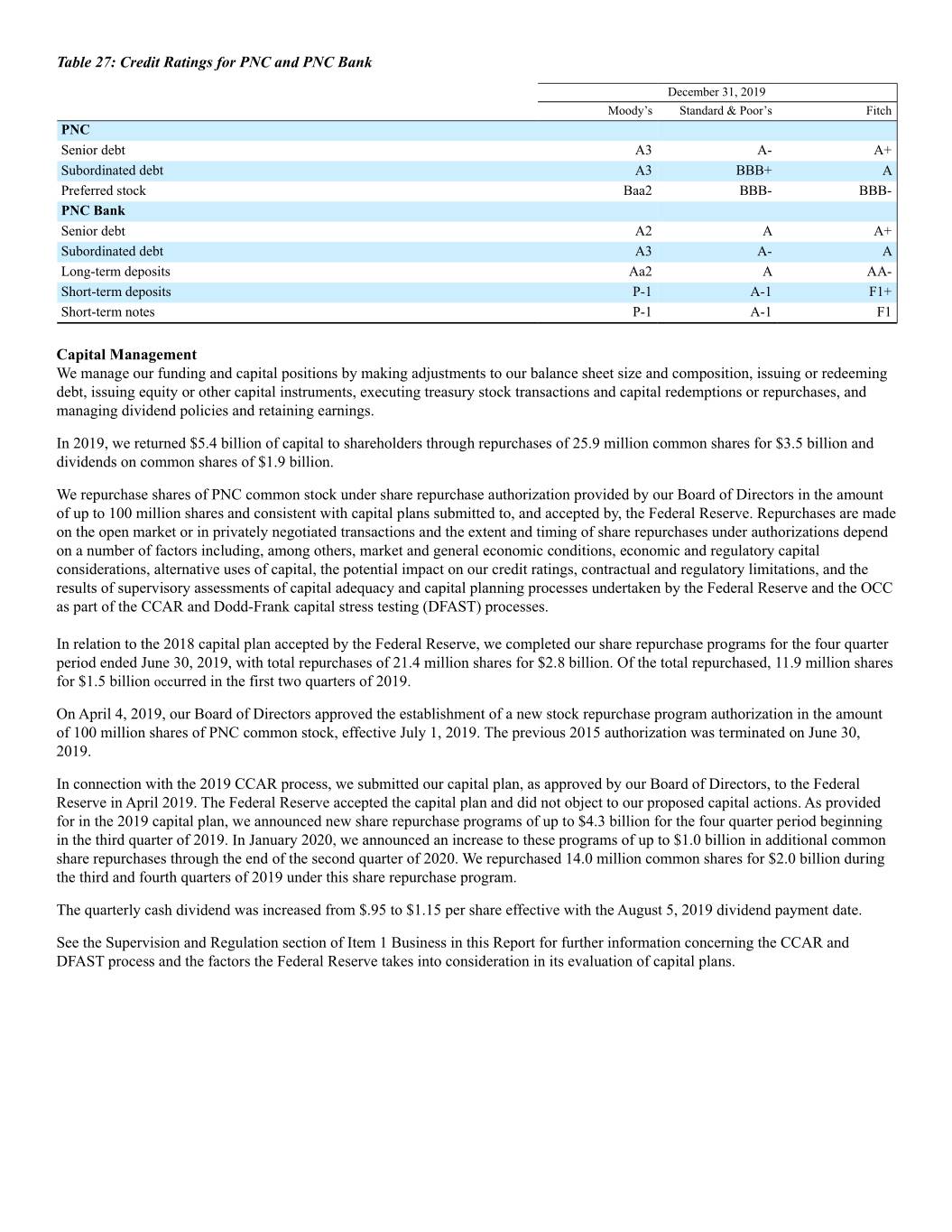
Table 27: Credit Ratings for PNC and PNC Bank December 31, 2019 Moody’s Standard & Poor’s Fitch PNC Senior debt A3 A- A+ Subordinated debt A3 BBB+ A Preferred stock Baa2 BBB- BBB- PNC Bank Senior debt A2 A A+ Subordinated debt A3 A- A Long-term deposits Aa2 A AA- Short-term deposits P-1 A-1 F1+ Short-term notes P-1 A-1 F1 Capital Management We manage our funding and capital positions by making adjustments to our balance sheet size and composition, issuing or redeeming debt, issuing equity or other capital instruments, executing treasury stock transactions and capital redemptions or repurchases, and managing dividend policies and retaining earnings. In 2019, we returned $5.4 billion of capital to shareholders through repurchases of 25.9 million common shares for $3.5 billion and dividends on common shares of $1.9 billion. We repurchase shares of PNC common stock under share repurchase authorization provided by our Board of Directors in the amount of up to 100 million shares and consistent with capital plans submitted to, and accepted by, the Federal Reserve. Repurchases are made on the open market or in privately negotiated transactions and the extent and timing of share repurchases under authorizations depend on a number of factors including, among others, market and general economic conditions, economic and regulatory capital considerations, alternative uses of capital, the potential impact on our credit ratings, contractual and regulatory limitations, and the results of supervisory assessments of capital adequacy and capital planning processes undertaken by the Federal Reserve and the OCC as part of the CCAR and Dodd-Frank capital stress testing (DFAST) processes. In relation to the 2018 capital plan accepted by the Federal Reserve, we completed our share repurchase programs for the four quarter period ended June 30, 2019, with total repurchases of 21.4 million shares for $2.8 billion. Of the total repurchased, 11.9 million shares for $1.5 billion occurred in the first two quarters of 2019. On April 4, 2019, our Board of Directors approved the establishment of a new stock repurchase program authorization in the amount of 100 million shares of PNC common stock, effective July 1, 2019. The previous 2015 authorization was terminated on June 30, 2019. In connection with the 2019 CCAR process, we submitted our capital plan, as approved by our Board of Directors, to the Federal Reserve in April 2019. The Federal Reserve accepted the capital plan and did not object to our proposed capital actions. As provided for in the 2019 capital plan, we announced new share repurchase programs of up to $4.3 billion for the four quarter period beginning in the third quarter of 2019. In January 2020, we announced an increase to these programs of up to $1.0 billion in additional common share repurchases through the end of the second quarter of 2020. We repurchased 14.0 million common shares for $2.0 billion during the third and fourth quarters of 2019 under this share repurchase program. The quarterly cash dividend was increased from $.95 to $1.15 per share effective with the August 5, 2019 dividend payment date. See the Supervision and Regulation section of Item 1 Business in this Report for further information concerning the CCAR and DFAST process and the factors the Federal Reserve takes into consideration in its evaluation of capital plans.
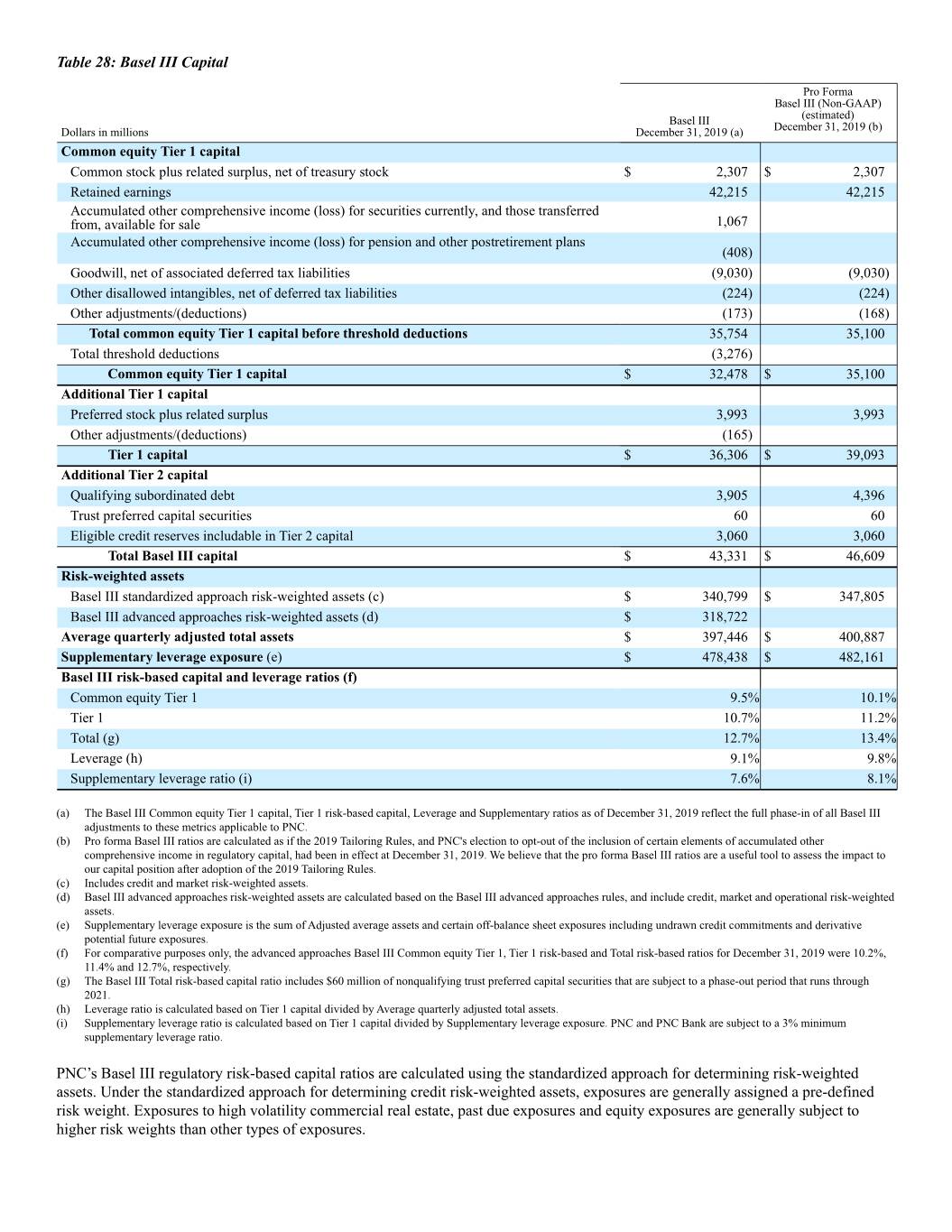
Table 28: Basel III Capital Pro Forma Basel III (Non-GAAP) Basel III (estimated) Dollars in millions December 31, 2019 (a) December 31, 2019 (b) Common equity Tier 1 capital Common stock plus related surplus, net of treasury stock $ 2,307 $ 2,307 Retained earnings 42,215 42,215 Accumulated other comprehensive income (loss) for securities currently, and those transferred from, available for sale 1,067 Accumulated other comprehensive income (loss) for pension and other postretirement plans (408) Goodwill, net of associated deferred tax liabilities (9,030) (9,030) Other disallowed intangibles, net of deferred tax liabilities (224) (224) Other adjustments/(deductions) (173) (168) Total common equity Tier 1 capital before threshold deductions 35,754 35,100 Total threshold deductions (3,276) Common equity Tier 1 capital $ 32,478 $ 35,100 Additional Tier 1 capital Preferred stock plus related surplus 3,993 3,993 Other adjustments/(deductions) (165) Tier 1 capital $ 36,306 $ 39,093 Additional Tier 2 capital Qualifying subordinated debt 3,905 4,396 Trust preferred capital securities 60 60 Eligible credit reserves includable in Tier 2 capital 3,060 3,060 Total Basel III capital $ 43,331 $ 46,609 Risk-weighted assets Basel III standardized approach risk-weighted assets (c) $ 340,799 $ 347,805 Basel III advanced approaches risk-weighted assets (d) $ 318,722 Average quarterly adjusted total assets $ 397,446 $ 400,887 Supplementary leverage exposure (e) $ 478,438 $ 482,161 Basel III risk-based capital and leverage ratios (f) Common equity Tier 1 9.5% 10.1% Tier 1 10.7% 11.2% Total (g) 12.7% 13.4% Leverage (h) 9.1% 9.8% Supplementary leverage ratio (i) 7.6% 8.1% (a) The Basel III Common equity Tier 1 capital, Tier 1 risk-based capital, Leverage and Supplementary ratios as of December 31, 2019 reflect the full phase-in of all Basel III adjustments to these metrics applicable to PNC. (b) Pro forma Basel III ratios are calculated as if the 2019 Tailoring Rules, and PNC's election to opt-out of the inclusion of certain elements of accumulated other comprehensive income in regulatory capital, had been in effect at December 31, 2019. We believe that the pro forma Basel III ratios are a useful tool to assess the impact to our capital position after adoption of the 2019 Tailoring Rules. (c) Includes credit and market risk-weighted assets. (d) Basel III advanced approaches risk-weighted assets are calculated based on the Basel III advanced approaches rules, and include credit, market and operational risk-weighted assets. (e) Supplementary leverage exposure is the sum of Adjusted average assets and certain off-balance sheet exposures including undrawn credit commitments and derivative potential future exposures. (f) For comparative purposes only, the advanced approaches Basel III Common equity Tier 1, Tier 1 risk-based and Total risk-based ratios for December 31, 2019 were 10.2%, 11.4% and 12.7%, respectively. (g) The Basel III Total risk-based capital ratio includes $60 million of nonqualifying trust preferred capital securities that are subject to a phase-out period that runs through 2021. (h) Leverage ratio is calculated based on Tier 1 capital divided by Average quarterly adjusted total assets. (i) Supplementary leverage ratio is calculated based on Tier 1 capital divided by Supplementary leverage exposure. PNC and PNC Bank are subject to a 3% minimum supplementary leverage ratio. PNC’s Basel III regulatory risk-based capital ratios are calculated using the standardized approach for determining risk-weighted assets. Under the standardized approach for determining credit risk-weighted assets, exposures are generally assigned a pre-defined risk weight. Exposures to high volatility commercial real estate, past due exposures and equity exposures are generally subject to higher risk weights than other types of exposures.
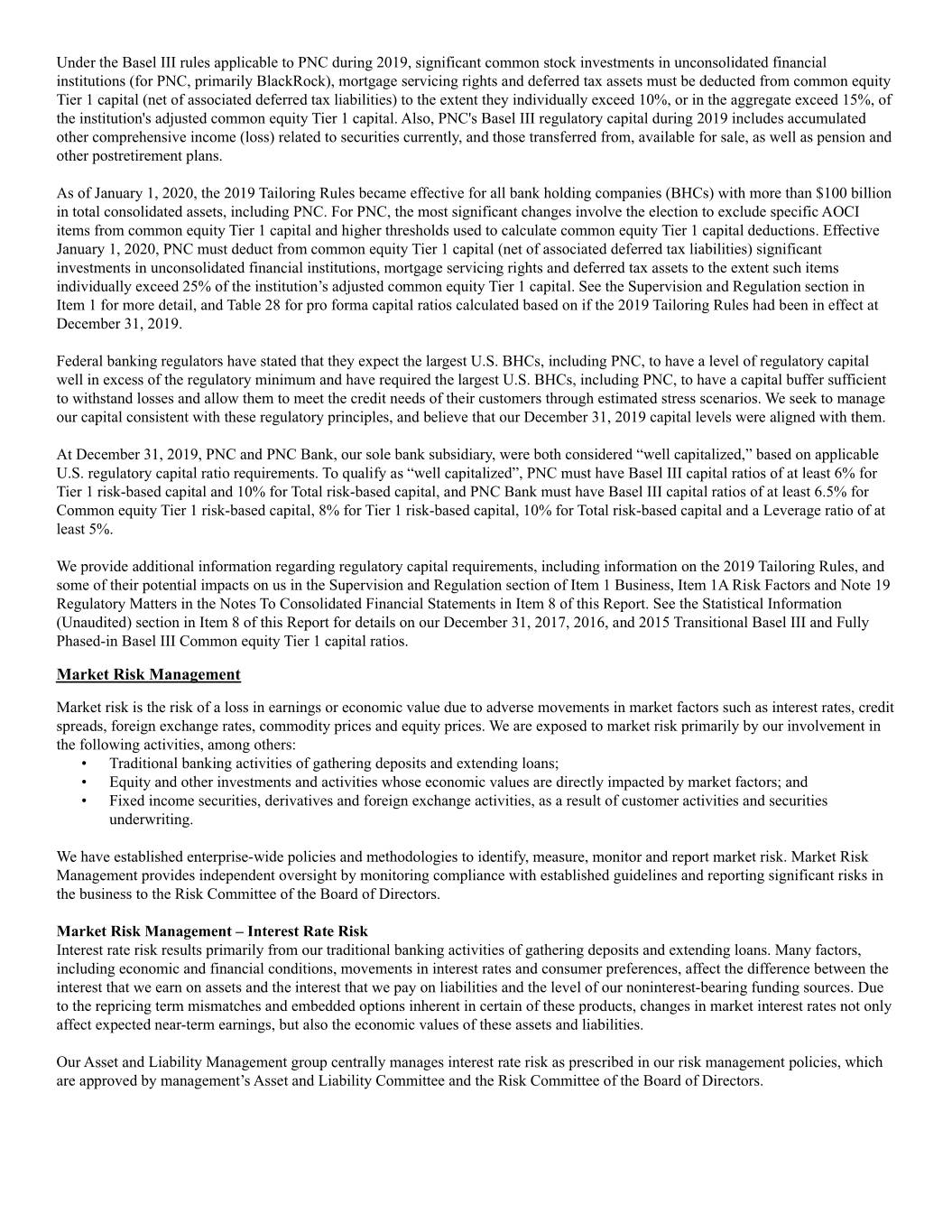
Under the Basel III rules applicable to PNC during 2019, significant common stock investments in unconsolidated financial institutions (for PNC, primarily BlackRock), mortgage servicing rights and deferred tax assets must be deducted from common equity Tier 1 capital (net of associated deferred tax liabilities) to the extent they individually exceed 10%, or in the aggregate exceed 15%, of the institution's adjusted common equity Tier 1 capital. Also, PNC's Basel III regulatory capital during 2019 includes accumulated other comprehensive income (loss) related to securities currently, and those transferred from, available for sale, as well as pension and other postretirement plans. As of January 1, 2020, the 2019 Tailoring Rules became effective for all bank holding companies (BHCs) with more than $100 billion in total consolidated assets, including PNC. For PNC, the most significant changes involve the election to exclude specific AOCI items from common equity Tier 1 capital and higher thresholds used to calculate common equity Tier 1 capital deductions. Effective January 1, 2020, PNC must deduct from common equity Tier 1 capital (net of associated deferred tax liabilities) significant investments in unconsolidated financial institutions, mortgage servicing rights and deferred tax assets to the extent such items individually exceed 25% of the institution’s adjusted common equity Tier 1 capital. See the Supervision and Regulation section in Item 1 for more detail, and Table 28 for pro forma capital ratios calculated based on if the 2019 Tailoring Rules had been in effect at December 31, 2019. Federal banking regulators have stated that they expect the largest U.S. BHCs, including PNC, to have a level of regulatory capital well in excess of the regulatory minimum and have required the largest U.S. BHCs, including PNC, to have a capital buffer sufficient to withstand losses and allow them to meet the credit needs of their customers through estimated stress scenarios. We seek to manage our capital consistent with these regulatory principles, and believe that our December 31, 2019 capital levels were aligned with them. At December 31, 2019, PNC and PNC Bank, our sole bank subsidiary, were both considered “well capitalized,” based on applicable U.S. regulatory capital ratio requirements. To qualify as “well capitalized”, PNC must have Basel III capital ratios of at least 6% for Tier 1 risk-based capital and 10% for Total risk-based capital, and PNC Bank must have Basel III capital ratios of at least 6.5% for Common equity Tier 1 risk-based capital, 8% for Tier 1 risk-based capital, 10% for Total risk-based capital and a Leverage ratio of at least 5%. We provide additional information regarding regulatory capital requirements, including information on the 2019 Tailoring Rules, and some of their potential impacts on us in the Supervision and Regulation section of Item 1 Business, Item 1A Risk Factors and Note 19 Regulatory Matters in the Notes To Consolidated Financial Statements in Item 8 of this Report. See the Statistical Information (Unaudited) section in Item 8 of this Report for details on our December 31, 2017, 2016, and 2015 Transitional Basel III and Fully Phased-in Basel III Common equity Tier 1 capital ratios. Market Risk Management Market risk is the risk of a loss in earnings or economic value due to adverse movements in market factors such as interest rates, credit spreads, foreign exchange rates, commodity prices and equity prices. We are exposed to market risk primarily by our involvement in the following activities, among others: • Traditional banking activities of gathering deposits and extending loans; • Equity and other investments and activities whose economic values are directly impacted by market factors; and • Fixed income securities, derivatives and foreign exchange activities, as a result of customer activities and securities underwriting. We have established enterprise-wide policies and methodologies to identify, measure, monitor and report market risk. Market Risk Management provides independent oversight by monitoring compliance with established guidelines and reporting significant risks in the business to the Risk Committee of the Board of Directors. Market Risk Management – Interest Rate Risk Interest rate risk results primarily from our traditional banking activities of gathering deposits and extending loans. Many factors, including economic and financial conditions, movements in interest rates and consumer preferences, affect the difference between the interest that we earn on assets and the interest that we pay on liabilities and the level of our noninterest-bearing funding sources. Due to the repricing term mismatches and embedded options inherent in certain of these products, changes in market interest rates not only affect expected near-term earnings, but also the economic values of these assets and liabilities. Our Asset and Liability Management group centrally manages interest rate risk as prescribed in our risk management policies, which are approved by management’s Asset and Liability Committee and the Risk Committee of the Board of Directors.
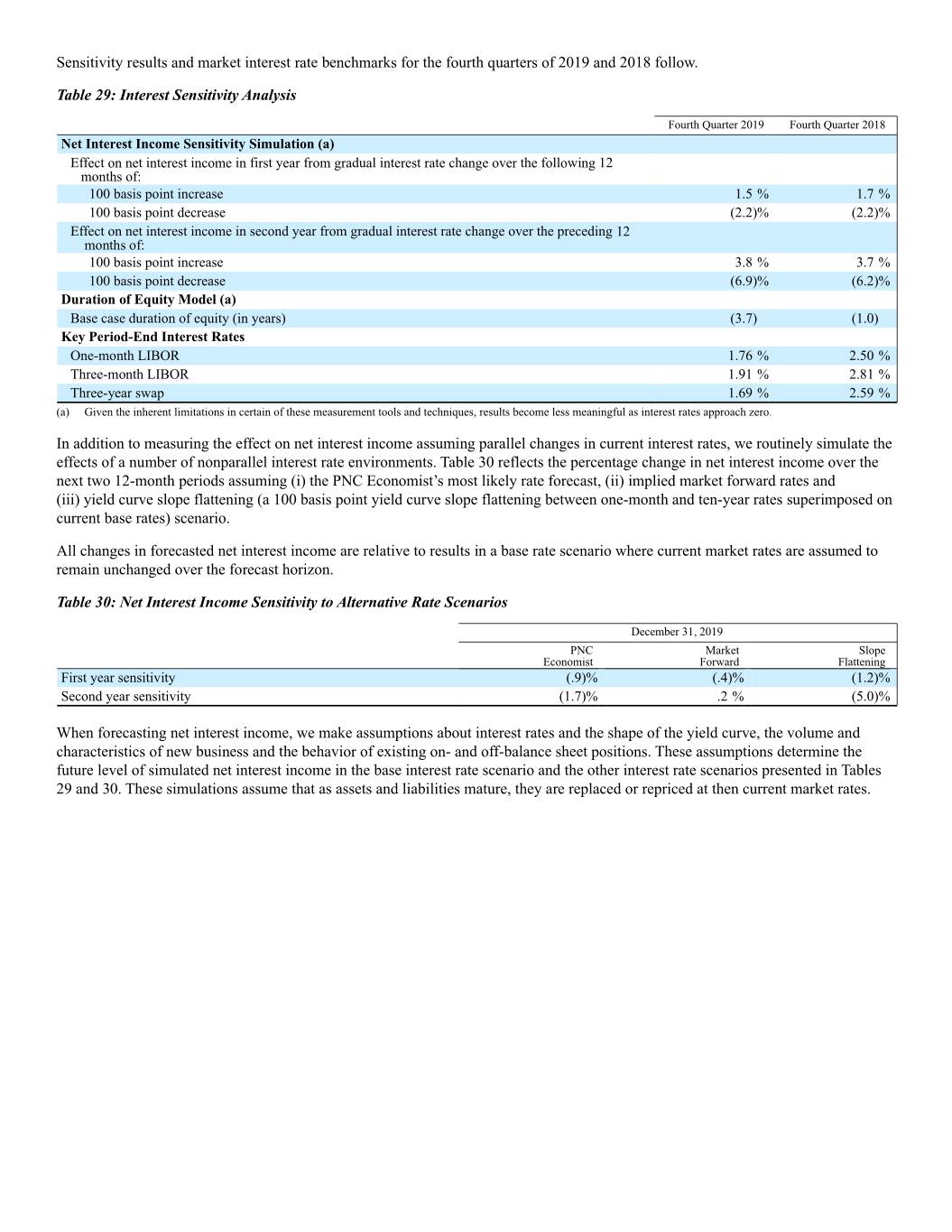
Sensitivity results and market interest rate benchmarks for the fourth quarters of 2019 and 2018 follow. Table 29: Interest Sensitivity Analysis Fourth Quarter 2019 Fourth Quarter 2018 Net Interest Income Sensitivity Simulation (a) Effect on net interest income in first year from gradual interest rate change over the following 12 months of: 100 basis point increase 1.5 % 1.7 % 100 basis point decrease (2.2)% (2.2)% Effect on net interest income in second year from gradual interest rate change over the preceding 12 months of: 100 basis point increase 3.8 % 3.7 % 100 basis point decrease (6.9)% (6.2)% Duration of Equity Model (a) Base case duration of equity (in years) (3.7) (1.0) Key Period-End Interest Rates One-month LIBOR 1.76 % 2.50 % Three-month LIBOR 1.91 % 2.81 % Three-year swap 1.69 % 2.59 % (a) Given the inherent limitations in certain of these measurement tools and techniques, results become less meaningful as interest rates approach zero. In addition to measuring the effect on net interest income assuming parallel changes in current interest rates, we routinely simulate the effects of a number of nonparallel interest rate environments. Table 30 reflects the percentage change in net interest income over the next two 12-month periods assuming (i) the PNC Economist’s most likely rate forecast, (ii) implied market forward rates and (iii) yield curve slope flattening (a 100 basis point yield curve slope flattening between one-month and ten-year rates superimposed on current base rates) scenario. All changes in forecasted net interest income are relative to results in a base rate scenario where current market rates are assumed to remain unchanged over the forecast horizon. Table 30: Net Interest Income Sensitivity to Alternative Rate Scenarios December 31, 2019 PNC Market Slope Economist Forward Flattening First year sensitivity (.9)% (.4)% (1.2)% Second year sensitivity (1.7)% .2 % (5.0)% When forecasting net interest income, we make assumptions about interest rates and the shape of the yield curve, the volume and characteristics of new business and the behavior of existing on- and off-balance sheet positions. These assumptions determine the future level of simulated net interest income in the base interest rate scenario and the other interest rate scenarios presented in Tables 29 and 30. These simulations assume that as assets and liabilities mature, they are replaced or repriced at then current market rates.
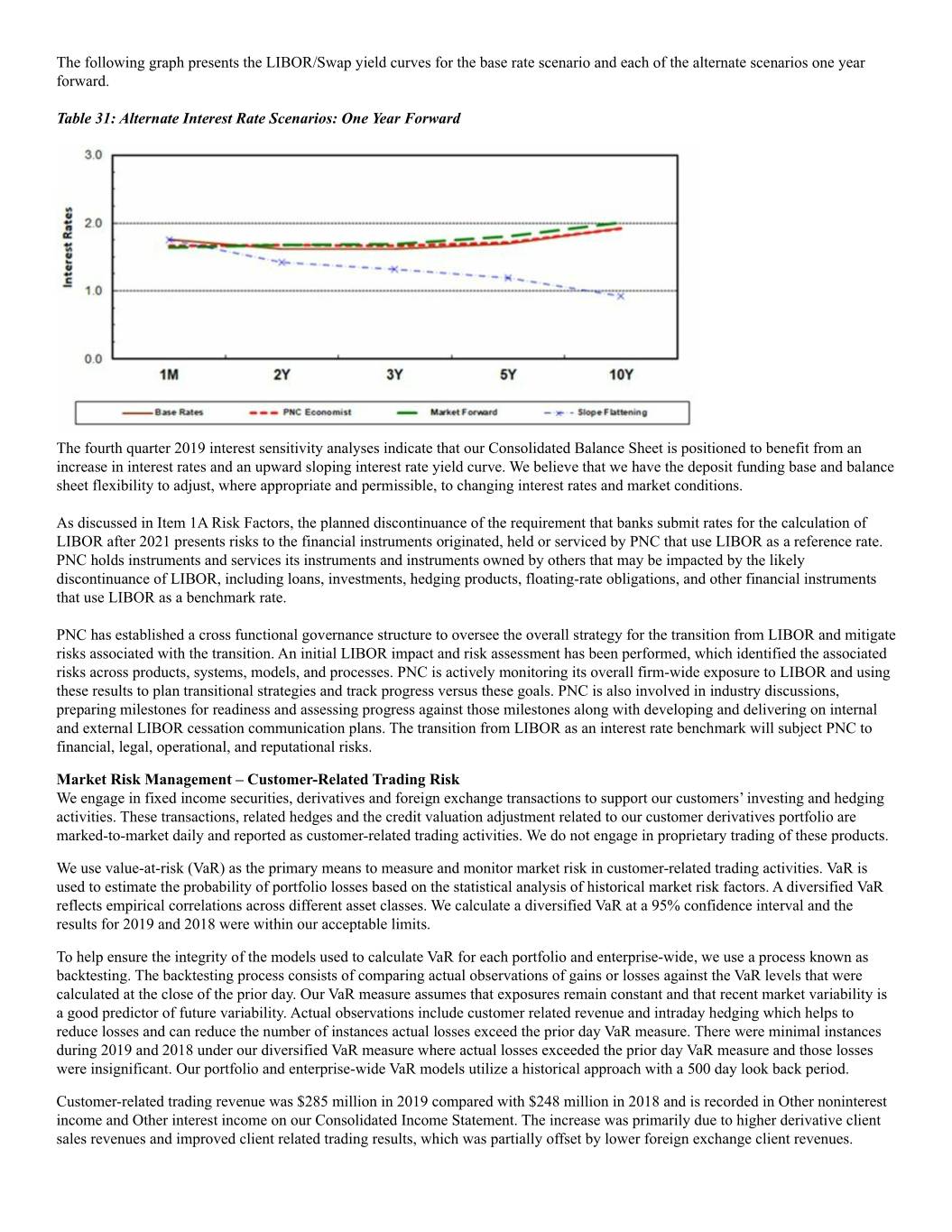
The following graph presents the LIBOR/Swap yield curves for the base rate scenario and each of the alternate scenarios one year forward. Table 31: Alternate Interest Rate Scenarios: One Year Forward The fourth quarter 2019 interest sensitivity analyses indicate that our Consolidated Balance Sheet is positioned to benefit from an increase in interest rates and an upward sloping interest rate yield curve. We believe that we have the deposit funding base and balance sheet flexibility to adjust, where appropriate and permissible, to changing interest rates and market conditions. As discussed in Item 1A Risk Factors, the planned discontinuance of the requirement that banks submit rates for the calculation of LIBOR after 2021 presents risks to the financial instruments originated, held or serviced by PNC that use LIBOR as a reference rate. PNC holds instruments and services its instruments and instruments owned by others that may be impacted by the likely discontinuance of LIBOR, including loans, investments, hedging products, floating-rate obligations, and other financial instruments that use LIBOR as a benchmark rate. PNC has established a cross functional governance structure to oversee the overall strategy for the transition from LIBOR and mitigate risks associated with the transition. An initial LIBOR impact and risk assessment has been performed, which identified the associated risks across products, systems, models, and processes. PNC is actively monitoring its overall firm-wide exposure to LIBOR and using these results to plan transitional strategies and track progress versus these goals. PNC is also involved in industry discussions, preparing milestones for readiness and assessing progress against those milestones along with developing and delivering on internal and external LIBOR cessation communication plans. The transition from LIBOR as an interest rate benchmark will subject PNC to financial, legal, operational, and reputational risks. Market Risk Management – Customer-Related Trading Risk We engage in fixed income securities, derivatives and foreign exchange transactions to support our customers’ investing and hedging activities. These transactions, related hedges and the credit valuation adjustment related to our customer derivatives portfolio are marked-to-market daily and reported as customer-related trading activities. We do not engage in proprietary trading of these products. We use value-at-risk (VaR) as the primary means to measure and monitor market risk in customer-related trading activities. VaR is used to estimate the probability of portfolio losses based on the statistical analysis of historical market risk factors. A diversified VaR reflects empirical correlations across different asset classes. We calculate a diversified VaR at a 95% confidence interval and the results for 2019 and 2018 were within our acceptable limits. To help ensure the integrity of the models used to calculate VaR for each portfolio and enterprise-wide, we use a process known as backtesting. The backtesting process consists of comparing actual observations of gains or losses against the VaR levels that were calculated at the close of the prior day. Our VaR measure assumes that exposures remain constant and that recent market variability is a good predictor of future variability. Actual observations include customer related revenue and intraday hedging which helps to reduce losses and can reduce the number of instances actual losses exceed the prior day VaR measure. There were minimal instances during 2019 and 2018 under our diversified VaR measure where actual losses exceeded the prior day VaR measure and those losses were insignificant. Our portfolio and enterprise-wide VaR models utilize a historical approach with a 500 day look back period. Customer-related trading revenue was $285 million in 2019 compared with $248 million in 2018 and is recorded in Other noninterest income and Other interest income on our Consolidated Income Statement. The increase was primarily due to higher derivative client sales revenues and improved client related trading results, which was partially offset by lower foreign exchange client revenues.
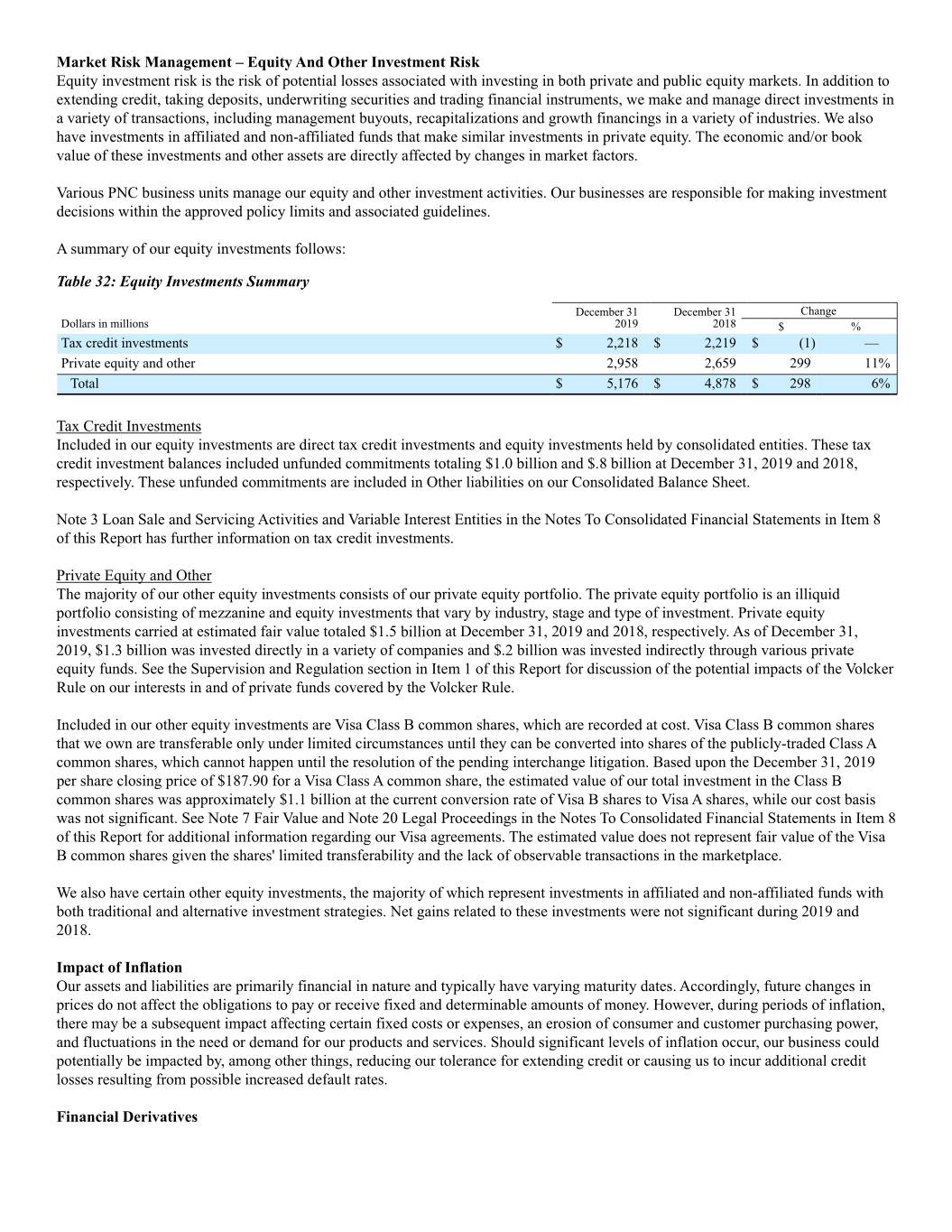
Market Risk Management – Equity And Other Investment Risk Equity investment risk is the risk of potential losses associated with investing in both private and public equity markets. In addition to extending credit, taking deposits, underwriting securities and trading financial instruments, we make and manage direct investments in a variety of transactions, including management buyouts, recapitalizations and growth financings in a variety of industries. We also have investments in affiliated and non-affiliated funds that make similar investments in private equity. The economic and/or book value of these investments and other assets are directly affected by changes in market factors. Various PNC business units manage our equity and other investment activities. Our businesses are responsible for making investment decisions within the approved policy limits and associated guidelines. A summary of our equity investments follows: Table 32: Equity Investments Summary December 31 December 31 Change Dollars in millions 2019 2018 $ % Tax credit investments $ 2,218 $ 2,219 $ (1) — Private equity and other 2,958 2,659 299 11% Total $ 5,176 $ 4,878 $ 298 6% Tax Credit Investments Included in our equity investments are direct tax credit investments and equity investments held by consolidated entities. These tax credit investment balances included unfunded commitments totaling $1.0 billion and $.8 billion at December 31, 2019 and 2018, respectively. These unfunded commitments are included in Other liabilities on our Consolidated Balance Sheet. Note 3 Loan Sale and Servicing Activities and Variable Interest Entities in the Notes To Consolidated Financial Statements in Item 8 of this Report has further information on tax credit investments. Private Equity and Other The majority of our other equity investments consists of our private equity portfolio. The private equity portfolio is an illiquid portfolio consisting of mezzanine and equity investments that vary by industry, stage and type of investment. Private equity investments carried at estimated fair value totaled $1.5 billion at December 31, 2019 and 2018, respectively. As of December 31, 2019, $1.3 billion was invested directly in a variety of companies and $.2 billion was invested indirectly through various private equity funds. See the Supervision and Regulation section in Item 1 of this Report for discussion of the potential impacts of the Volcker Rule on our interests in and of private funds covered by the Volcker Rule. Included in our other equity investments are Visa Class B common shares, which are recorded at cost. Visa Class B common shares that we own are transferable only under limited circumstances until they can be converted into shares of the publicly-traded Class A common shares, which cannot happen until the resolution of the pending interchange litigation. Based upon the December 31, 2019 per share closing price of $187.90 for a Visa Class A common share, the estimated value of our total investment in the Class B common shares was approximately $1.1 billion at the current conversion rate of Visa B shares to Visa A shares, while our cost basis was not significant. See Note 7 Fair Value and Note 20 Legal Proceedings in the Notes To Consolidated Financial Statements in Item 8 of this Report for additional information regarding our Visa agreements. The estimated value does not represent fair value of the Visa B common shares given the shares' limited transferability and the lack of observable transactions in the marketplace. We also have certain other equity investments, the majority of which represent investments in affiliated and non-affiliated funds with both traditional and alternative investment strategies. Net gains related to these investments were not significant during 2019 and 2018. Impact of Inflation Our assets and liabilities are primarily financial in nature and typically have varying maturity dates. Accordingly, future changes in prices do not affect the obligations to pay or receive fixed and determinable amounts of money. However, during periods of inflation, there may be a subsequent impact affecting certain fixed costs or expenses, an erosion of consumer and customer purchasing power, and fluctuations in the need or demand for our products and services. Should significant levels of inflation occur, our business could potentially be impacted by, among other things, reducing our tolerance for extending credit or causing us to incur additional credit losses resulting from possible increased default rates. Financial Derivatives
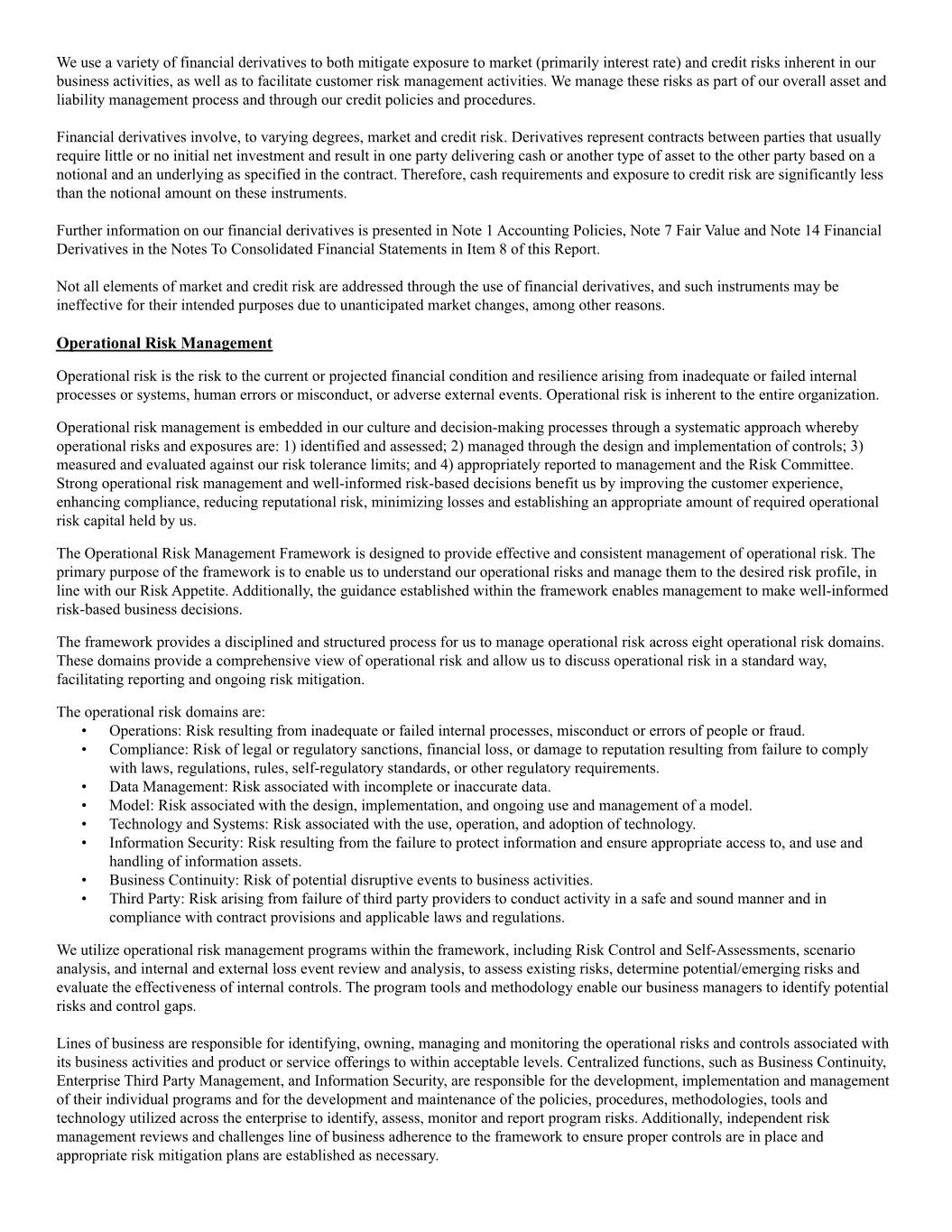
We use a variety of financial derivatives to both mitigate exposure to market (primarily interest rate) and credit risks inherent in our business activities, as well as to facilitate customer risk management activities. We manage these risks as part of our overall asset and liability management process and through our credit policies and procedures. Financial derivatives involve, to varying degrees, market and credit risk. Derivatives represent contracts between parties that usually require little or no initial net investment and result in one party delivering cash or another type of asset to the other party based on a notional and an underlying as specified in the contract. Therefore, cash requirements and exposure to credit risk are significantly less than the notional amount on these instruments. Further information on our financial derivatives is presented in Note 1 Accounting Policies, Note 7 Fair Value and Note 14 Financial Derivatives in the Notes To Consolidated Financial Statements in Item 8 of this Report. Not all elements of market and credit risk are addressed through the use of financial derivatives, and such instruments may be ineffective for their intended purposes due to unanticipated market changes, among other reasons. Operational Risk Management Operational risk is the risk to the current or projected financial condition and resilience arising from inadequate or failed internal processes or systems, human errors or misconduct, or adverse external events. Operational risk is inherent to the entire organization. Operational risk management is embedded in our culture and decision-making processes through a systematic approach whereby operational risks and exposures are: 1) identified and assessed; 2) managed through the design and implementation of controls; 3) measured and evaluated against our risk tolerance limits; and 4) appropriately reported to management and the Risk Committee. Strong operational risk management and well-informed risk-based decisions benefit us by improving the customer experience, enhancing compliance, reducing reputational risk, minimizing losses and establishing an appropriate amount of required operational risk capital held by us. The Operational Risk Management Framework is designed to provide effective and consistent management of operational risk. The primary purpose of the framework is to enable us to understand our operational risks and manage them to the desired risk profile, in line with our Risk Appetite. Additionally, the guidance established within the framework enables management to make well-informed risk-based business decisions. The framework provides a disciplined and structured process for us to manage operational risk across eight operational risk domains. These domains provide a comprehensive view of operational risk and allow us to discuss operational risk in a standard way, facilitating reporting and ongoing risk mitigation. The operational risk domains are: • Operations: Risk resulting from inadequate or failed internal processes, misconduct or errors of people or fraud. • Compliance: Risk of legal or regulatory sanctions, financial loss, or damage to reputation resulting from failure to comply with laws, regulations, rules, self-regulatory standards, or other regulatory requirements. • Data Management: Risk associated with incomplete or inaccurate data. • Model: Risk associated with the design, implementation, and ongoing use and management of a model. • Technology and Systems: Risk associated with the use, operation, and adoption of technology. • Information Security: Risk resulting from the failure to protect information and ensure appropriate access to, and use and handling of information assets. • Business Continuity: Risk of potential disruptive events to business activities. • Third Party: Risk arising from failure of third party providers to conduct activity in a safe and sound manner and in compliance with contract provisions and applicable laws and regulations. We utilize operational risk management programs within the framework, including Risk Control and Self-Assessments, scenario analysis, and internal and external loss event review and analysis, to assess existing risks, determine potential/emerging risks and evaluate the effectiveness of internal controls. The program tools and methodology enable our business managers to identify potential risks and control gaps. Lines of business are responsible for identifying, owning, managing and monitoring the operational risks and controls associated with its business activities and product or service offerings to within acceptable levels. Centralized functions, such as Business Continuity, Enterprise Third Party Management, and Information Security, are responsible for the development, implementation and management of their individual programs and for the development and maintenance of the policies, procedures, methodologies, tools and technology utilized across the enterprise to identify, assess, monitor and report program risks. Additionally, independent risk management reviews and challenges line of business adherence to the framework to ensure proper controls are in place and appropriate risk mitigation plans are established as necessary.

Conduct, Reputational and Strategic Risk PNC’s risk culture seeks to reinforce the appropriate protocols for responsible and ethical behavior through sound processes and controls. In order to promote a robust risk culture, the Board and executive management establish code of conduct and professional standards to which all employees must adhere. A strong risk culture discourages misconduct and supports Conduct Risk management at PNC. Conduct Risk is defined as the risk that employees fail to comply with the ethical standards expected of them. Strong Conduct Risk management is important in supporting PNC’s reputation and PNC maintains a corporate culture that emphasizes complying with laws, regulations, and managing reputational risks. Reputational Risk is the risk to the franchise and/or shareholder value based on a negative perception of PNC by its stakeholders and/or the changing expectations of its stakeholders. While managing PNC’s reputation preserves PNC’s brand value, Strategic Risk is another component of the ERM Framework that is also critical to optimizing shareholder returns. Strategic Risk is the risk to earnings that may arise from adverse business decisions, improper implementation of business decisions and/or inadequate response to changes in the business environment. Strategic Risk is considered and assessed by our businesses in the annual strategic planning processes and monitored on an on-going basis as those plans are carried out. Compliance Risk Enterprise Compliance is responsible for oversight of compliance risk for the organization. Compliance issues are identified and tracked through enterprise-wide monitoring and testing activities. Compliance risk issues are escalated through a comprehensive risk reporting process at both a business and enterprise level and incorporated, as appropriate, into the development and assessment of our operational risk profile. A management committee, co-chaired by the Chief Compliance Officer and the Chief Bank Secrecy Act (BSA)/Anti-Money Laundering (AML) Officer, is responsible for oversight of compliance and fiduciary risk management programs across PNC. Enterprise Compliance, through the Regulatory Change Program, helps PNC understand and proactively address emerging regulatory topics and risks as well as respond to changes in applicable laws and regulations. To understand emerging issues impacting the industry, Enterprise Compliance communicates regularly with various regulators having supervisory or regulatory responsibilities with respect to us, our subsidiaries, or businesses and participates in forums focused on regulatory and compliance matters in the financial services industry. Information Security Risk The Information Security component of our Operational Risk Management Framework is responsible for protecting information assets to achieve business objectives, which includes cyber security. PNC’s cyber security program is designed to identify risks to sensitive information, protect that information, detect threats and events, and maintain an appropriate response and recovery capability to help ensure resilience against information security incidents. The program includes, among other things, annual security and privacy training for all PNC employees and quarterly phishing exercises to raise employee awareness. Our security program is also regularly examined by federal regulators for compliance with financial regulations and standards. The program also establishes expectations for information asset management, system development security, identity and access management, incident management, threat and vulnerability management, security operations management, and third and fourth party security. CRITICAL ACCOUNTING ESTIMATES AND JUDGMENTS Our consolidated financial statements are prepared by applying certain accounting policies. Note 1 Accounting Policies in the Notes To Consolidated Financial Statements in Item 8 of this Report describes the most significant accounting policies that we use. Certain of these policies require us to make estimates or economic assumptions that may vary under different assumptions or conditions and such variations may significantly affect our reported results and financial position for the period or in future periods. Fair Value Measurements We must use estimates, assumptions and judgments when assets and liabilities are required to be recorded at, or adjusted to reflect, fair value. Assets and liabilities carried at fair value inherently result in a higher degree of financial statement volatility. Fair values and the information used to record valuation adjustments for certain assets and liabilities are based on either quoted market prices or are provided by independent third-party sources, including appraisers and valuation specialists, when available. When such third-party information is not available, we estimate fair value primarily by using cash flow and other financial modeling techniques. Changes in underlying factors, assumptions, or estimates in any of these areas could materially impact our future financial condition and results of operations. We apply ASC 820 – Fair Value Measurements. This guidance defines fair value as the price that would be received to sell a financial asset or paid to transfer a financial liability in an orderly transaction between market participants at the measurement date. This guidance requires a three level hierarchy for disclosure of assets and liabilities recorded at fair value. The classification of assets and liabilities within the hierarchy is based on whether the inputs to the valuation methodology used in the measurement are observable or unobservable. Level 3 assets and liabilities are those where the fair value is estimated using significant unobservable inputs. For additional information on fair value measurements, see Note 7 Fair Value in the Notes To Consolidated Financial Statements in Item 8 of this Report.
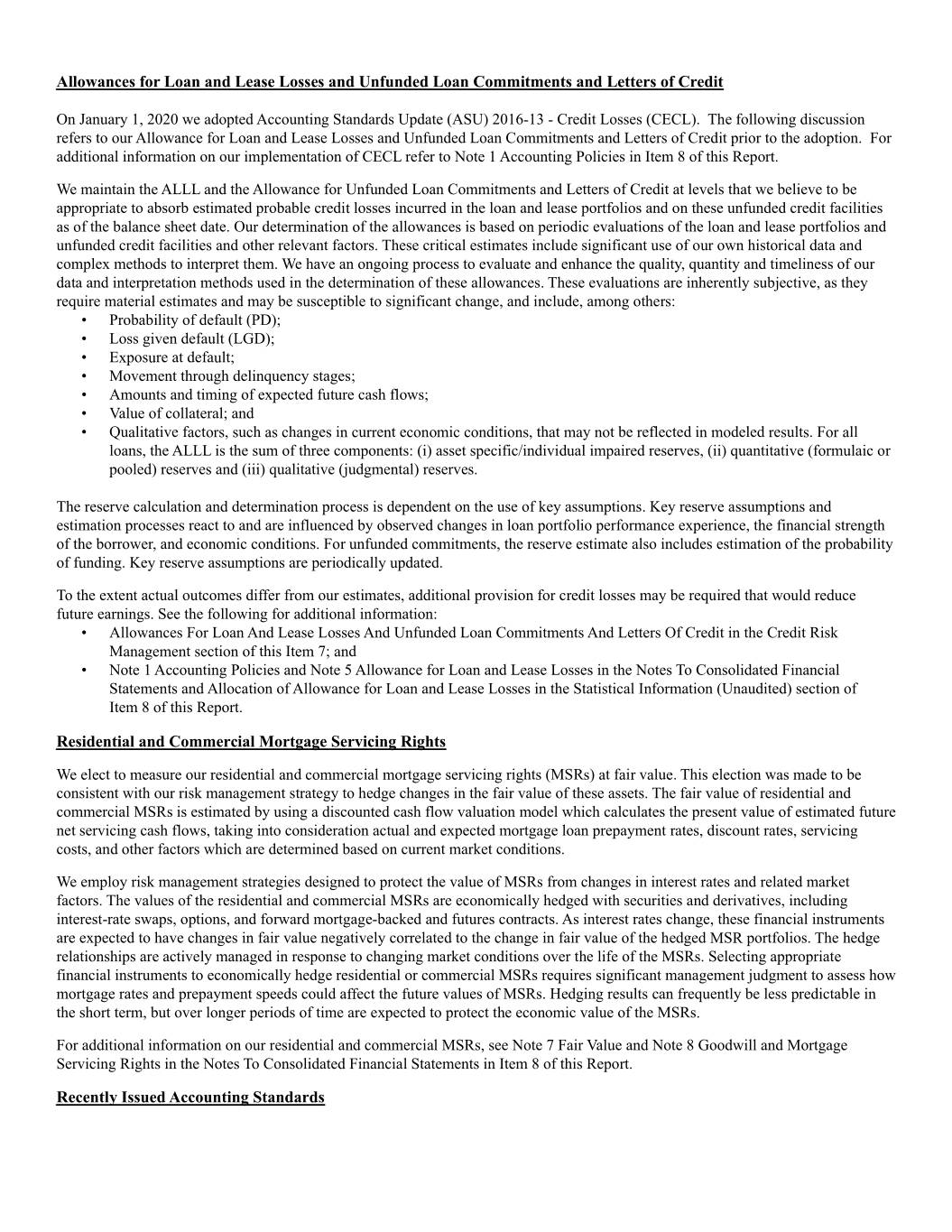
Allowances for Loan and Lease Losses and Unfunded Loan Commitments and Letters of Credit On January 1, 2020 we adopted Accounting Standards Update (ASU) 2016-13 - Credit Losses (CECL). The following discussion refers to our Allowance for Loan and Lease Losses and Unfunded Loan Commitments and Letters of Credit prior to the adoption. For additional information on our implementation of CECL refer to Note 1 Accounting Policies in Item 8 of this Report. We maintain the ALLL and the Allowance for Unfunded Loan Commitments and Letters of Credit at levels that we believe to be appropriate to absorb estimated probable credit losses incurred in the loan and lease portfolios and on these unfunded credit facilities as of the balance sheet date. Our determination of the allowances is based on periodic evaluations of the loan and lease portfolios and unfunded credit facilities and other relevant factors. These critical estimates include significant use of our own historical data and complex methods to interpret them. We have an ongoing process to evaluate and enhance the quality, quantity and timeliness of our data and interpretation methods used in the determination of these allowances. These evaluations are inherently subjective, as they require material estimates and may be susceptible to significant change, and include, among others: • Probability of default (PD); • Loss given default (LGD); • Exposure at default; • Movement through delinquency stages; • Amounts and timing of expected future cash flows; • Value of collateral; and • Qualitative factors, such as changes in current economic conditions, that may not be reflected in modeled results. For all loans, the ALLL is the sum of three components: (i) asset specific/individual impaired reserves, (ii) quantitative (formulaic or pooled) reserves and (iii) qualitative (judgmental) reserves. The reserve calculation and determination process is dependent on the use of key assumptions. Key reserve assumptions and estimation processes react to and are influenced by observed changes in loan portfolio performance experience, the financial strength of the borrower, and economic conditions. For unfunded commitments, the reserve estimate also includes estimation of the probability of funding. Key reserve assumptions are periodically updated. To the extent actual outcomes differ from our estimates, additional provision for credit losses may be required that would reduce future earnings. See the following for additional information: • Allowances For Loan And Lease Losses And Unfunded Loan Commitments And Letters Of Credit in the Credit Risk Management section of this Item 7; and • Note 1 Accounting Policies and Note 5 Allowance for Loan and Lease Losses in the Notes To Consolidated Financial Statements and Allocation of Allowance for Loan and Lease Losses in the Statistical Information (Unaudited) section of Item 8 of this Report. Residential and Commercial Mortgage Servicing Rights We elect to measure our residential and commercial mortgage servicing rights (MSRs) at fair value. This election was made to be consistent with our risk management strategy to hedge changes in the fair value of these assets. The fair value of residential and commercial MSRs is estimated by using a discounted cash flow valuation model which calculates the present value of estimated future net servicing cash flows, taking into consideration actual and expected mortgage loan prepayment rates, discount rates, servicing costs, and other factors which are determined based on current market conditions. We employ risk management strategies designed to protect the value of MSRs from changes in interest rates and related market factors. The values of the residential and commercial MSRs are economically hedged with securities and derivatives, including interest-rate swaps, options, and forward mortgage-backed and futures contracts. As interest rates change, these financial instruments are expected to have changes in fair value negatively correlated to the change in fair value of the hedged MSR portfolios. The hedge relationships are actively managed in response to changing market conditions over the life of the MSRs. Selecting appropriate financial instruments to economically hedge residential or commercial MSRs requires significant management judgment to assess how mortgage rates and prepayment speeds could affect the future values of MSRs. Hedging results can frequently be less predictable in the short term, but over longer periods of time are expected to protect the economic value of the MSRs. For additional information on our residential and commercial MSRs, see Note 7 Fair Value and Note 8 Goodwill and Mortgage Servicing Rights in the Notes To Consolidated Financial Statements in Item 8 of this Report. Recently Issued Accounting Standards
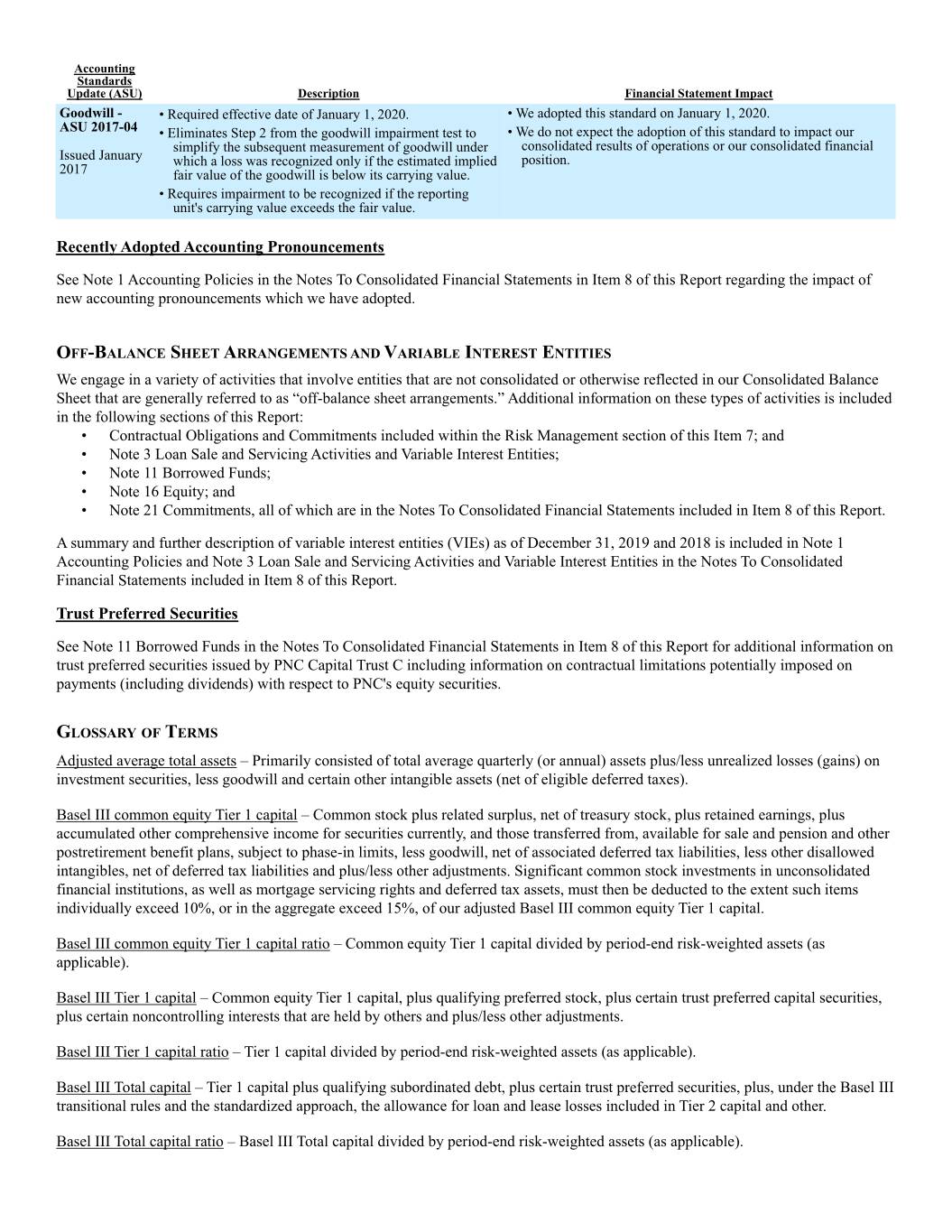
Accounting Standards Update (ASU) Description Financial Statement Impact Goodwill - • Required effective date of January 1, 2020. • We adopted this standard on January 1, 2020. ASU 2017-04 • Eliminates Step 2 from the goodwill impairment test to • We do not expect the adoption of this standard to impact our simplify the subsequent measurement of goodwill under consolidated results of operations or our consolidated financial Issued January which a loss was recognized only if the estimated implied position. 2017 fair value of the goodwill is below its carrying value. • Requires impairment to be recognized if the reporting unit's carrying value exceeds the fair value. Recently Adopted Accounting Pronouncements See Note 1 Accounting Policies in the Notes To Consolidated Financial Statements in Item 8 of this Report regarding the impact of new accounting pronouncements which we have adopted. OFF-BALANCE SHEET ARRANGEMENTS AND VARIABLE INTEREST ENTITIES We engage in a variety of activities that involve entities that are not consolidated or otherwise reflected in our Consolidated Balance Sheet that are generally referred to as “off-balance sheet arrangements.” Additional information on these types of activities is included in the following sections of this Report: • Contractual Obligations and Commitments included within the Risk Management section of this Item 7; and • Note 3 Loan Sale and Servicing Activities and Variable Interest Entities; • Note 11 Borrowed Funds; • Note 16 Equity; and • Note 21 Commitments, all of which are in the Notes To Consolidated Financial Statements included in Item 8 of this Report. A summary and further description of variable interest entities (VIEs) as of December 31, 2019 and 2018 is included in Note 1 Accounting Policies and Note 3 Loan Sale and Servicing Activities and Variable Interest Entities in the Notes To Consolidated Financial Statements included in Item 8 of this Report. Trust Preferred Securities See Note 11 Borrowed Funds in the Notes To Consolidated Financial Statements in Item 8 of this Report for additional information on trust preferred securities issued by PNC Capital Trust C including information on contractual limitations potentially imposed on payments (including dividends) with respect to PNC's equity securities. GLOSSARY OF TERMS Adjusted average total assets – Primarily consisted of total average quarterly (or annual) assets plus/less unrealized losses (gains) on investment securities, less goodwill and certain other intangible assets (net of eligible deferred taxes). Basel III common equity Tier 1 capital – Common stock plus related surplus, net of treasury stock, plus retained earnings, plus accumulated other comprehensive income for securities currently, and those transferred from, available for sale and pension and other postretirement benefit plans, subject to phase-in limits, less goodwill, net of associated deferred tax liabilities, less other disallowed intangibles, net of deferred tax liabilities and plus/less other adjustments. Significant common stock investments in unconsolidated financial institutions, as well as mortgage servicing rights and deferred tax assets, must then be deducted to the extent such items individually exceed 10%, or in the aggregate exceed 15%, of our adjusted Basel III common equity Tier 1 capital. Basel III common equity Tier 1 capital ratio – Common equity Tier 1 capital divided by period-end risk-weighted assets (as applicable). Basel III Tier 1 capital – Common equity Tier 1 capital, plus qualifying preferred stock, plus certain trust preferred capital securities, plus certain noncontrolling interests that are held by others and plus/less other adjustments. Basel III Tier 1 capital ratio – Tier 1 capital divided by period-end risk-weighted assets (as applicable). Basel III Total capital – Tier 1 capital plus qualifying subordinated debt, plus certain trust preferred securities, plus, under the Basel III transitional rules and the standardized approach, the allowance for loan and lease losses included in Tier 2 capital and other. Basel III Total capital ratio – Basel III Total capital divided by period-end risk-weighted assets (as applicable).
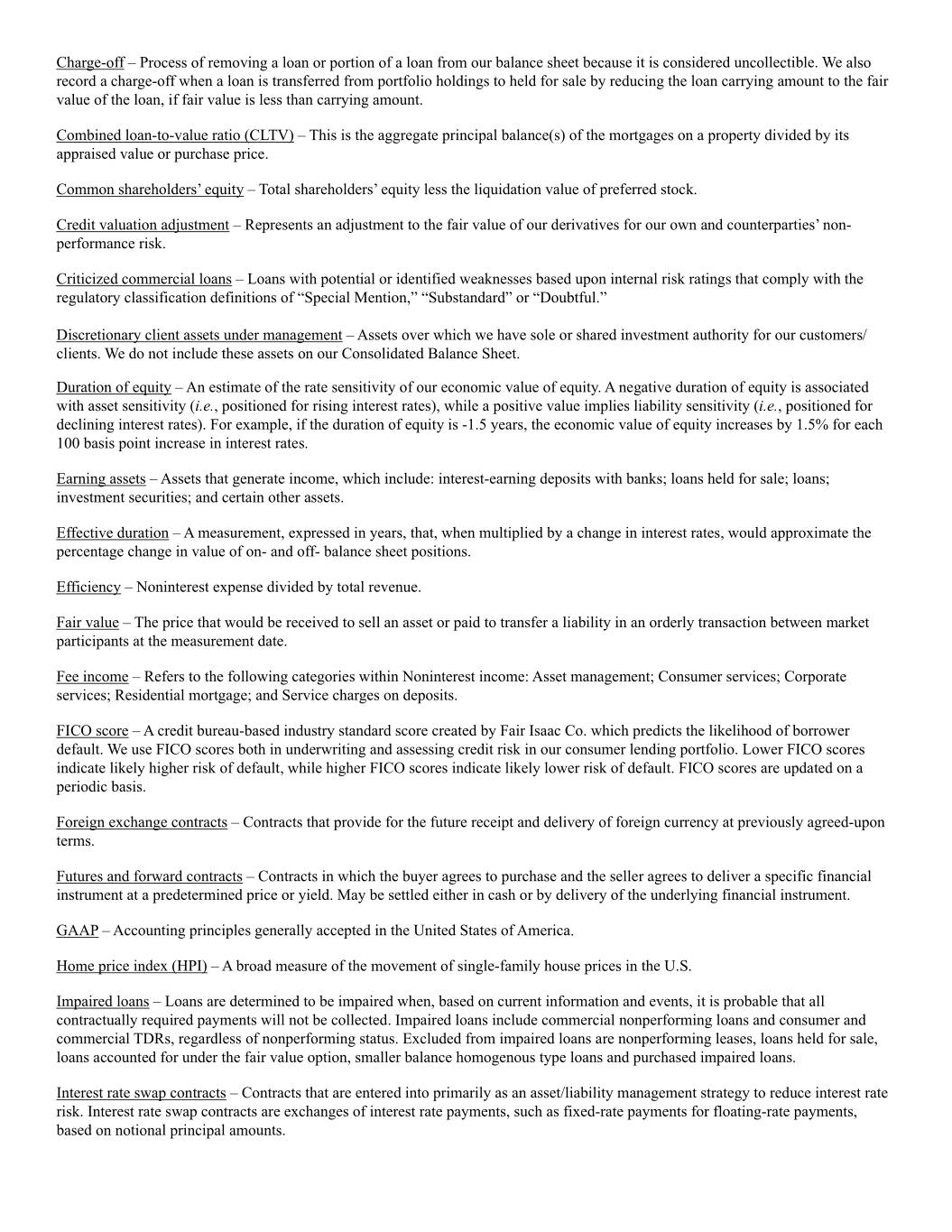
Charge-off – Process of removing a loan or portion of a loan from our balance sheet because it is considered uncollectible. We also record a charge-off when a loan is transferred from portfolio holdings to held for sale by reducing the loan carrying amount to the fair value of the loan, if fair value is less than carrying amount. Combined loan-to-value ratio (CLTV) – This is the aggregate principal balance(s) of the mortgages on a property divided by its appraised value or purchase price. Common shareholders’ equity – Total shareholders’ equity less the liquidation value of preferred stock. Credit valuation adjustment – Represents an adjustment to the fair value of our derivatives for our own and counterparties’ non- performance risk. Criticized commercial loans – Loans with potential or identified weaknesses based upon internal risk ratings that comply with the regulatory classification definitions of “Special Mention,” “Substandard” or “Doubtful.” Discretionary client assets under management – Assets over which we have sole or shared investment authority for our customers/ clients. We do not include these assets on our Consolidated Balance Sheet. Duration of equity – An estimate of the rate sensitivity of our economic value of equity. A negative duration of equity is associated with asset sensitivity (i.e., positioned for rising interest rates), while a positive value implies liability sensitivity (i.e., positioned for declining interest rates). For example, if the duration of equity is -1.5 years, the economic value of equity increases by 1.5% for each 100 basis point increase in interest rates. Earning assets – Assets that generate income, which include: interest-earning deposits with banks; loans held for sale; loans; investment securities; and certain other assets. Effective duration – A measurement, expressed in years, that, when multiplied by a change in interest rates, would approximate the percentage change in value of on- and off- balance sheet positions. Efficiency – Noninterest expense divided by total revenue. Fair value – The price that would be received to sell an asset or paid to transfer a liability in an orderly transaction between market participants at the measurement date. Fee income – Refers to the following categories within Noninterest income: Asset management; Consumer services; Corporate services; Residential mortgage; and Service charges on deposits. FICO score – A credit bureau-based industry standard score created by Fair Isaac Co. which predicts the likelihood of borrower default. We use FICO scores both in underwriting and assessing credit risk in our consumer lending portfolio. Lower FICO scores indicate likely higher risk of default, while higher FICO scores indicate likely lower risk of default. FICO scores are updated on a periodic basis. Foreign exchange contracts – Contracts that provide for the future receipt and delivery of foreign currency at previously agreed-upon terms. Futures and forward contracts – Contracts in which the buyer agrees to purchase and the seller agrees to deliver a specific financial instrument at a predetermined price or yield. May be settled either in cash or by delivery of the underlying financial instrument. GAAP – Accounting principles generally accepted in the United States of America. Home price index (HPI) – A broad measure of the movement of single-family house prices in the U.S. Impaired loans – Loans are determined to be impaired when, based on current information and events, it is probable that all contractually required payments will not be collected. Impaired loans include commercial nonperforming loans and consumer and commercial TDRs, regardless of nonperforming status. Excluded from impaired loans are nonperforming leases, loans held for sale, loans accounted for under the fair value option, smaller balance homogenous type loans and purchased impaired loans. Interest rate swap contracts – Contracts that are entered into primarily as an asset/liability management strategy to reduce interest rate risk. Interest rate swap contracts are exchanges of interest rate payments, such as fixed-rate payments for floating-rate payments, based on notional principal amounts.

Intrinsic value – The difference between the price, if any, required to be paid for stock issued pursuant to an equity compensation arrangement and the fair market value of the underlying stock. Leverage ratio – Basel III Tier 1 capital divided by average quarterly adjusted total assets. LIBOR – Acronym for London InterBank Offered Rate. LIBOR is the average interest rate charged when banks in the London wholesale money market (or interbank market) borrow unsecured funds from each other. LIBOR rates are used as a benchmark for interest rates on a global basis. Our product set includes loans priced using LIBOR as a benchmark. Loan-to-value ratio (LTV) – A calculation of a loan’s collateral coverage that is used both in underwriting and assessing credit risk in our lending portfolio. LTV is the sum total of loan obligations secured by collateral divided by the market value of that same collateral. Market value of the collateral is based on an independent valuation of the collateral. For example, a LTV of less than 90% is better secured and has less credit risk than a LTV of greater than or equal to 90%. Loss given default (LGD) – An estimate of loss, net of recovery, based on collateral type, collateral value, loan exposure and other factors. Each loan has its own LGD. The LGD risk rating measures the percentage of exposure of a specific credit obligation that we expect to lose if default occurs. LGD is net of recovery, through any means, including but not limited to the liquidation of collateral or deficiency judgments rendered from foreclosure or bankruptcy proceedings. Nonaccrual loans – Loans for which we do not accrue interest income. Nonaccrual loans include nonperforming loans, in addition to loans accounted for under fair value option and loans accounted for as held for sale for which full collection of contractual principal and/or interest is not probable. Nondiscretionary client assets under administration – Assets we hold for our customers/clients in a nondiscretionary, custodial capacity. We do not include these assets on our Consolidated Balance Sheet. Nonperforming assets – Nonperforming assets include nonperforming loans, OREO and foreclosed assets. We do not accrue interest income on assets classified as nonperforming. Nonperforming loans – Loans accounted for at amortized cost whose credit quality has deteriorated to the extent that full collection of contractual principal and interest is not probable, including TDRs which have not returned to performing status. Interest income is not recognized on nonperforming loans. Nonperforming loans exclude certain government insured or guaranteed loans for which we expect to collect substantially all principal and interest, loans held for sale, loans accounted for under the fair value option and purchased impaired loans. Purchased impaired loans are excluded as we are currently accreting interest income over the expected life of the loans. Notional amount – A number of currency units, shares or other units specified in a derivative contract. Operating leverage – The period to period dollar or percentage change in total revenue less the dollar or percentage change in noninterest expense. A positive variance indicates that revenue growth exceeded expense growth (i.e., positive operating leverage) while a negative variance implies expense growth exceeded revenue growth (i.e., negative operating leverage). Options – Contracts that grant the purchaser, for a premium payment, the right, but not the obligation, to either purchase or sell the associated financial instrument at a set price during a specified period or at a specified date in the future. Other real estate owned (OREO) and foreclosed assets –Assets taken in settlement of troubled loans primarily through deed-in-lieu of foreclosure or foreclosure. Foreclosed assets include real and personal property. Certain assets that have a government-guarantee which are classified as other receivables are excluded. Probability of default (PD) – An internal risk rating that indicates the likelihood that a credit obligor will enter into default status. Recovery – Cash proceeds received on a loan that we had previously charged off. We credit the amount received to the allowance for loan and lease losses. Risk – The potential that an event or series of events could occur that would threaten our ability to achieve our strategic objectives, thereby negatively affecting shareholder value or reputation. Risk appetite – A dynamic, forward-looking view on the aggregate amount of risk we are willing and able to take in executing business strategy in light of the current business environment.
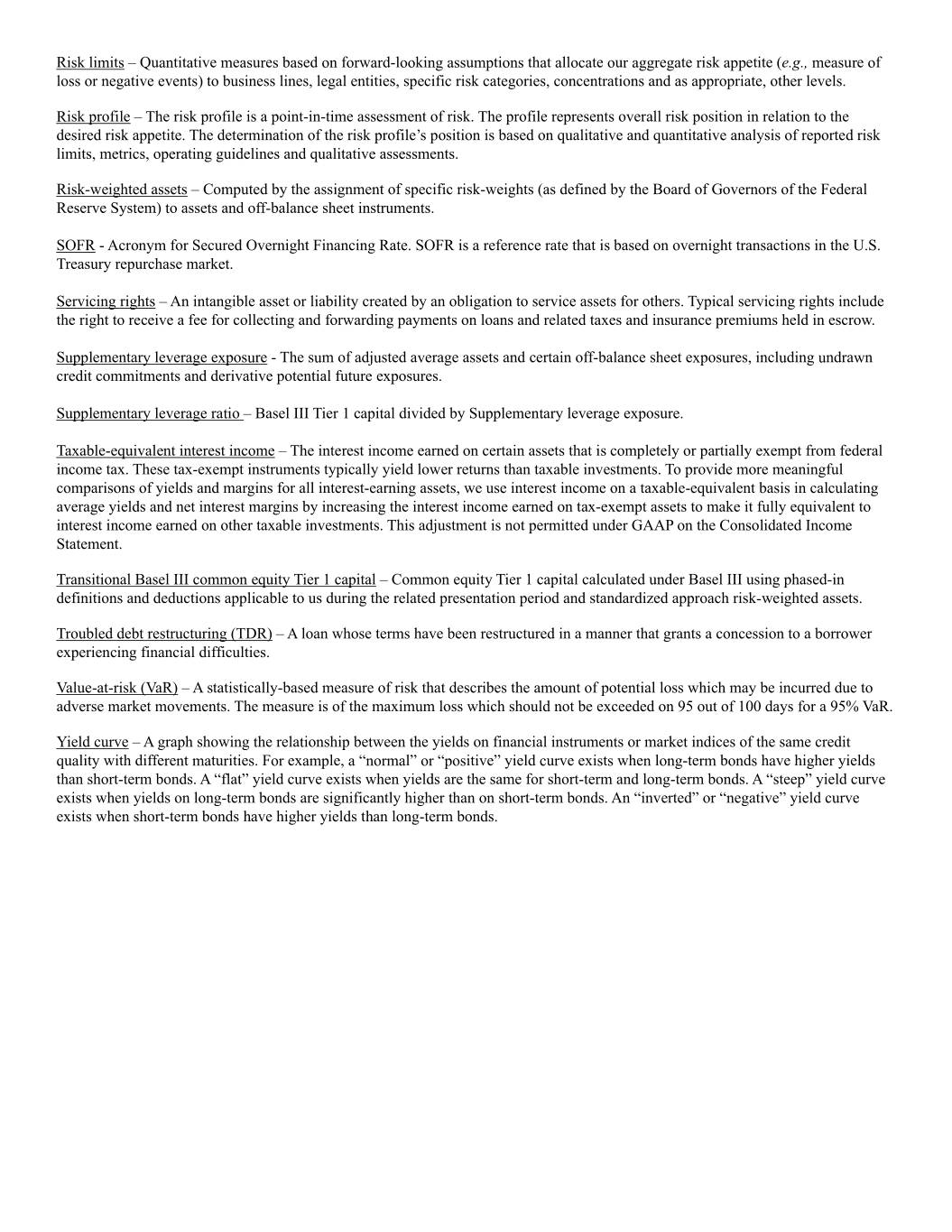
Risk limits – Quantitative measures based on forward-looking assumptions that allocate our aggregate risk appetite (e.g., measure of loss or negative events) to business lines, legal entities, specific risk categories, concentrations and as appropriate, other levels. Risk profile – The risk profile is a point-in-time assessment of risk. The profile represents overall risk position in relation to the desired risk appetite. The determination of the risk profile’s position is based on qualitative and quantitative analysis of reported risk limits, metrics, operating guidelines and qualitative assessments. Risk-weighted assets – Computed by the assignment of specific risk-weights (as defined by the Board of Governors of the Federal Reserve System) to assets and off-balance sheet instruments. SOFR - Acronym for Secured Overnight Financing Rate. SOFR is a reference rate that is based on overnight transactions in the U.S. Treasury repurchase market. Servicing rights – An intangible asset or liability created by an obligation to service assets for others. Typical servicing rights include the right to receive a fee for collecting and forwarding payments on loans and related taxes and insurance premiums held in escrow. Supplementary leverage exposure - The sum of adjusted average assets and certain off-balance sheet exposures, including undrawn credit commitments and derivative potential future exposures. Supplementary leverage ratio – Basel III Tier 1 capital divided by Supplementary leverage exposure. Taxable-equivalent interest income – The interest income earned on certain assets that is completely or partially exempt from federal income tax. These tax-exempt instruments typically yield lower returns than taxable investments. To provide more meaningful comparisons of yields and margins for all interest-earning assets, we use interest income on a taxable-equivalent basis in calculating average yields and net interest margins by increasing the interest income earned on tax-exempt assets to make it fully equivalent to interest income earned on other taxable investments. This adjustment is not permitted under GAAP on the Consolidated Income Statement. Transitional Basel III common equity Tier 1 capital – Common equity Tier 1 capital calculated under Basel III using phased-in definitions and deductions applicable to us during the related presentation period and standardized approach risk-weighted assets. Troubled debt restructuring (TDR) – A loan whose terms have been restructured in a manner that grants a concession to a borrower experiencing financial difficulties. Value-at-risk (VaR) – A statistically-based measure of risk that describes the amount of potential loss which may be incurred due to adverse market movements. The measure is of the maximum loss which should not be exceeded on 95 out of 100 days for a 95% VaR. Yield curve – A graph showing the relationship between the yields on financial instruments or market indices of the same credit quality with different maturities. For example, a “normal” or “positive” yield curve exists when long-term bonds have higher yields than short-term bonds. A “flat” yield curve exists when yields are the same for short-term and long-term bonds. A “steep” yield curve exists when yields on long-term bonds are significantly higher than on short-term bonds. An “inverted” or “negative” yield curve exists when short-term bonds have higher yields than long-term bonds.
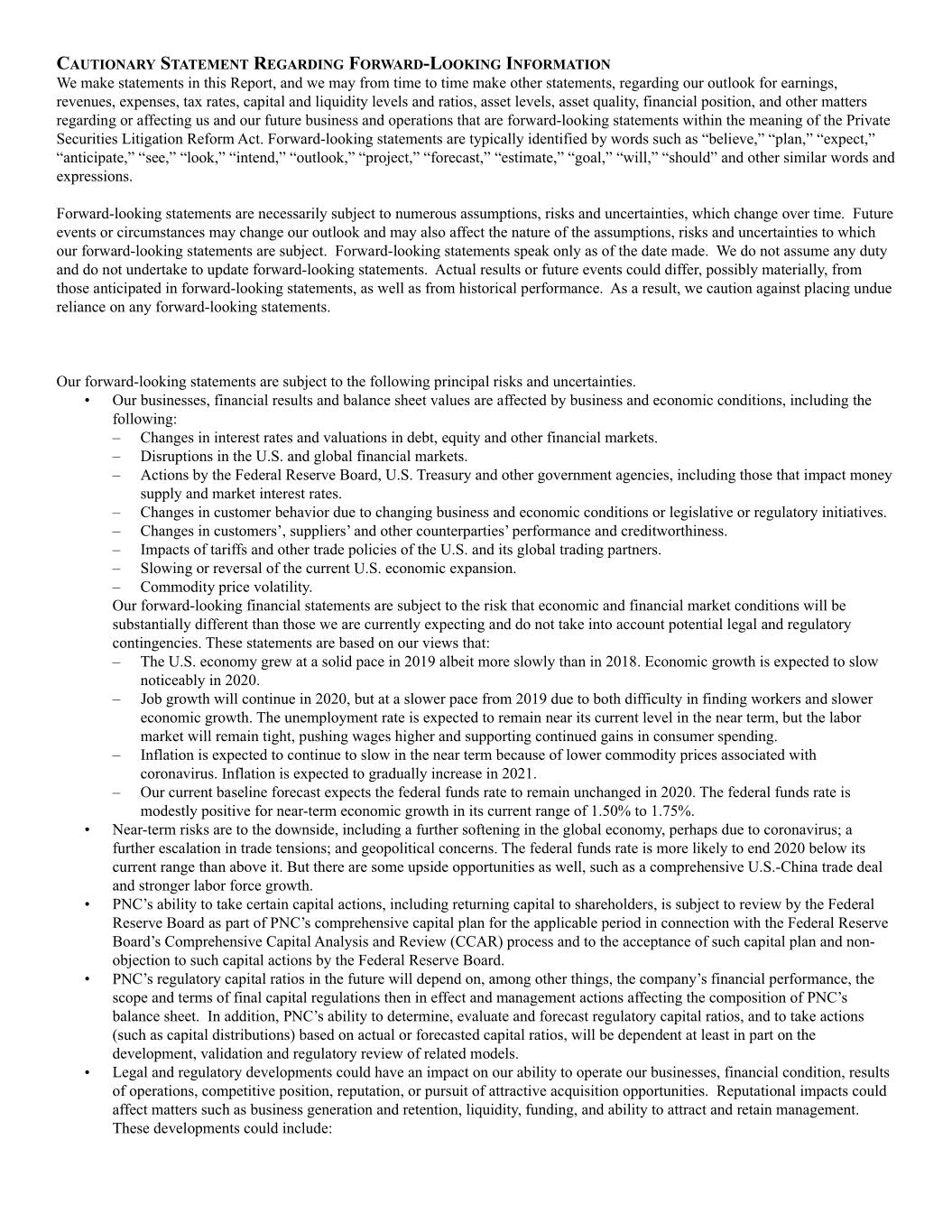
CAUTIONARY STATEMENT REGARDING FORWARD-LOOKING INFORMATION We make statements in this Report, and we may from time to time make other statements, regarding our outlook for earnings, revenues, expenses, tax rates, capital and liquidity levels and ratios, asset levels, asset quality, financial position, and other matters regarding or affecting us and our future business and operations that are forward-looking statements within the meaning of the Private Securities Litigation Reform Act. Forward-looking statements are typically identified by words such as “believe,” “plan,” “expect,” “anticipate,” “see,” “look,” “intend,” “outlook,” “project,” “forecast,” “estimate,” “goal,” “will,” “should” and other similar words and expressions. Forward-looking statements are necessarily subject to numerous assumptions, risks and uncertainties, which change over time. Future events or circumstances may change our outlook and may also affect the nature of the assumptions, risks and uncertainties to which our forward-looking statements are subject. Forward-looking statements speak only as of the date made. We do not assume any duty and do not undertake to update forward-looking statements. Actual results or future events could differ, possibly materially, from those anticipated in forward-looking statements, as well as from historical performance. As a result, we caution against placing undue reliance on any forward-looking statements. Our forward-looking statements are subject to the following principal risks and uncertainties. • Our businesses, financial results and balance sheet values are affected by business and economic conditions, including the following: – Changes in interest rates and valuations in debt, equity and other financial markets. – Disruptions in the U.S. and global financial markets. – Actions by the Federal Reserve Board, U.S. Treasury and other government agencies, including those that impact money supply and market interest rates. – Changes in customer behavior due to changing business and economic conditions or legislative or regulatory initiatives. – Changes in customers’, suppliers’ and other counterparties’ performance and creditworthiness. – Impacts of tariffs and other trade policies of the U.S. and its global trading partners. – Slowing or reversal of the current U.S. economic expansion. – Commodity price volatility. Our forward-looking financial statements are subject to the risk that economic and financial market conditions will be substantially different than those we are currently expecting and do not take into account potential legal and regulatory contingencies. These statements are based on our views that: – The U.S. economy grew at a solid pace in 2019 albeit more slowly than in 2018. Economic growth is expected to slow noticeably in 2020. – Job growth will continue in 2020, but at a slower pace from 2019 due to both difficulty in finding workers and slower economic growth. The unemployment rate is expected to remain near its current level in the near term, but the labor market will remain tight, pushing wages higher and supporting continued gains in consumer spending. – Inflation is expected to continue to slow in the near term because of lower commodity prices associated with coronavirus. Inflation is expected to gradually increase in 2021. – Our current baseline forecast expects the federal funds rate to remain unchanged in 2020. The federal funds rate is modestly positive for near-term economic growth in its current range of 1.50% to 1.75%. • Near-term risks are to the downside, including a further softening in the global economy, perhaps due to coronavirus; a further escalation in trade tensions; and geopolitical concerns. The federal funds rate is more likely to end 2020 below its current range than above it. But there are some upside opportunities as well, such as a comprehensive U.S.-China trade deal and stronger labor force growth. • PNC’s ability to take certain capital actions, including returning capital to shareholders, is subject to review by the Federal Reserve Board as part of PNC’s comprehensive capital plan for the applicable period in connection with the Federal Reserve Board’s Comprehensive Capital Analysis and Review (CCAR) process and to the acceptance of such capital plan and non- objection to such capital actions by the Federal Reserve Board. • PNC’s regulatory capital ratios in the future will depend on, among other things, the company’s financial performance, the scope and terms of final capital regulations then in effect and management actions affecting the composition of PNC’s balance sheet. In addition, PNC’s ability to determine, evaluate and forecast regulatory capital ratios, and to take actions (such as capital distributions) based on actual or forecasted capital ratios, will be dependent at least in part on the development, validation and regulatory review of related models. • Legal and regulatory developments could have an impact on our ability to operate our businesses, financial condition, results of operations, competitive position, reputation, or pursuit of attractive acquisition opportunities. Reputational impacts could affect matters such as business generation and retention, liquidity, funding, and ability to attract and retain management. These developments could include:
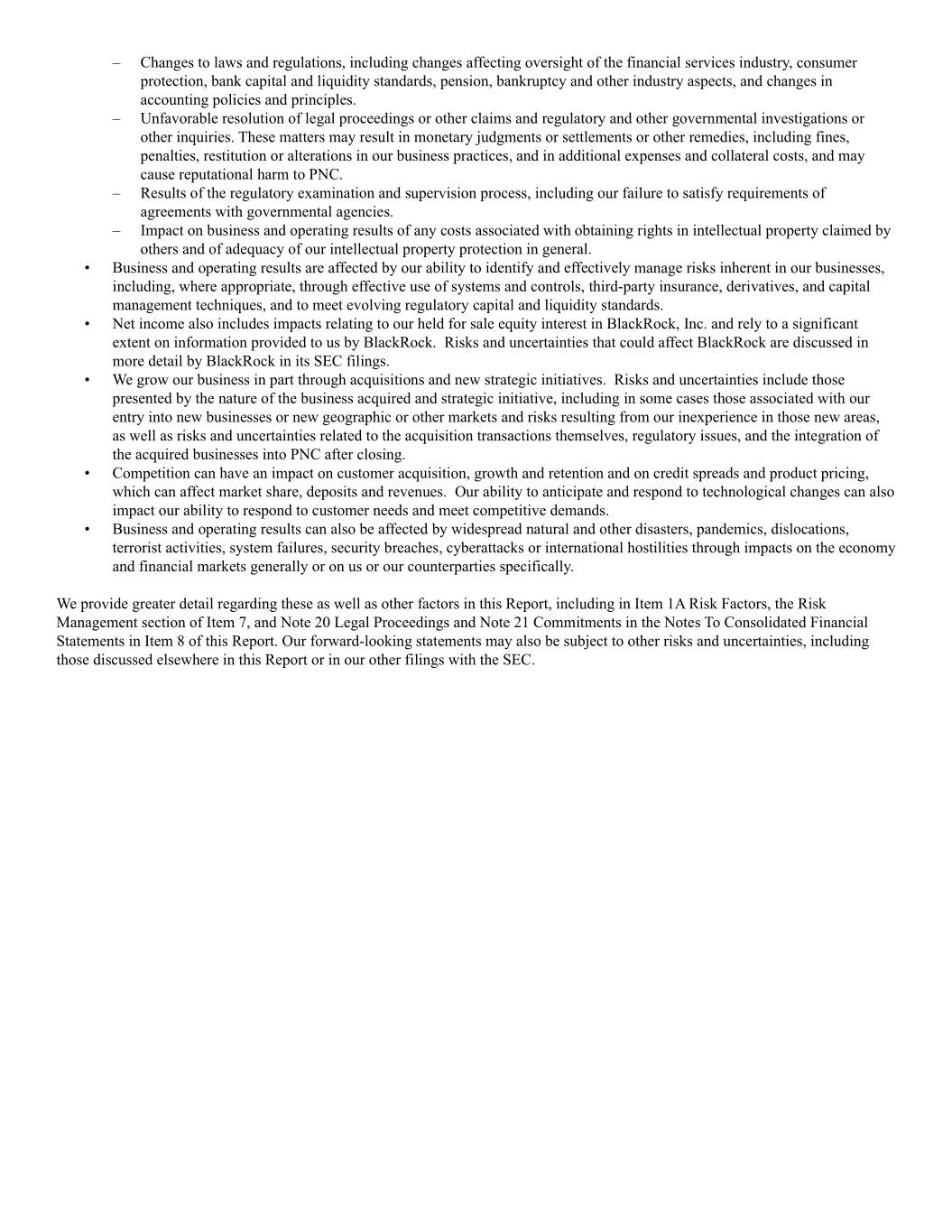
– Changes to laws and regulations, including changes affecting oversight of the financial services industry, consumer protection, bank capital and liquidity standards, pension, bankruptcy and other industry aspects, and changes in accounting policies and principles. – Unfavorable resolution of legal proceedings or other claims and regulatory and other governmental investigations or other inquiries. These matters may result in monetary judgments or settlements or other remedies, including fines, penalties, restitution or alterations in our business practices, and in additional expenses and collateral costs, and may cause reputational harm to PNC. – Results of the regulatory examination and supervision process, including our failure to satisfy requirements of agreements with governmental agencies. – Impact on business and operating results of any costs associated with obtaining rights in intellectual property claimed by others and of adequacy of our intellectual property protection in general. • Business and operating results are affected by our ability to identify and effectively manage risks inherent in our businesses, including, where appropriate, through effective use of systems and controls, third-party insurance, derivatives, and capital management techniques, and to meet evolving regulatory capital and liquidity standards. • Net income also includes impacts relating to our held for sale equity interest in BlackRock, Inc. and rely to a significant extent on information provided to us by BlackRock. Risks and uncertainties that could affect BlackRock are discussed in more detail by BlackRock in its SEC filings. • We grow our business in part through acquisitions and new strategic initiatives. Risks and uncertainties include those presented by the nature of the business acquired and strategic initiative, including in some cases those associated with our entry into new businesses or new geographic or other markets and risks resulting from our inexperience in those new areas, as well as risks and uncertainties related to the acquisition transactions themselves, regulatory issues, and the integration of the acquired businesses into PNC after closing. • Competition can have an impact on customer acquisition, growth and retention and on credit spreads and product pricing, which can affect market share, deposits and revenues. Our ability to anticipate and respond to technological changes can also impact our ability to respond to customer needs and meet competitive demands. • Business and operating results can also be affected by widespread natural and other disasters, pandemics, dislocations, terrorist activities, system failures, security breaches, cyberattacks or international hostilities through impacts on the economy and financial markets generally or on us or our counterparties specifically. We provide greater detail regarding these as well as other factors in this Report, including in Item 1A Risk Factors, the Risk Management section of Item 7, and Note 20 Legal Proceedings and Note 21 Commitments in the Notes To Consolidated Financial Statements in Item 8 of this Report. Our forward-looking statements may also be subject to other risks and uncertainties, including those discussed elsewhere in this Report or in our other filings with the SEC.